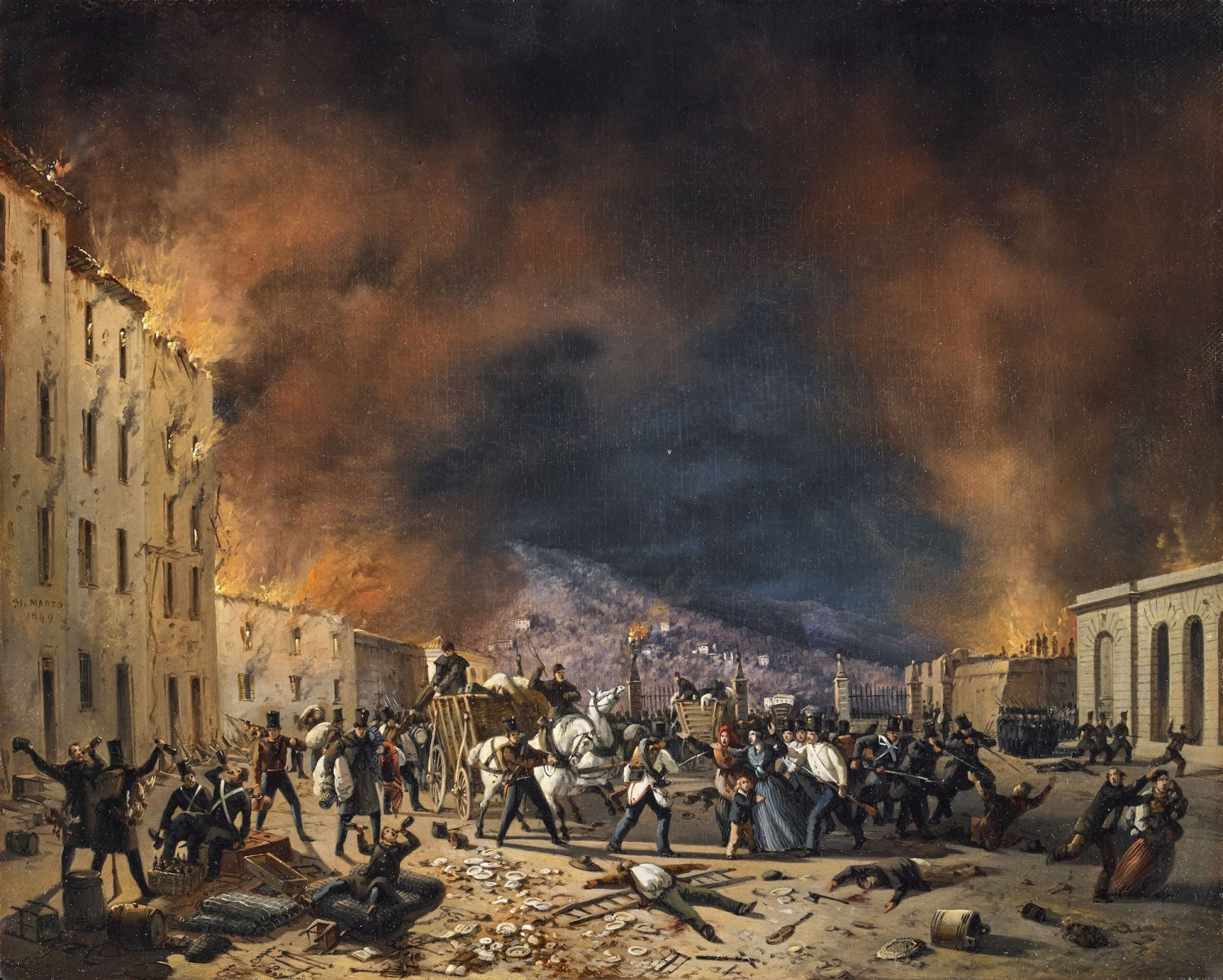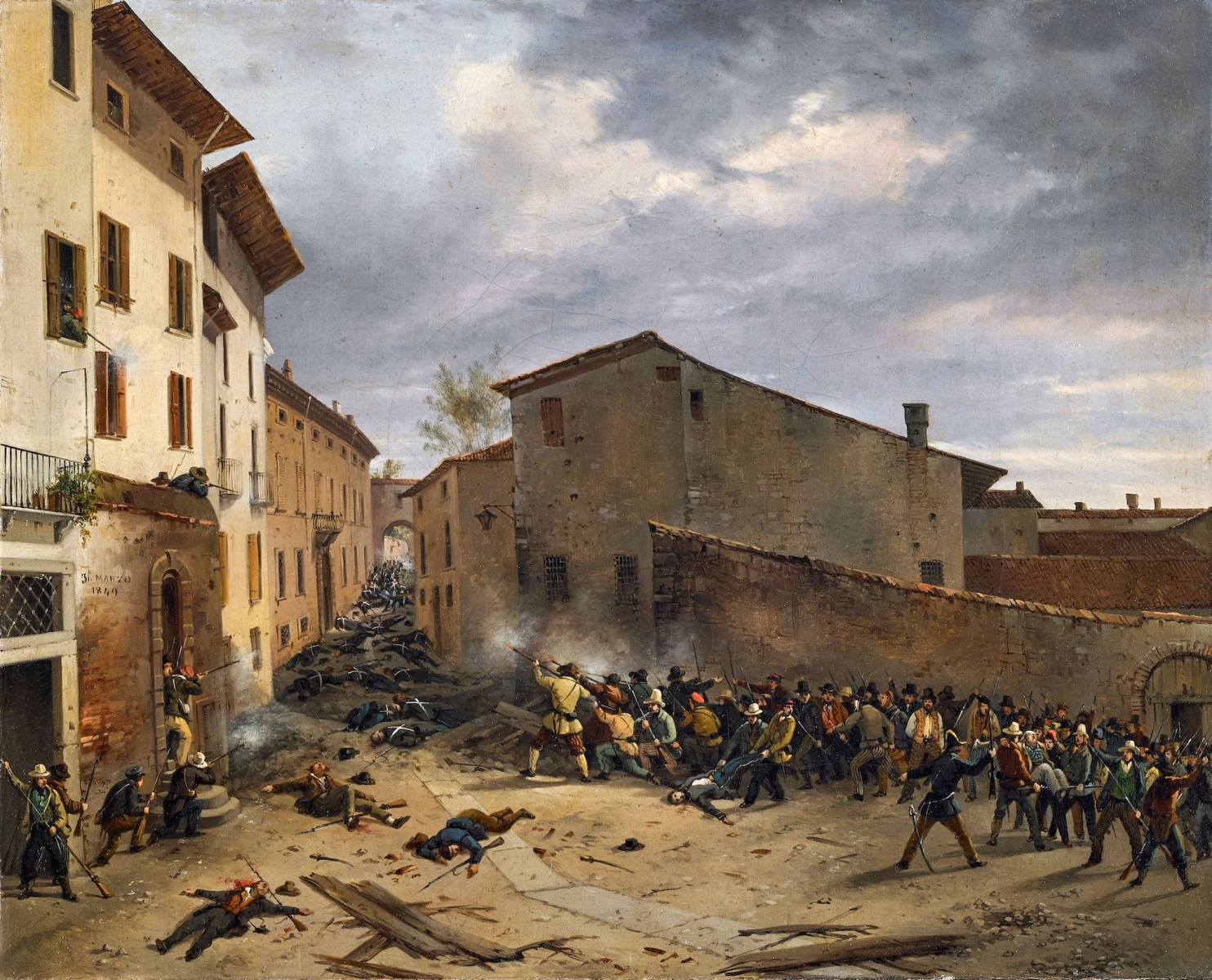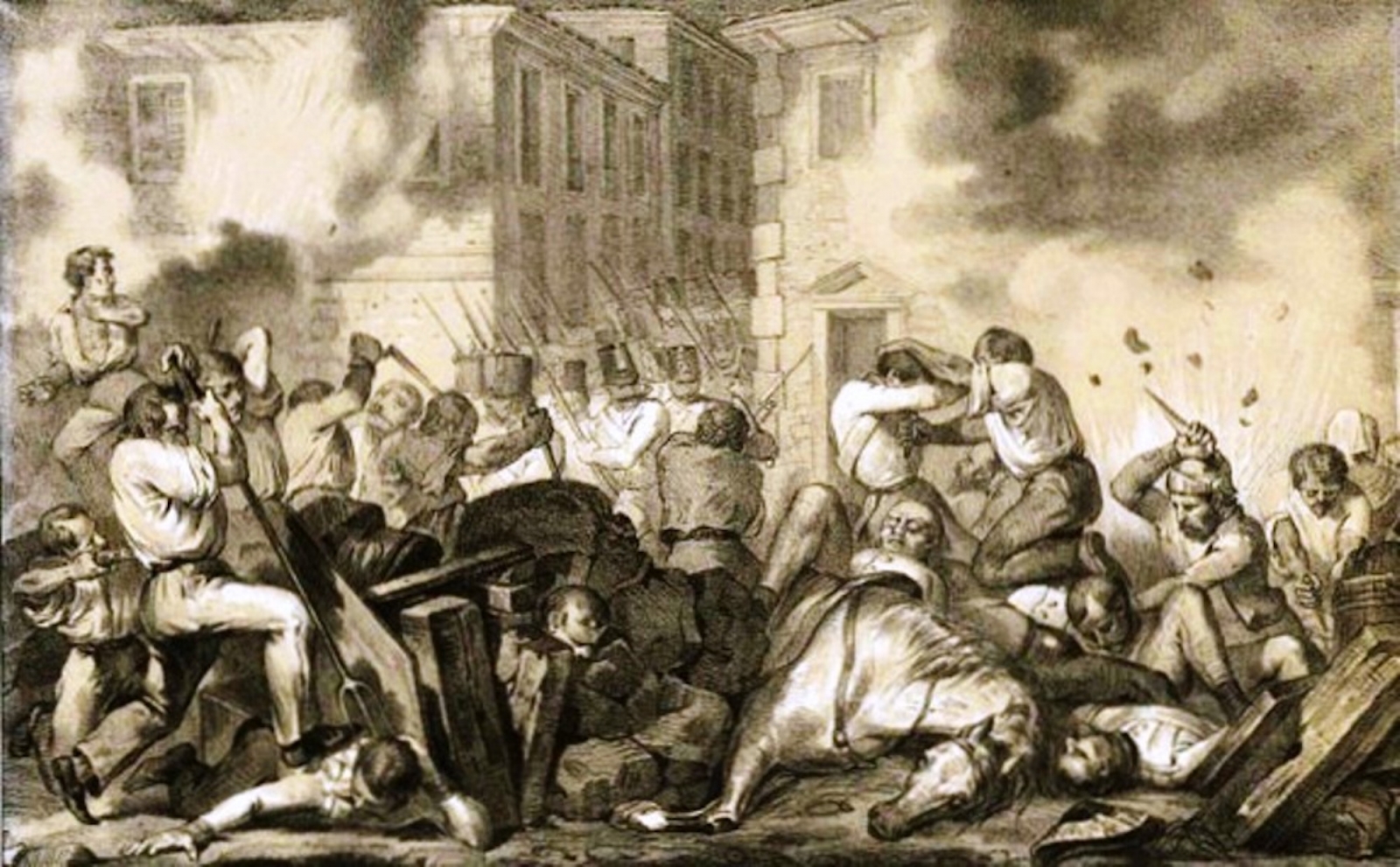Perched atop the hill of Cidneo, one of Brescia's main green areas, the Castle rises above the city's skyline and is visible from all sides when approaching it. The impressive fortress has been restored several times over its centuries-old history, and traces of these reconstructions are visible today. Being built in the Middle Ages and having survived the Napoleonic era and the unification of Italy, the Castle played a significant role in the history of the city of Brescia. At the beginning of the 20th century, it was purchased by the municipality and opened to the public.
Looking for an exciting experience to explore the historic castle of Brescia? Then you will definitely need our team of experienced English-speaking private tour guides in Italy.
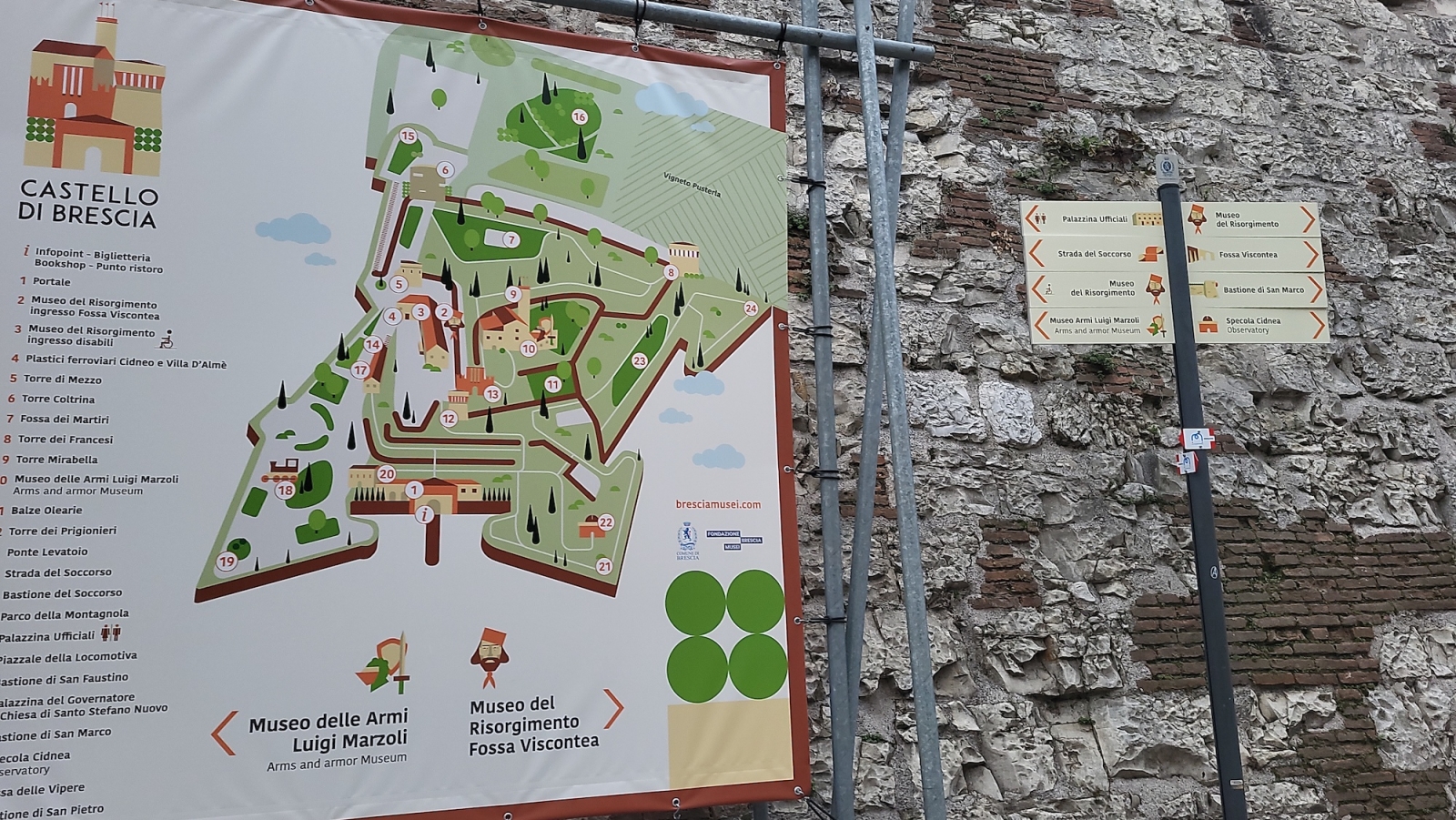
Our local English-speaking tour guides in Brescia have an unrivaled knowledge of the history of the castle and can give you a personalized tour in English into this magnificent fortress, sharing fascinating insights and showing unique historical relics along the way. Discover the castle's rich past through the eyes of our professional tour guides as you explore its ancient walls, secret passages, and towers. Learn about the brave citizens of Brescia who rebelled against Austrian rule during the Ten Days of Brescia, and listen to the documented stories of those who fought and died within these very walls.
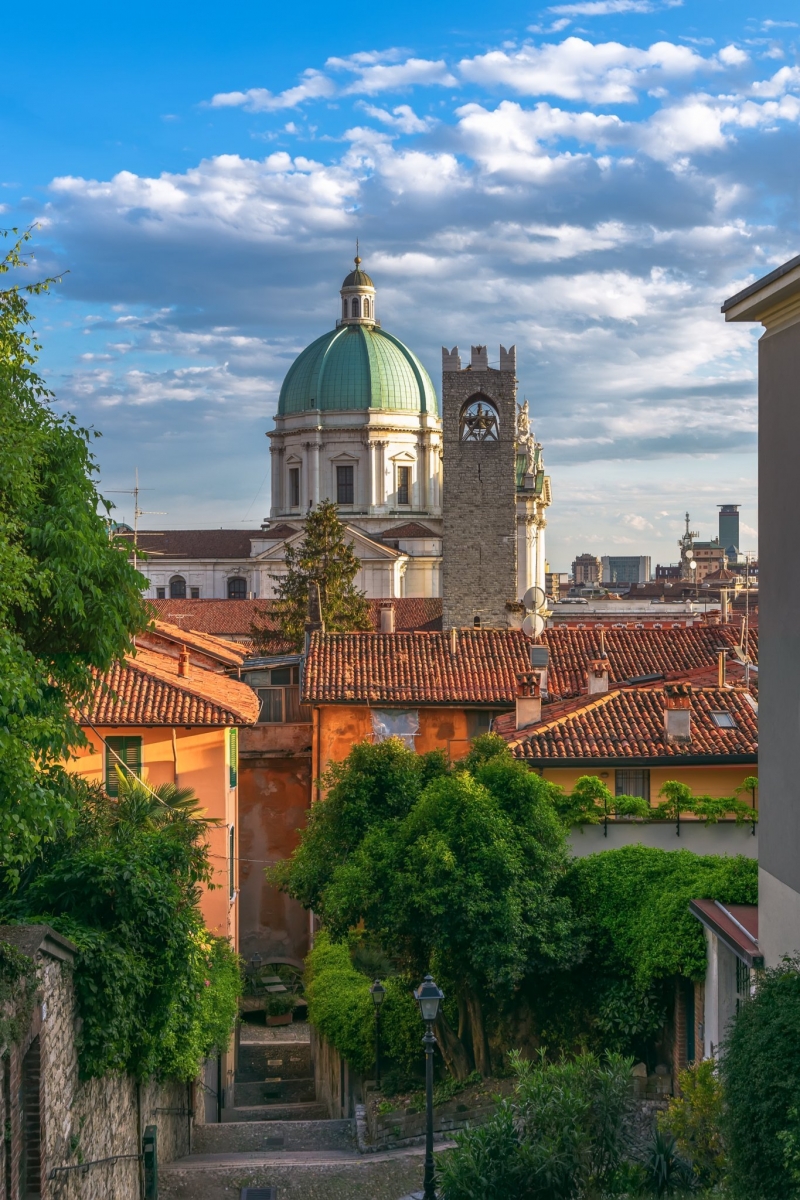
The Cathedral of Santa Maria Assunta and Torre del Pegol are two notable historical buildings in Brescia.
The Cathedral of Santa Maria Assunta, also known as the Brescia Cathedral, is one of the most important religious buildings in Brescia. The construction of the cathedral began in the 11th century and continued until the 19th century. It has a mix of architectural styles, including Romanesque, Gothic, and Baroque, due to the different stages of construction. One of the most significant artworks in the cathedral is the "Crucifixion" by Titian, which is located in the presbytery.
Torre del Pegol, on the other hand, is a medieval tower located in the historic center of Brescia. It was built in the 12th century as a defensive structure and has a unique shape with an irregular hexagonal base. The tower was part of a larger complex that included a castle, but today only the tower remains. Over the centuries, Torre del Pegol has been used for various purposes, including as a prison and a bell tower. Today, it is a popular tourist attraction and offers stunning views of the city from its rooftop terrace.
Both the Cathedral of Santa Maria Assunta and Torre del Pegol are significant historical buildings in Brescia, and they are definitely worth visiting for anyone interested in architecture and history.
Whether you are a history buff or just looking for a unique adventure, our private English-speaking tour guides in Brescia will offer you an unforgettable journey through time. Book a private tour today and discover the magic of Brescia Castle with our experienced local tour guides.
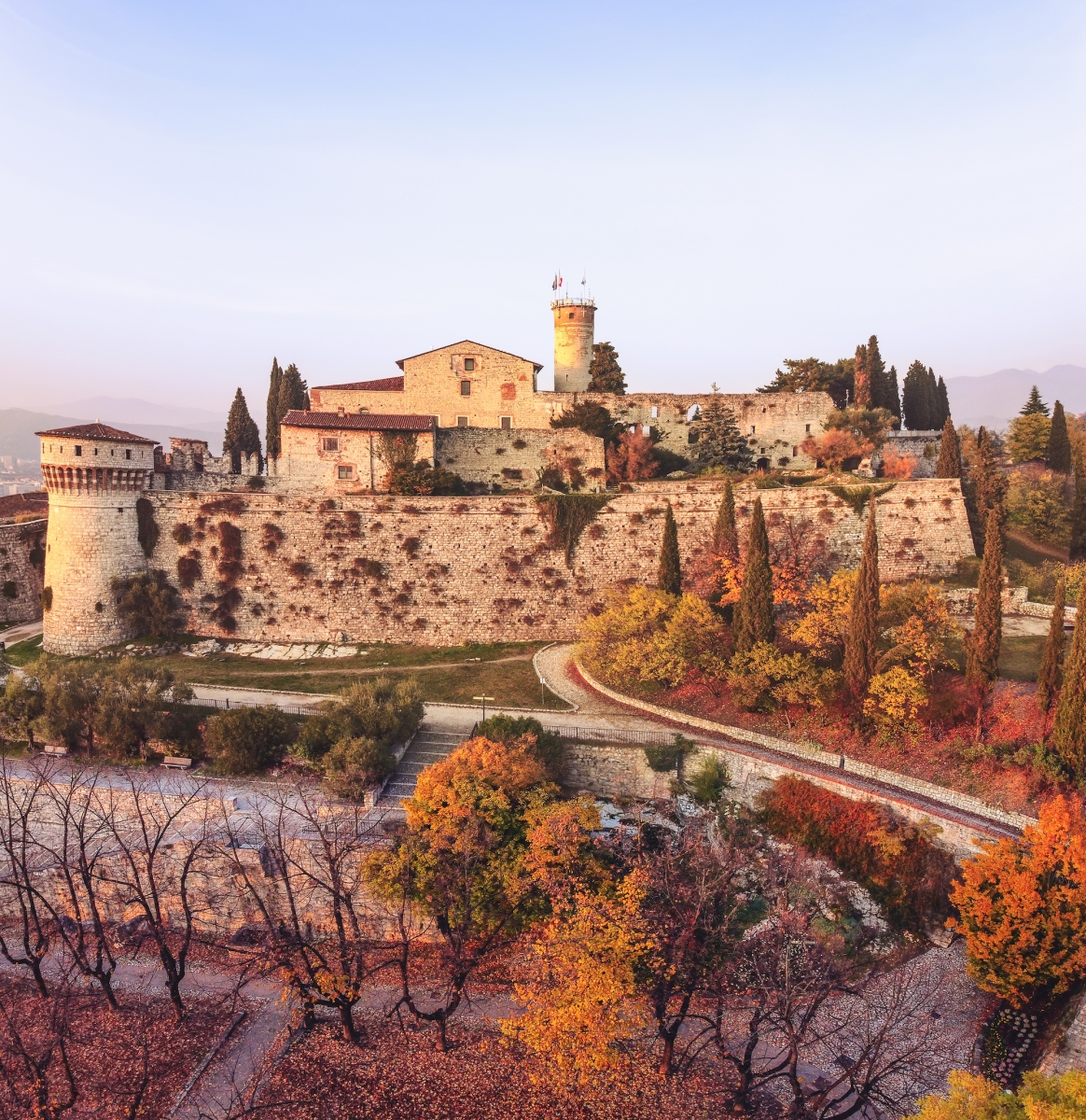
Inside the castle, visitors can explore the intricate network of alleyways and hidden halls, as well as the city's oldest and most respected vineyard just below the castle's high walls, on its eastern side. The castle also houses the Luigi Marzoli Arms Museum and the Risorgimento Museum dedicated to the unification of Italy.
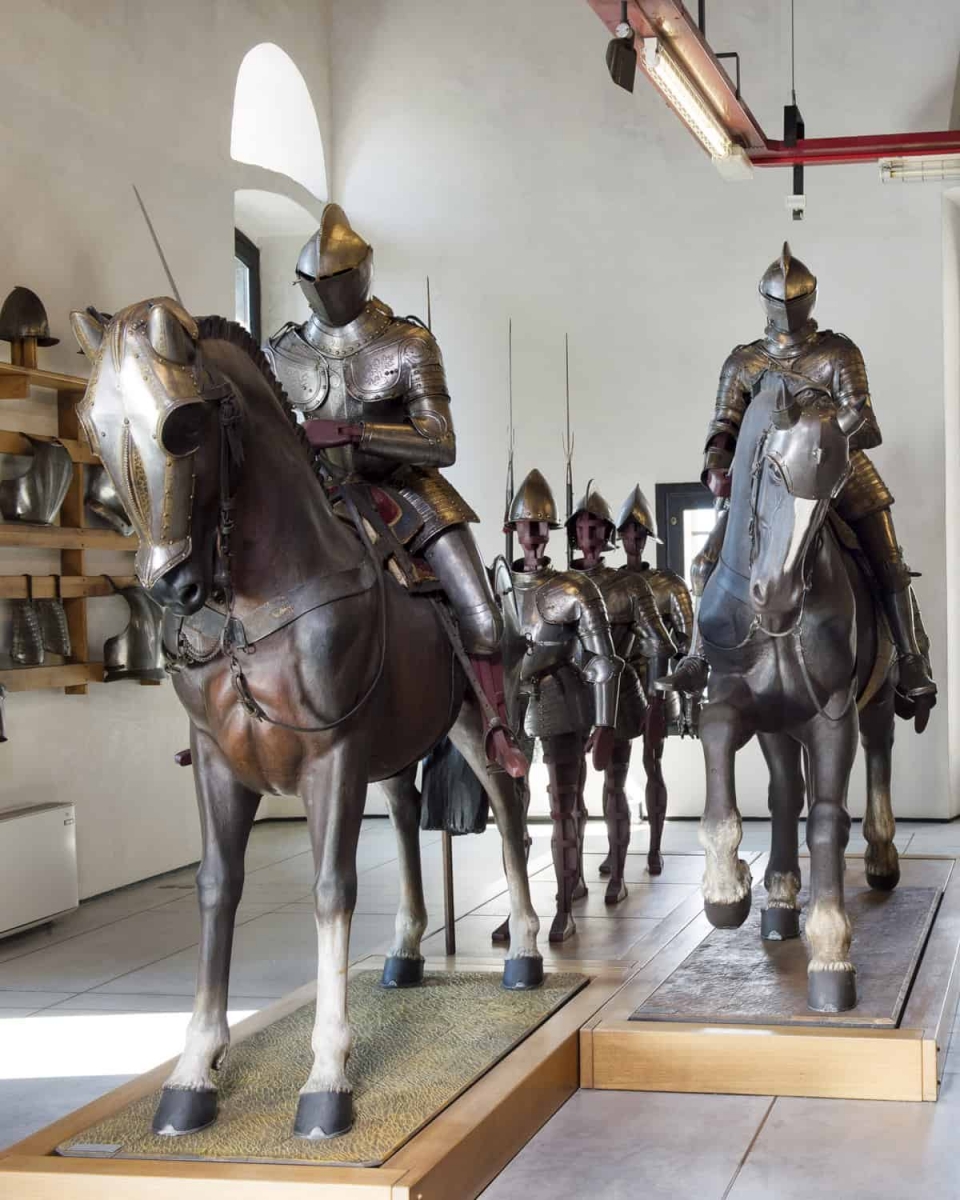
Brescia Castle, known as Falcone of Italy, is a fortress built during the Middle Ages on the hill of Cidneo near the historic center of the city. The hill is located to the north of the city and connects with the nearby hill known as Ronchi, passing into the Brescian Prealps in the east.
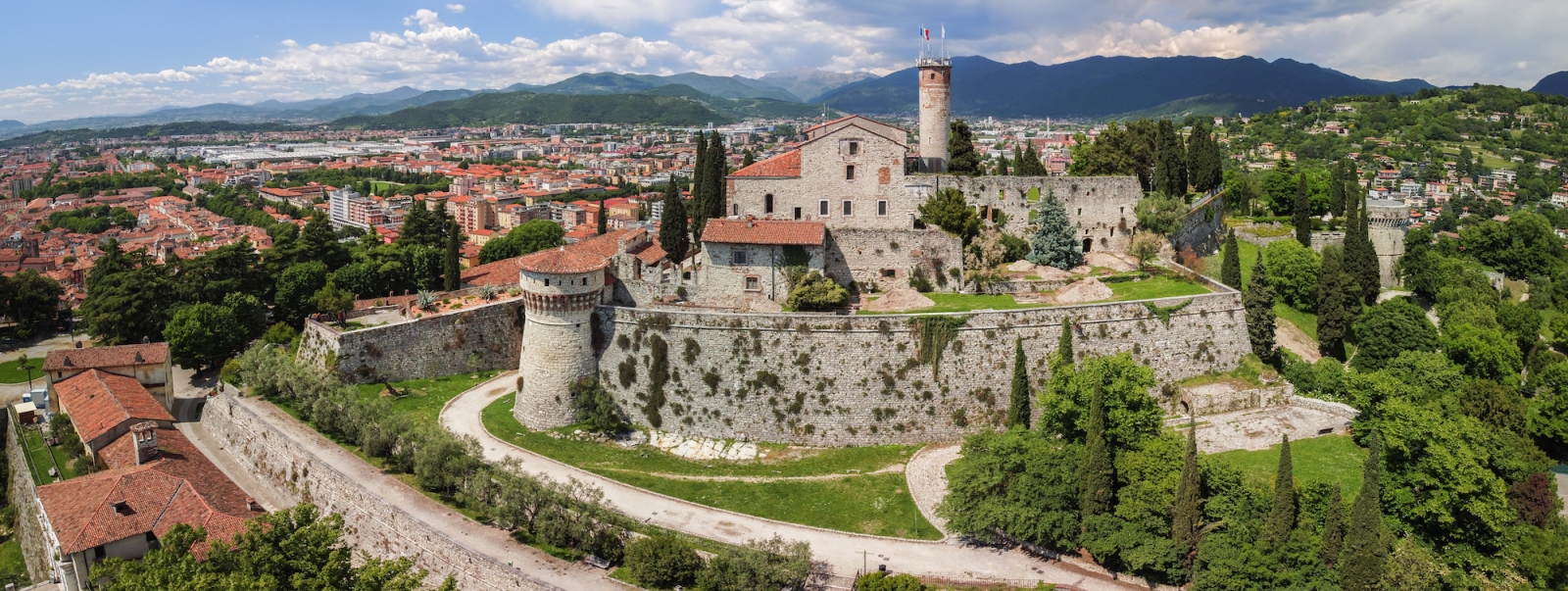
The first settlements on the hill date back to the 9th century BC, and the Romans added them to the city walls at the end of the 1st century BC. The construction of the castle itself began in the 13th century and was completed in the 16th century. Until the second half of the 16th century, the hill was part of Mount Maddalena. During this period, a defensive sheer wall was built to prevent attacks that could threaten the castle and place it in a state of siege. The erected wall effectively separated this part of Mount Maddalena, creating a hill and the modern Via Filippo Turati.
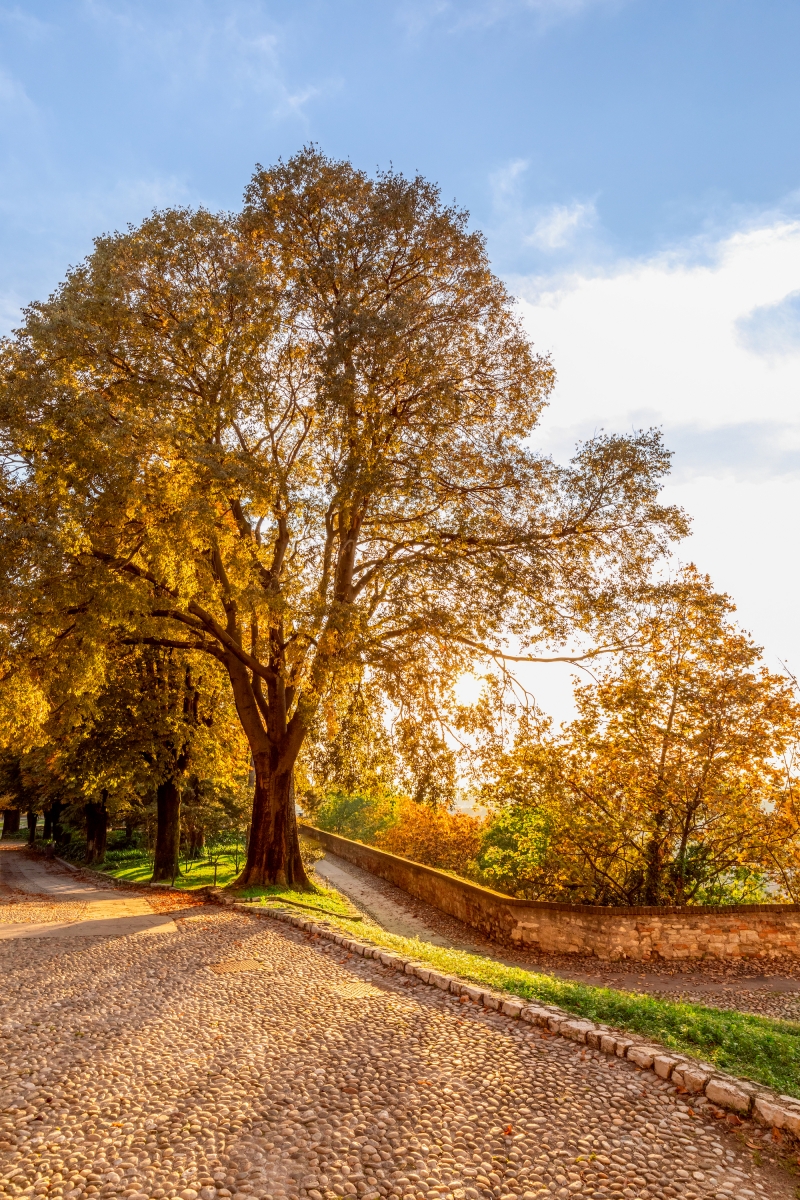
About Brescia
Brescia is an Italian city of about 2,000,000 people, the capital of the province of the same name in Lombardy. It is the second most populous municipality in the region after Milan and is one of the twenty most populous cities in Italy. With a history of over 3200 years, Brescia has a renowned artistic and architectural heritage. Its Roman and Longobard monuments have been listed as a UNESCO World Heritage Site. The city is known for its active industrial production, metalworking, textile, chemical, and food industries, which makes it one of the most important economic centers of Italy. It is also famous for its vintage car racing called Mille Miglia and for the production of the world-famous Franciacorta wine.
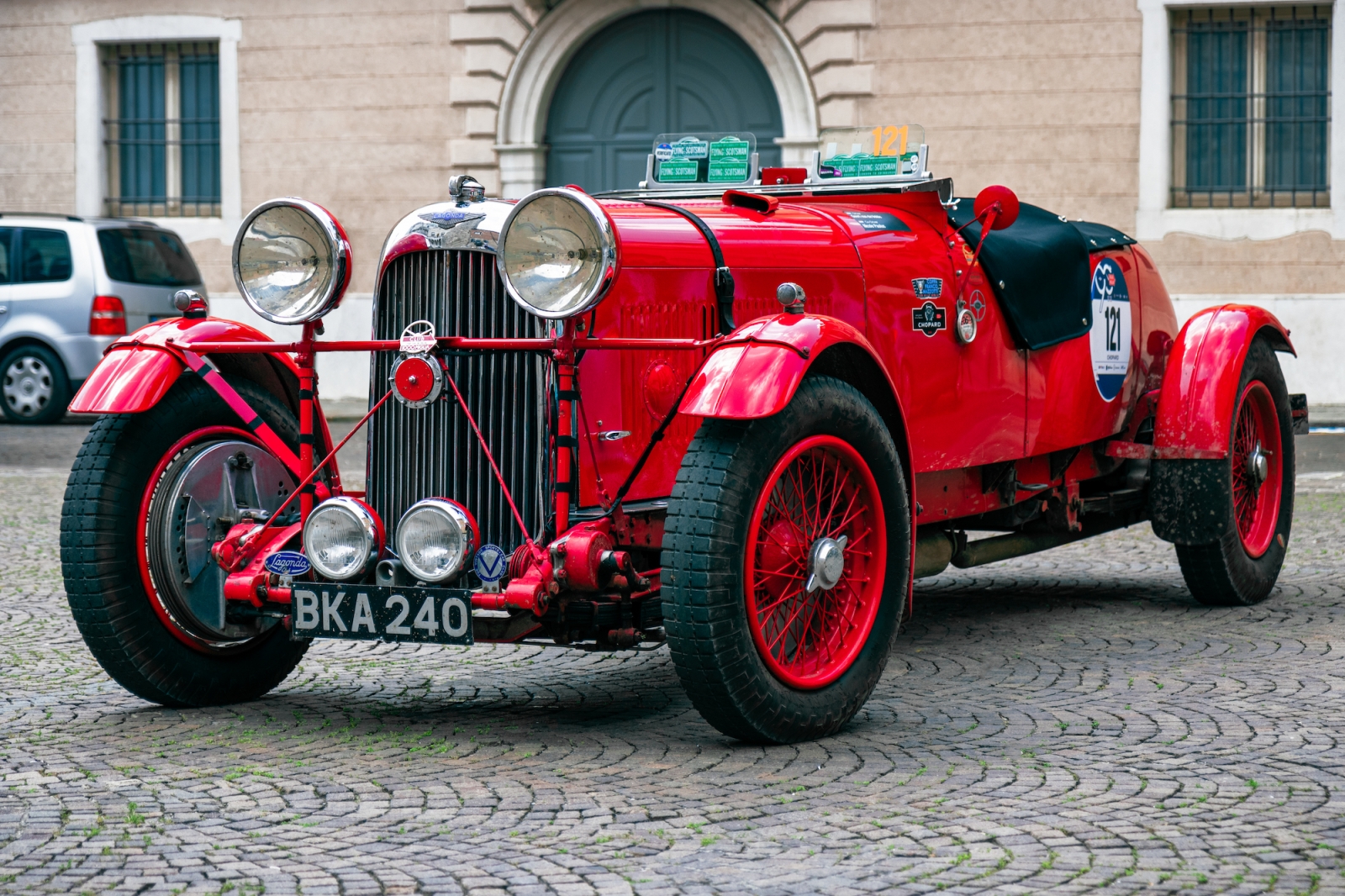
Brescia was nicknamed "The Lioness" because of her bravery and loyalty to the Republic of Venice. In 1438, the Venetian Senate proclaimed Brescia "Lioness and worthy wife of the Lion" and gave her the title "Brixia Fidelis fidei et Iustitiae", which is proudly depicted on the facade of the Palazzo della Loggia.
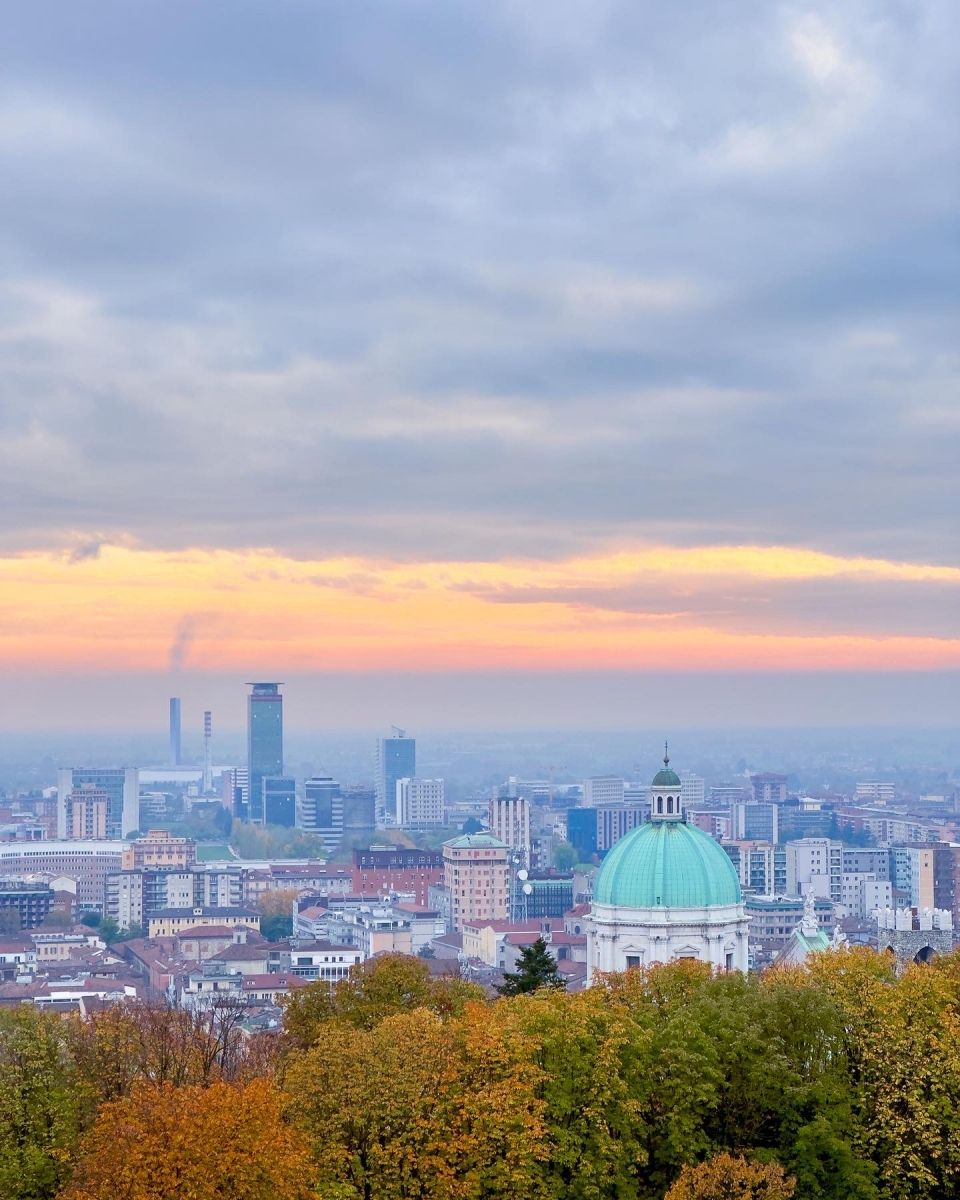
History of Brescia Castle
Roman era
During the Bronze Age, the first settlers came to Cidneo Hill, and that was almost 3,000 years ago. It was during this ancient time that a small temple dedicated to the Celtic deity Bergimus was built. But only when the Romans came to this land, the real history of this fortress began.
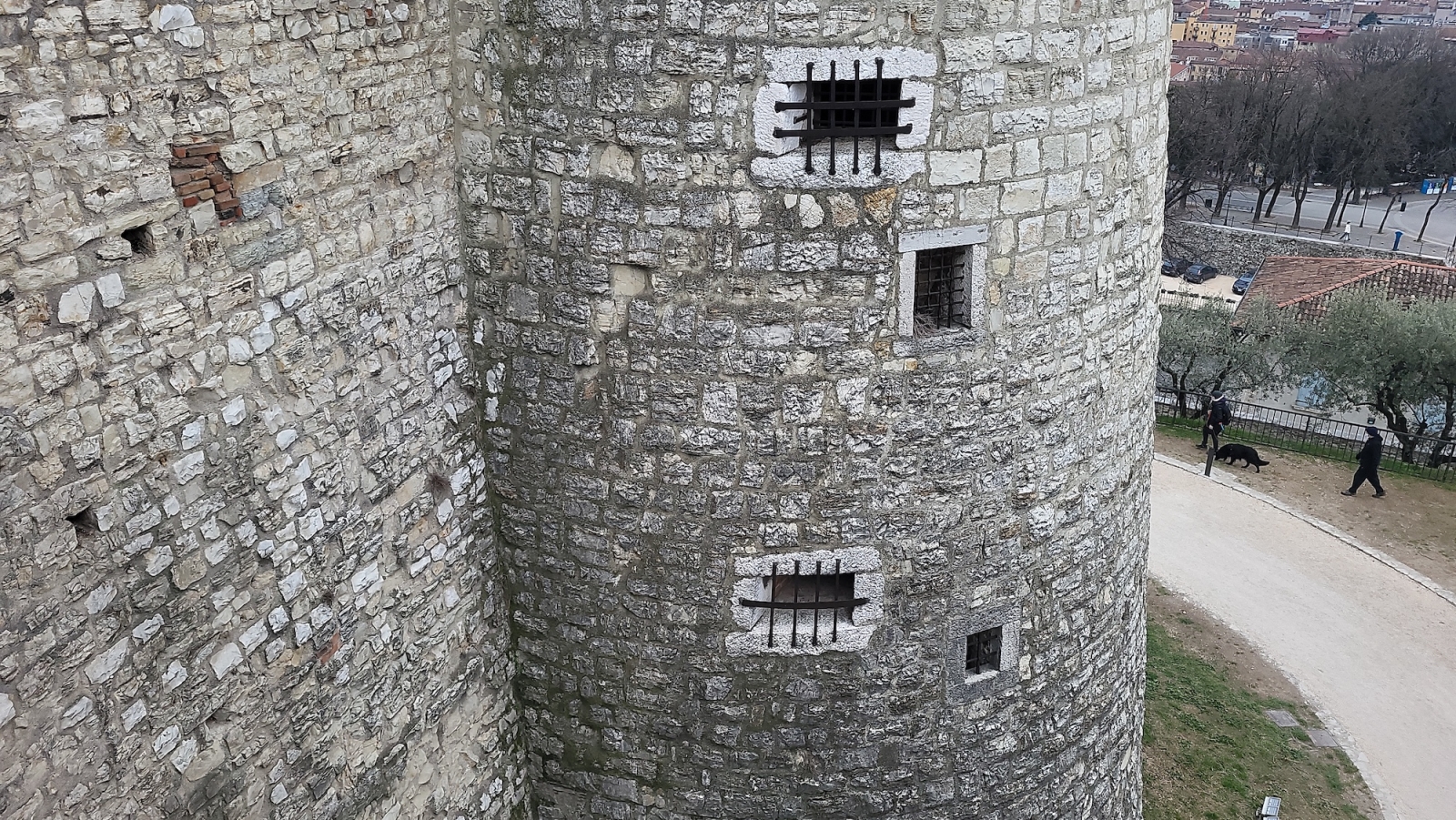
The Romans, with their great power and knowledge, reorganized the hill at the end of the 1st century BC and incorporated its perimeter into the city walls. It was thanks to them that in the 1st century AD, a great temple was erected, which was said to be as large as the Visconti fortress. Ancient retaining walls and the foundations of the stairs in the area can still be seen, testifying to the power of the Romans. Today, only one of the two façade towers remains of that ancient basilica, known as the Mirabella Tower, probably built in turn on a Roman-era tower.
As Christianity began to take root, the Cidneo area became more and more sacred, several religious buildings were built here at once, and numerous fairs were also held.
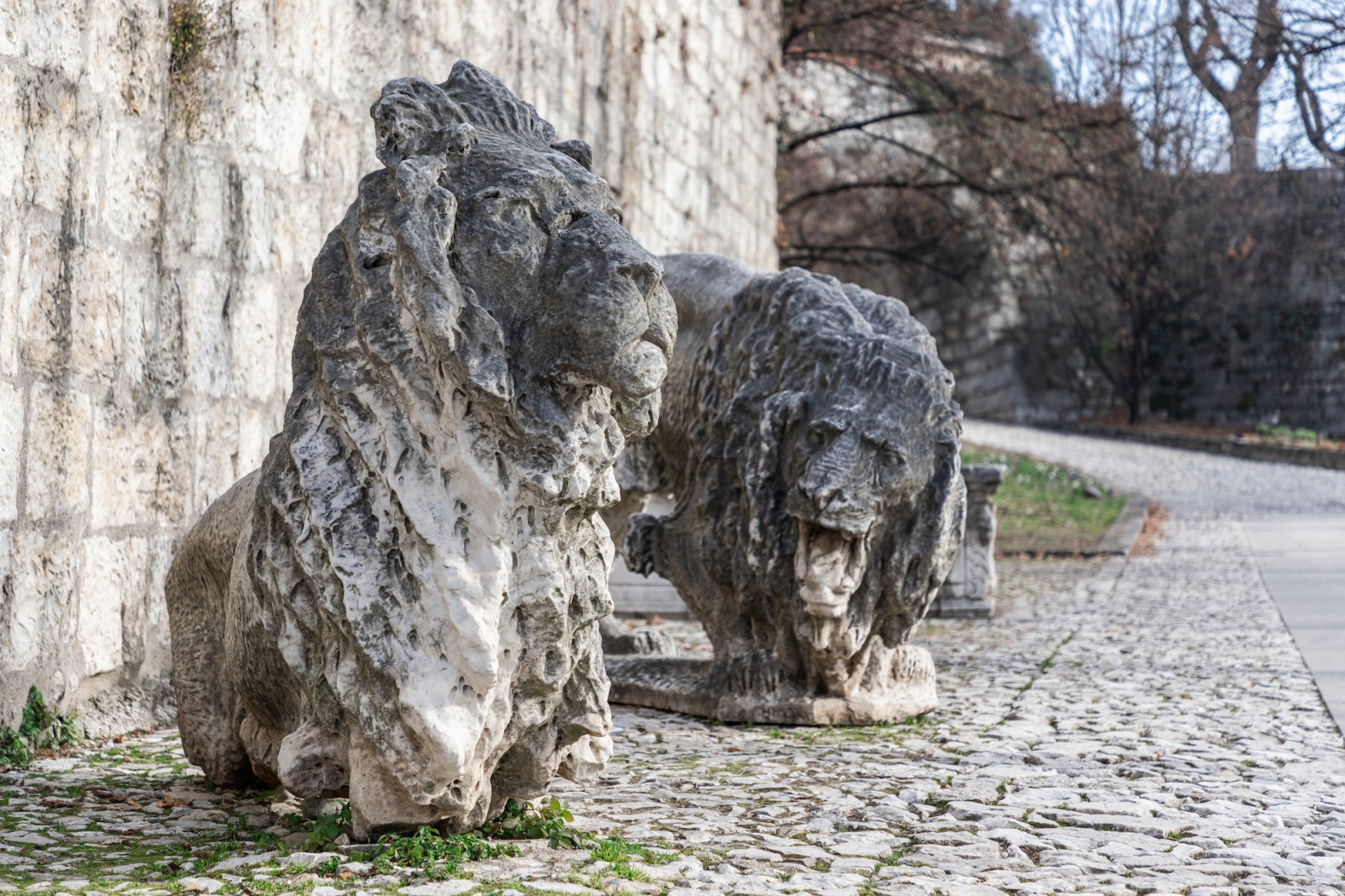
In the early Middle Ages, this area was forgotten for some time, and little information about it has been preserved. But since the year 1000, documentary sources began to accumulate, and the history of this land began to appear again. Between 1237 and 1254, the walls of the fortress were expanded, which gave the city of Brescia, which stood on this land, a look that remained unchanged until the end of the 19th century.
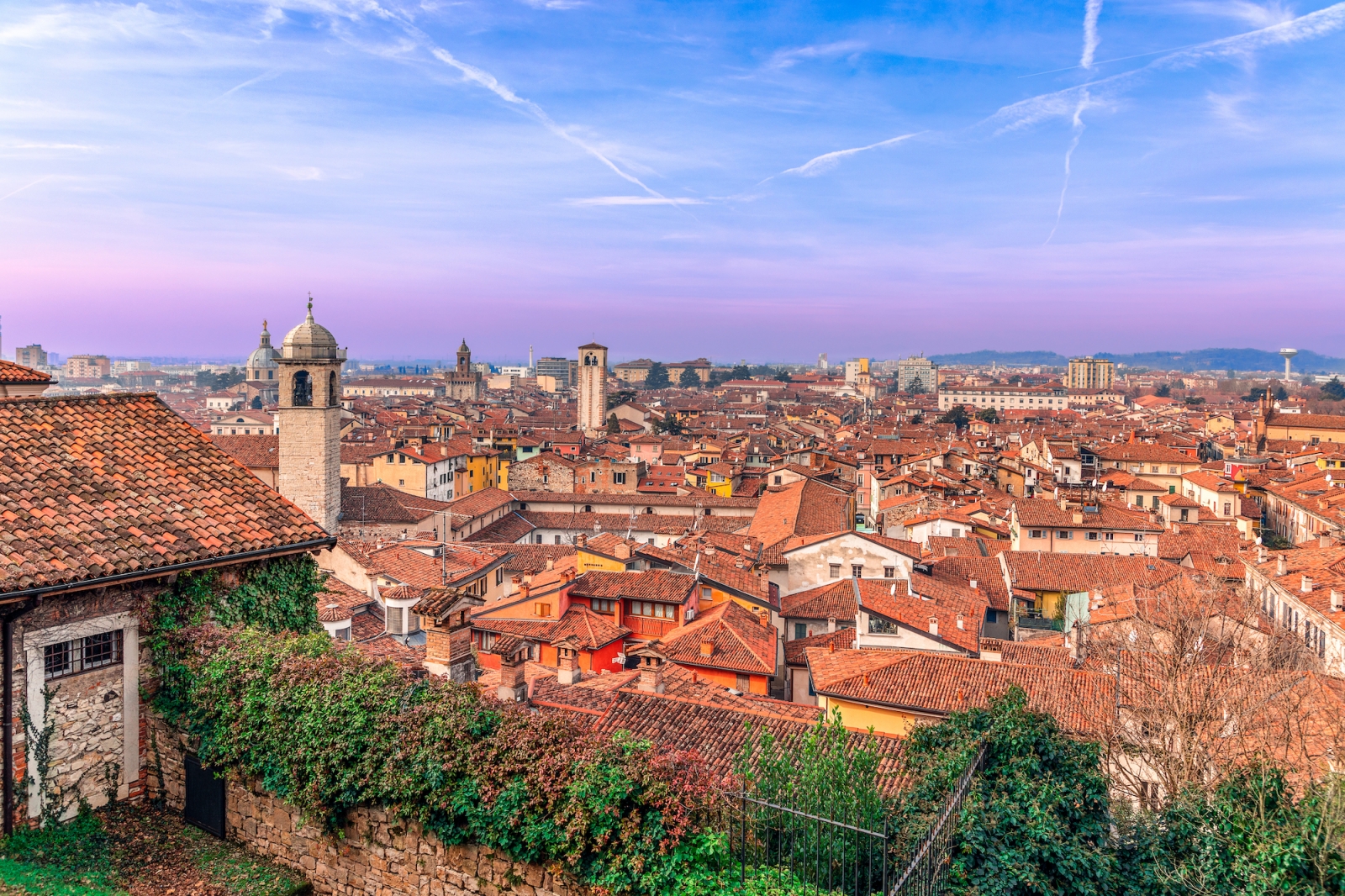
Under the rule of the Visconti, massive restoration work was carried out in the defensive system of the city, culminating in the birth of the New Citadel in 1337. It included the buildings of the ecclesiastical and civil authorities of the city, such as the Broletto and the cathedrals inside the Castle. The only remaining evidence of this extensive restoration work is the building, which was conceived as the residence of the captain of the garrison, with rooms decorated with polychrome mosaics, as well as geometric and floral designs, which are only partially preserved.
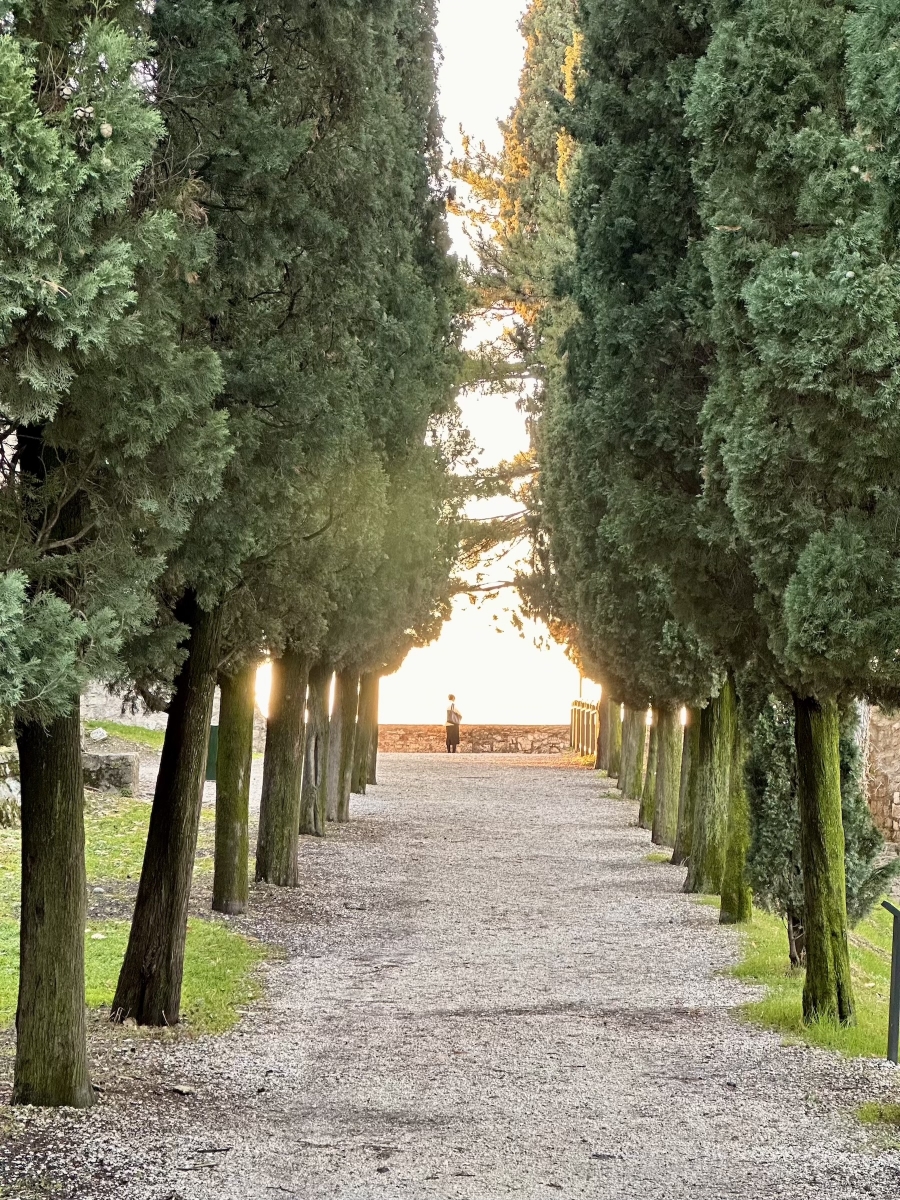
During the same period, the fortress was surrounded by a defensive system consisting of six towers, covered walkways, and drawbridges. The Strada del Soccorso was laid out and then widened in the 16th century as an escape route to the north, often used by adversaries in later centuries.
In 1426, Brescia was conquered by the Venetian Republic, which was determined to fortify the city after the damage done in the war against the Milanese. The Venetians took decisive action, completely rebuilding the city walls in 1466. The walls were built to the bottom, to the foot of the hill, and surrounded by earthen ramparts and ditches. The castle remained largely intact during these renovations, with the exception of the towers, which were rebuilt from square to round. Unfortunately, only one tower from the northern perimeter survived from that period.
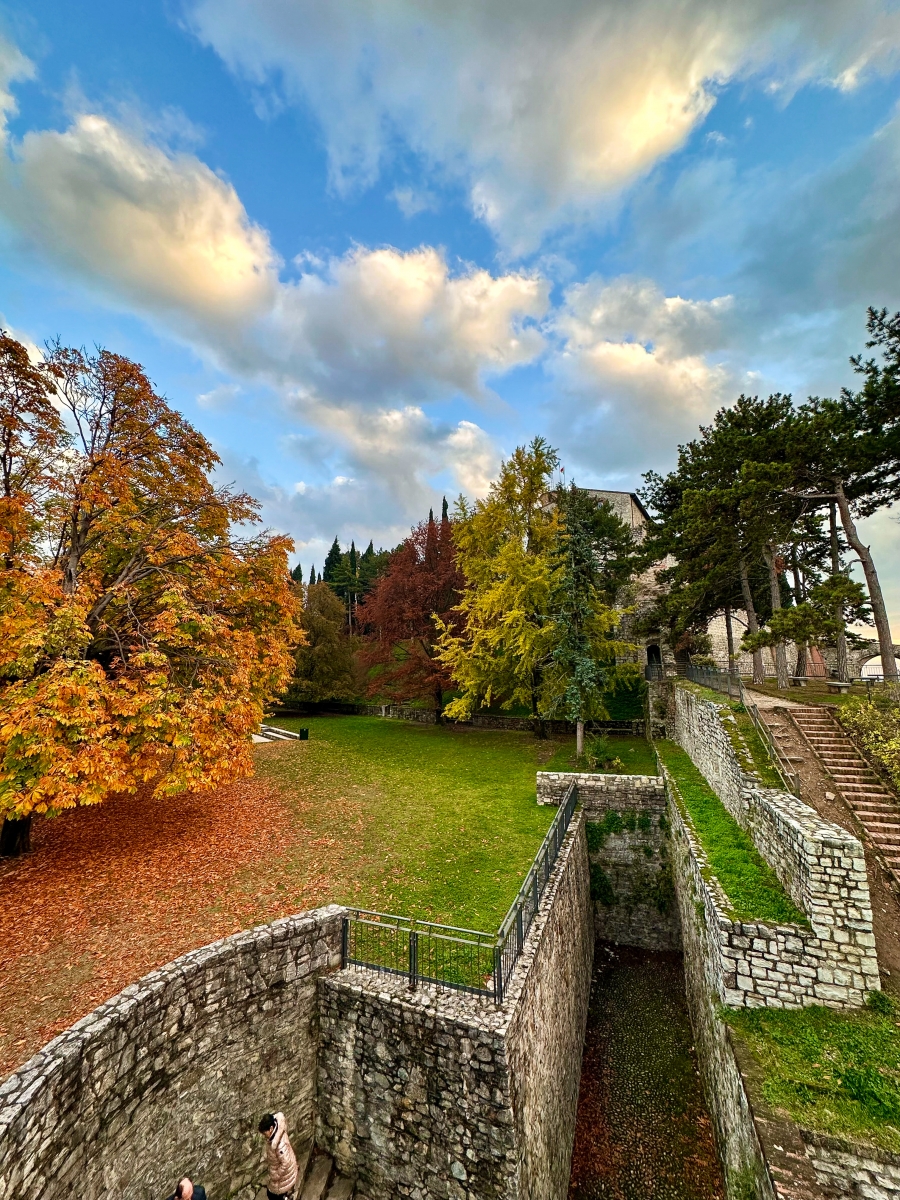
Fast forward to 1509 when the French army captured Brescia and its Castle from the Venetians. The French saw the potential of the castle and undertook new work to expand and strengthen its walls. However, the cost of these improvements was high, and so the nearby convent of San Martino was demolished to make way for the walls, which were never completed.
At this time, Brescia found itself in the center of a violent conflict between the French and the Venetians, who sought to return it to their possession. The darkest period of the city followed, marked by the siege of the fortress when the soldiers of the belligerents fell upon the city in a furious frenzy. The tragic climax came on February 19, when the city was completely sacked by soldiers.
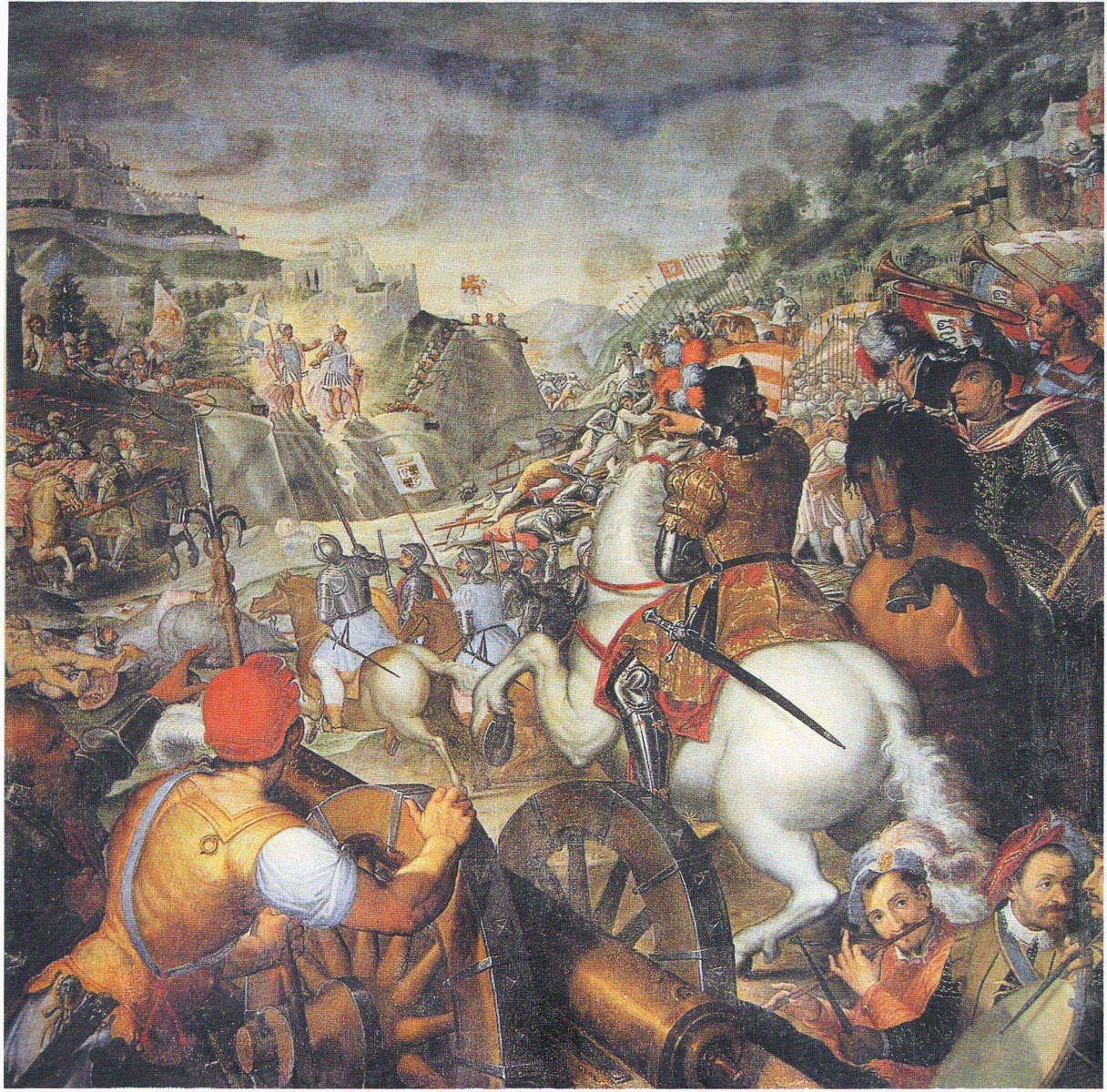
Modern era
In the second half of the 16th century, after the Venetians regained control of Brescia, they proceeded to further improve the fortress. They extended the Strada del Soccorso and added the bastions of San Pietro, San Marco, San Faustino, and della Pusterla. They also equipped the fortress with facilities for storing supplies, barracks, cisterns, and gunpowder stores. Despite these improvements, the strategic function of the fortress came to an end as the line of conflict shifted to Adda and the fortress fell into disrepair. At that time, the Castle was not subjected to more significant changes.
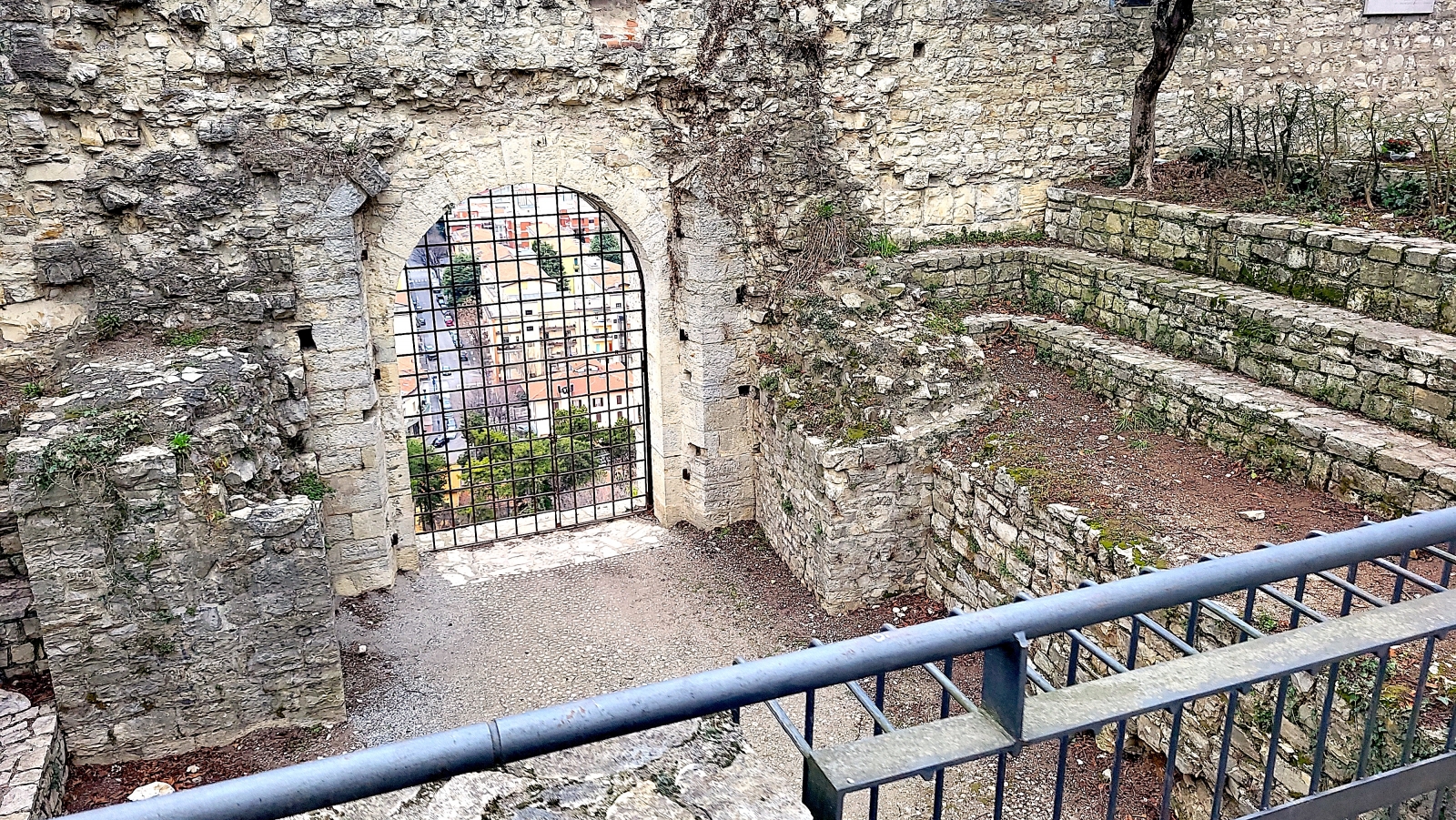
When the French took control of the Castle in the early 19th century, it fell into disrepair, serving as a simple prison and barracks. This fate continued under the Austrians, who also used the Castle for similar purposes. Despite this, the Castle remained a formidable stronghold for defense. In 1849, during the “Ten Days Uprising of Brescia”, the inhabitants of Brescia revolted against the Austrian garrison. This was in response to the refusal of the Austrians to support the imperial royal government during the first war of independence, which made Brescia feel unsupported and betrayed. Unlike other cities, there were no open uprisings in Brescia, only small riots. In the end, the Austro-Hungarian troops retook the city thanks to the support of General Julius Jakob von Hainau, who entered the fortress along the Strada del Soccorso.
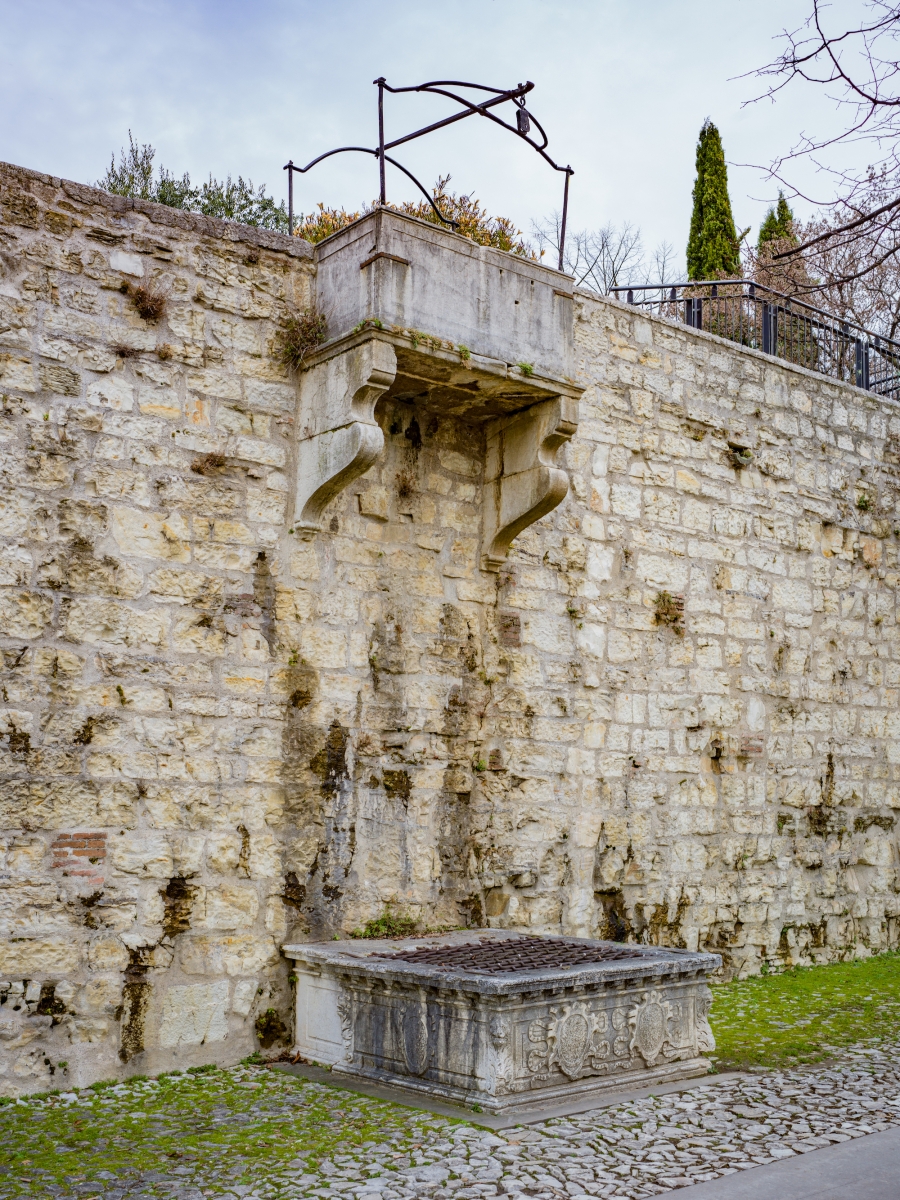
Cisterna nel Castello di Brescia, also known as the Cistern in the Castle of Brescia, is an ancient underground water cistern located within the walls of Brescia Castle in the Lombardy region of northern Italy. The cistern is believed to have been built during the 11th century by the Lombard League, a confederation of northern Italian city-states, to serve as a reservoir for the castle's water supply. It consists of a large rectangular chamber, measuring about 35 meters in length and 20 meters in width, with a vaulted ceiling supported by rows of columns. The cistern could hold up to 550,000 liters of water. Over the centuries, the cistern fell into disuse and was largely forgotten until it was rediscovered during the restoration of the castle in the 1990s. Today, it is open to visitors who can descend into the underground chamber and explore its mysterious atmosphere. The cistern has also been used as a venue for cultural events, including concerts and exhibitions. The Cisterna nel Castello di Brescia is considered one of the most important and impressive examples of medieval hydraulic engineering in northern Italy. It is also a fascinating historical monument that provides a glimpse into the daily life of the people who lived and worked in Brescia Castle centuries ago.
Contemporary era
After the turbulent Second Italian War of Independence in 1859, Brescia Castle took on a new identity as a military prison, its glory days seemingly behind it. However, hope was not lost as the municipality intervened and bought the hill with the aim of restoring the fortress to its former glory. Since then, the Castle has undergone a grandiose transformation, and soon it turned into a recreation center and a fascinating place for public events in Brescia.
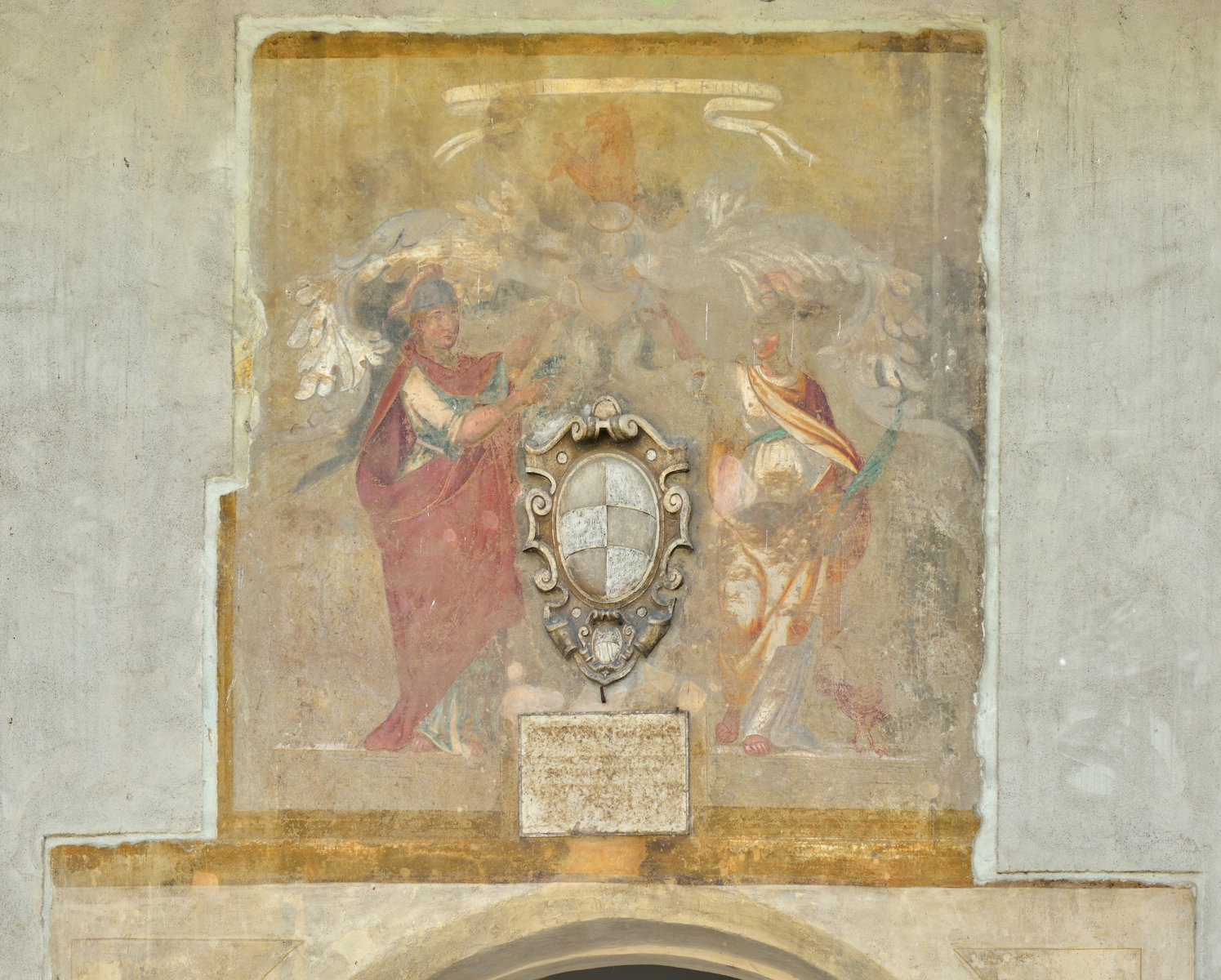
In 1904, the castle hosted the Brescia Industrial Exhibition, an impressive economic event personally inaugurated by King Vittorio Emanuele III. The exhibition featured folklore shows and the Castle was even decorated with temporary Art Nouveau decorations designed by the talented engineer Egidio Dabbani. To enable visitors to experience the castle in style, an electric tram connected the Castle to Corso Zanardelli. Important events continued to take place in the castle: in August 1909, ASM Brescia organized an exhibition dedicated to electricity. The success of these exhibitions paved the way for the transformation of the castle into a public space, as envisioned by Mayor Girolamo Orefici. The halls of the Grande Miglio became the Risorgimento Museum, and the Natural History Museum soon annexed the zoological garden. Outside the fortress walls, a city park was laid out, complementing the beauty of the surroundings of the castle.
1943-1945
During the time of the Italian Social Republic - and known by the name of one of the government residences as the Republic of Salo - a puppet state formed in September 1943 on the territory of northern Italy occupied by Germany, the castle underwent significant changes: instead of the former function of a city park, it became a barracks for fascist and German militias. Several buildings were repurposed as political prisons, resulting in a dramatic reconfiguration of the space.
Until now
The castle has become one of the most popular places for Brescia residents to finally appreciate its interiors. Throughout the twentieth century, many renovation projects were carried out, starting with the creation of a zoo on the site of the Venetian barracks, which were demolished and removed in the 1980s. Today, the castle houses the Risorgimento Museum, the Luigi Marzoli Arms Museum, which displays armor and weapons from the medieval period, the Specola Cidnea, and two large model railways.
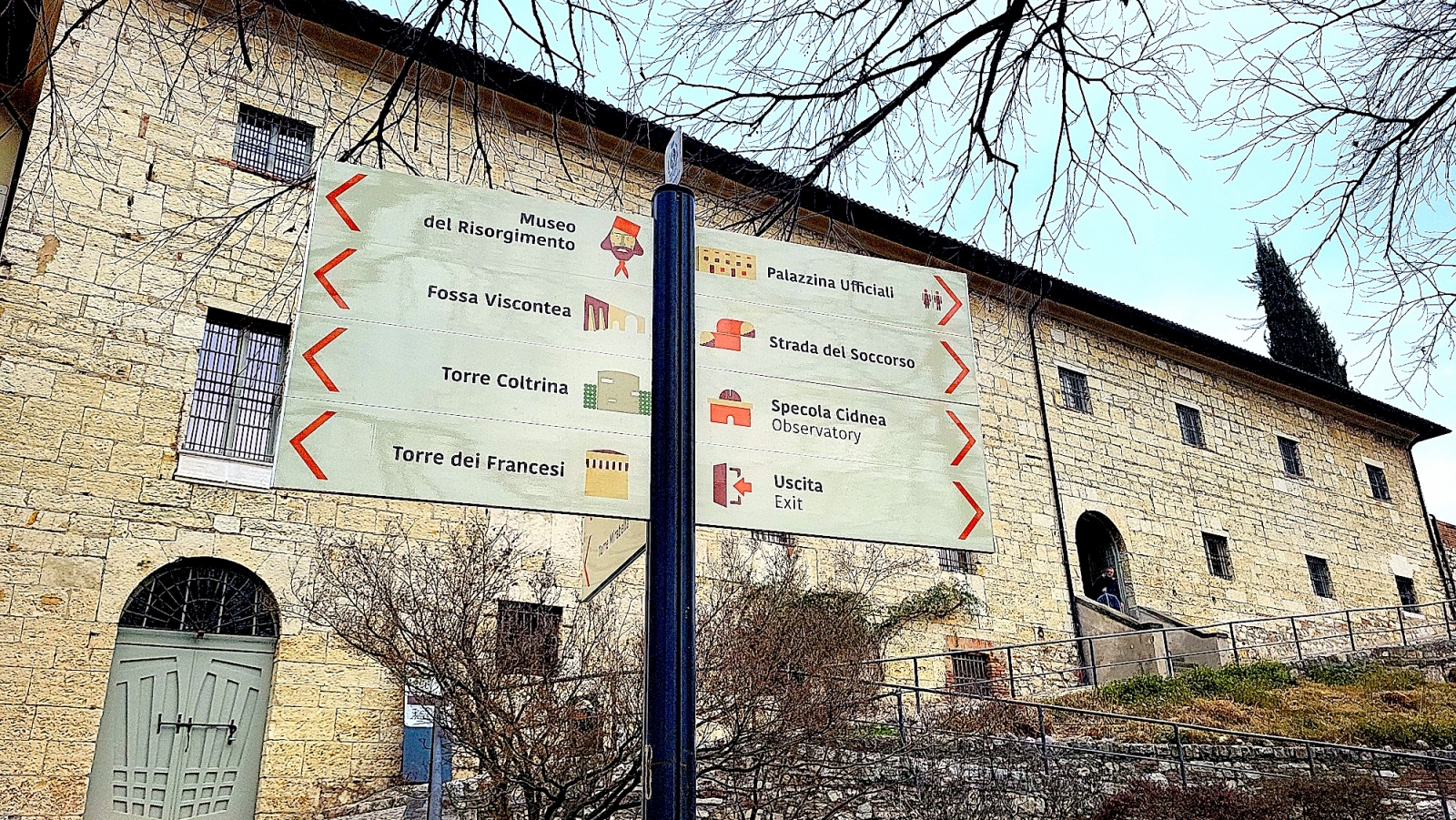
Luigi Marzoli Arms Museum
The fourteenth-century fortress, known as the Visconti Fortress, houses the Luigi Marzoli Arms Museum, which displays one of the most important European collections of antique armor and weapons. The exhibition reflects Brescia's long tradition of arms production, documenting its technological and artistic evolution from the 15th to the 18th centuries. The collection includes many 16th-century infantry half-armors and magnificent Mannerist artifacts, such as a shield dated 1564, embossed and damask depicting the Triumph of Bacchus, an important example of Lombard Mannerism.
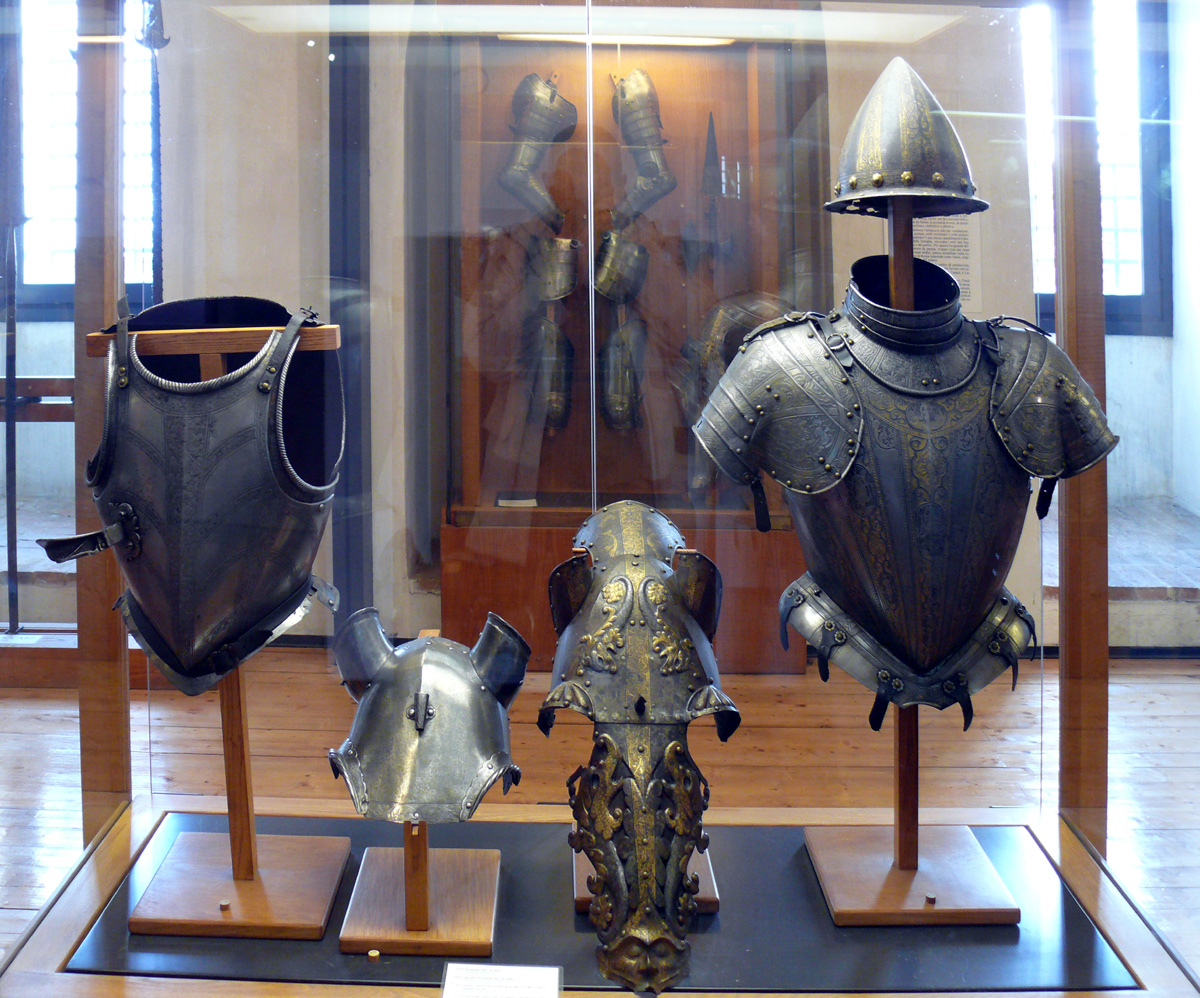
The collection of firearms of the Brescia Museum, created by well-known barrel makers such as Cominazzo, Cinelli, Dafino, and Acquisti, is of particular importance, showcasing a centuries-old tradition of mechanical craftsmanship. Visitors who appreciate ancient architecture and art will be fascinated by the murals of the Visconti Arms Museum that adorn the rooms of the fortress, as well as the Roman temple from the 1st century AD, from which the wide entrance staircase is still visible. The museum's collection also includes various types of weapons (defensive, firearms, and artillery), which show more than 700 items, testifying to the technological and artistic progress made by Bres and local craftsmen from the 15th to the early 19th century. The collections also contain artifacts that have been part of the Christian Museum's collections since the 19th century.
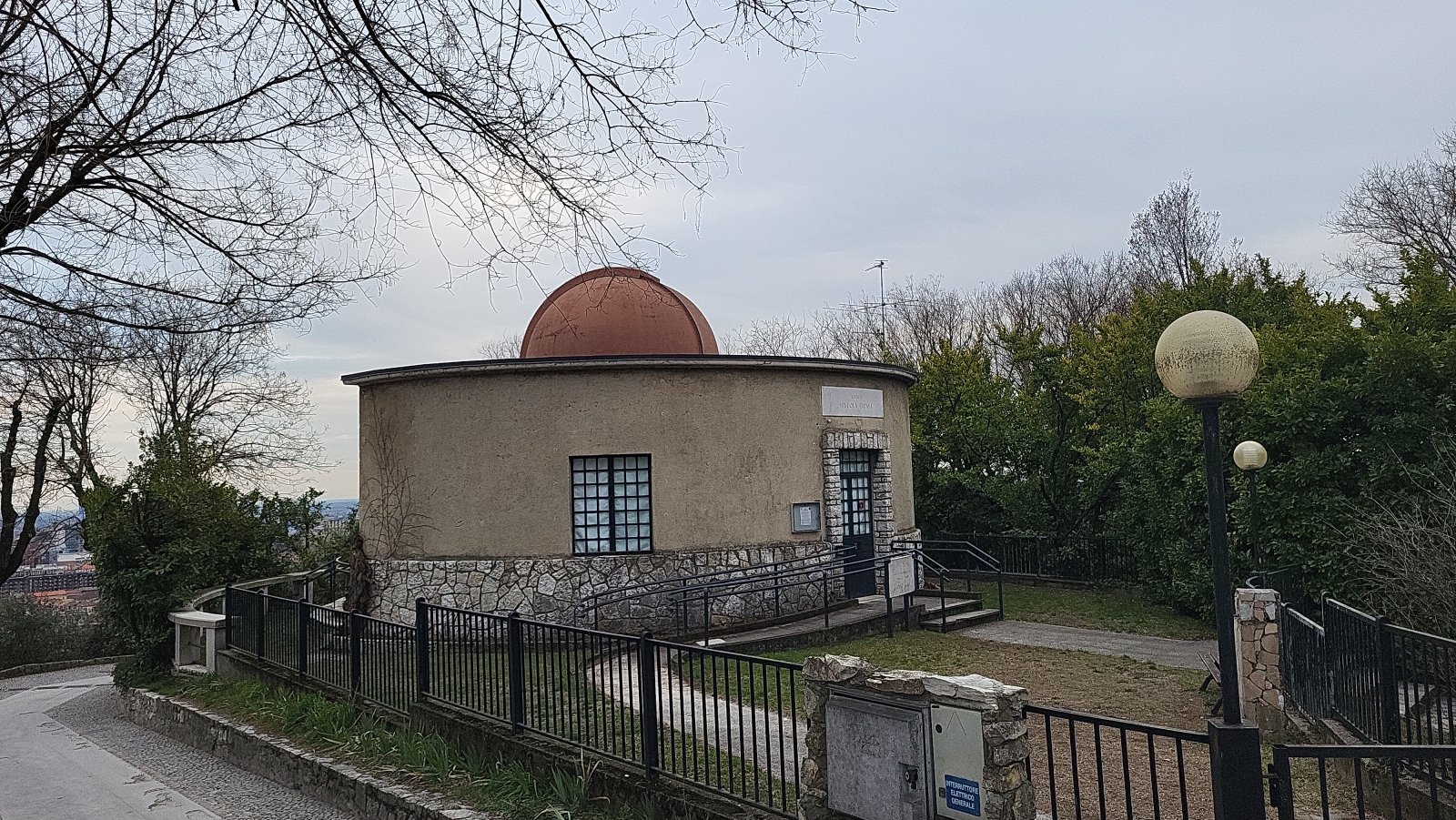
Specola Cidnea
Specola Cidnea is an astronomical observatory located in Brescia Castle. The observatory was founded in 1767 by Jesuit astronomer Angelo Secchi and named after the star Sydney, also known as Alpha Cassiopeia. The observatory is now operated by the Astronomical Observatory of the Autonomous Region of Valle d'Aosta and houses a 20 cm refracting telescope as well as several smaller telescopes for observing the Sun. The observatory is used for both research and outreach, and regularly hosts local guided tours in English and stargazing events for the public.
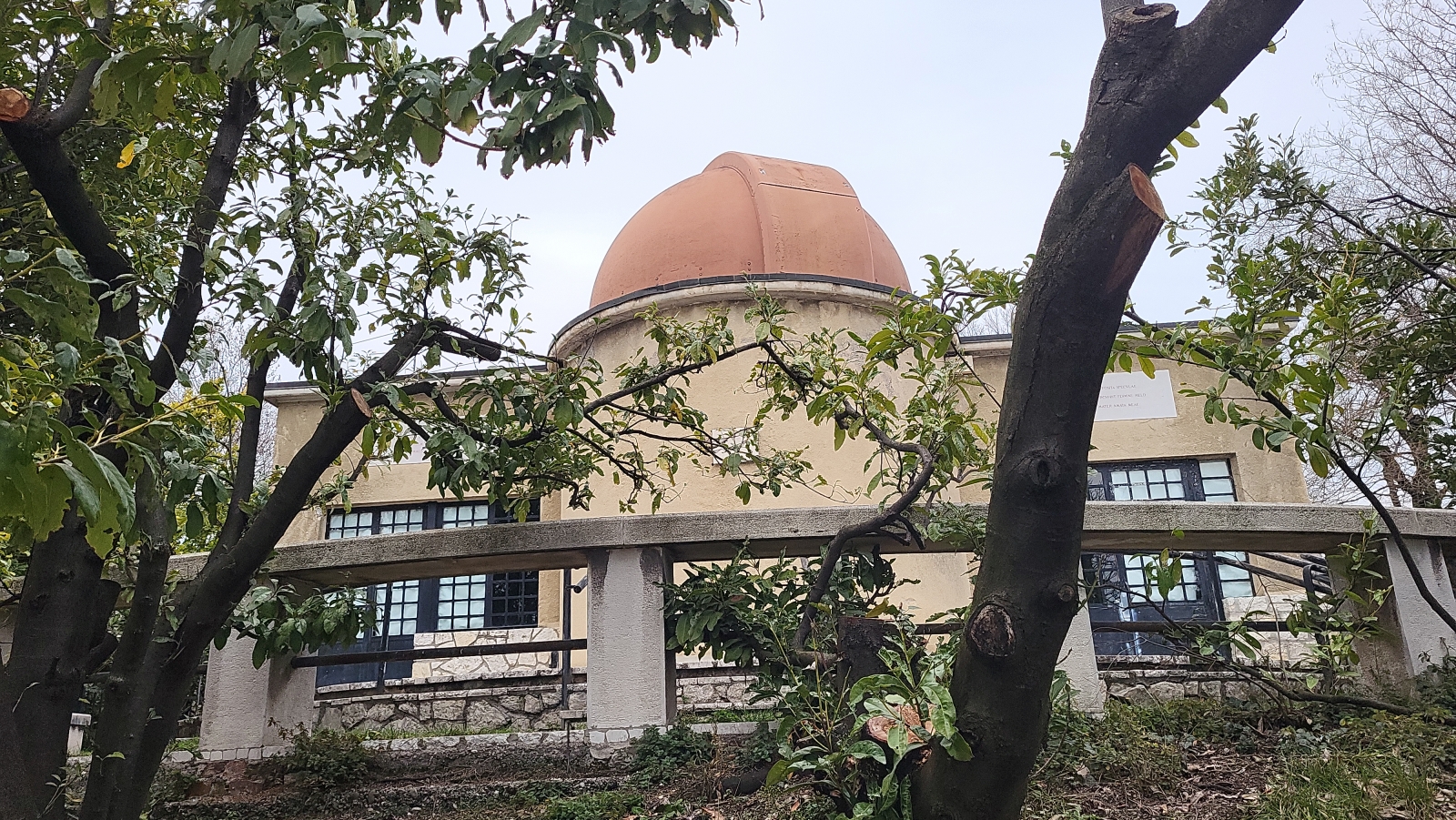
Tower of the French
Torre dei Francesi (Tower of the French) is one of the towers of the medieval fortress of Brescia Castle. It is located on the east side of the castle and is one of the tallest towers in the fortress, rising to a height of 37 meters. The tower was built in the early 16th century by the Venetian Republic as part of their efforts to fortify Brescia from potential invaders. It was originally known as the Torre della Guardia Vecchia (Tower of the Old Guard) and was used as a lookout tower for the castle's garrison.
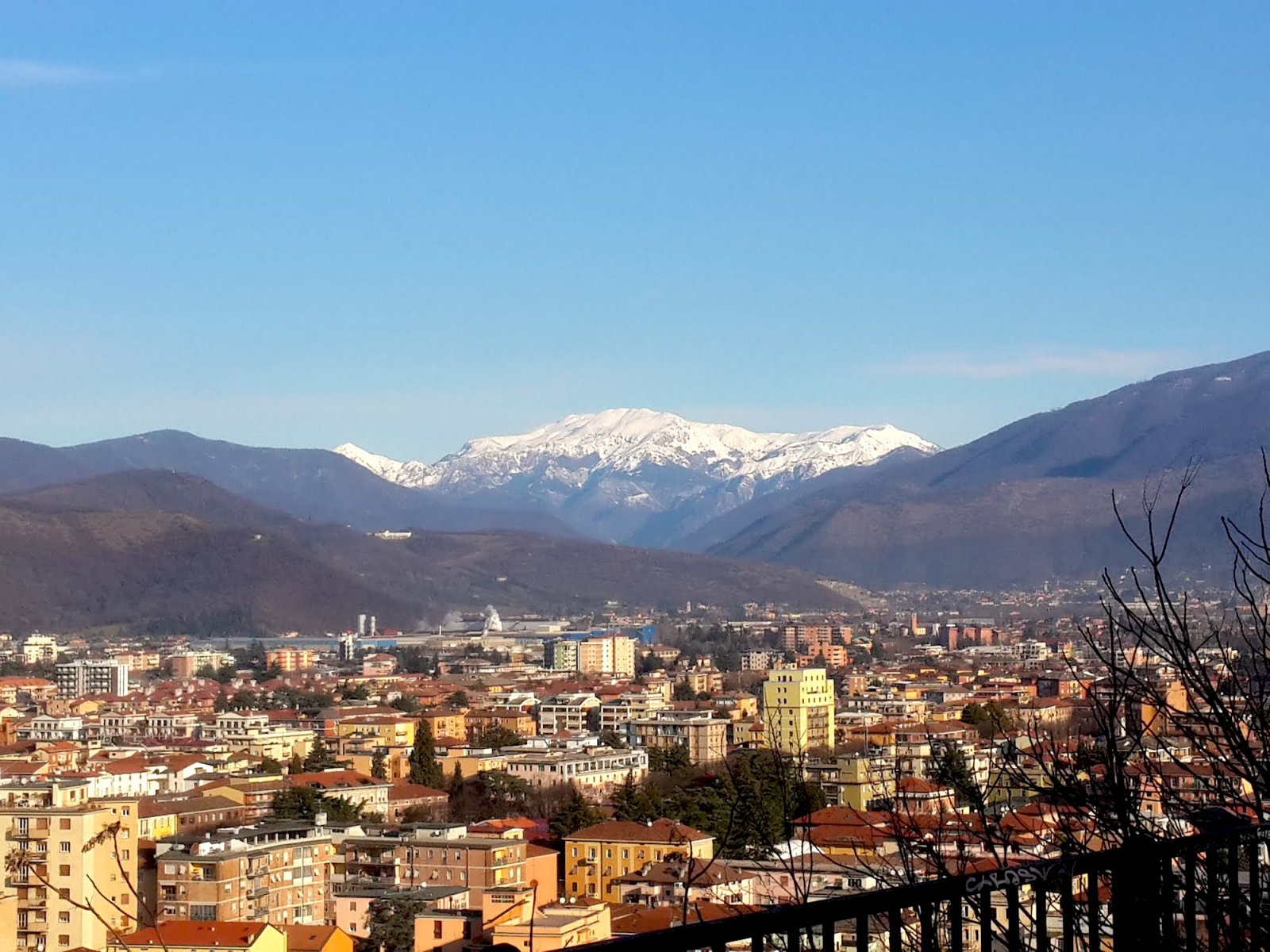
In 1797, during the French Revolutionary Wars, the tower was taken by French troops under the command of General Jean-Mathieu-Philibert Serurier. The French renamed the tower Torre dei Francesi and used it as a prison for political prisoners. Today, the Torre dei Francesi is open to the public as part of the Brescia Castle Museum. Visitors can climb the tower's spiral staircase to enjoy panoramic views of the city of Brescia and the surrounding area. The tower also houses several exhibits on the history of the castle and the city.
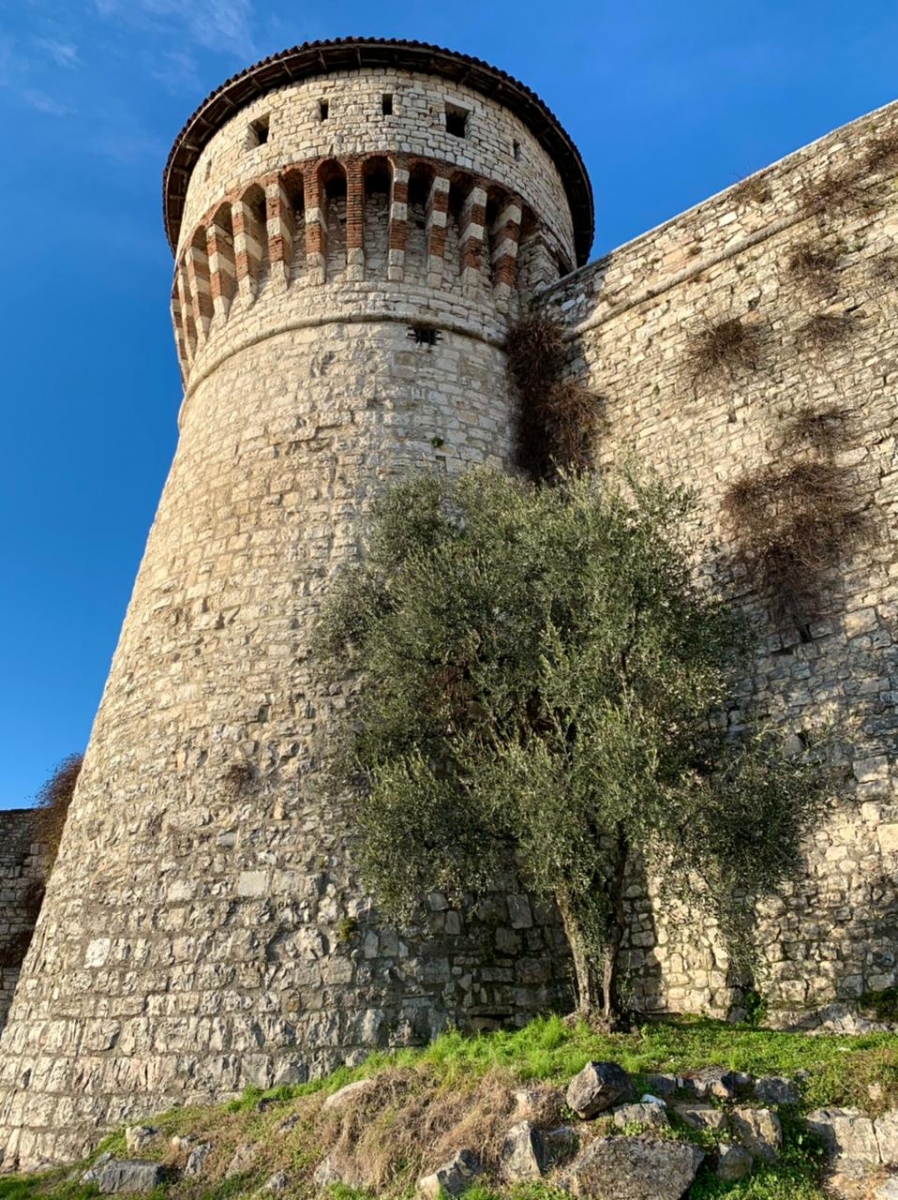
Tower of Prisoners
Torre dei Prigionieri, also known as the Tower of Prisoners, is another tower located in Brescia Castle. It is located on the south side of the castle and is one of the most characteristic towers of the fortress due to its tall, slender shape and decorative arches that adorn its upper levels. The tower was built in the early 16th century by the Republic of Venice as part of the castle's fortifications. Like many other towers of the castle, for most of its history, it was used as a prison. The tower's narrow shape made it an ideal place to hold high-ranking prisoners, as it was difficult to escape and easy to control.
Today, the Torre dei Prigionieri is open to the public as part of the Brescia Castle Museum. Visitors can climb the tower's spiral staircase to explore its various levels and learn about its history as a prison. The tower also offers a beautiful view of the city of Brescia and the surrounding area. The Prisoners' Tower is also known for its impressive architecture, which includes a series of ornate arches on the upper levels reminiscent of Venetian Renaissance architecture. The tower was probably designed by the Venetian architect Bernardino da Morcote, who was responsible for several other buildings in and around Brescia.
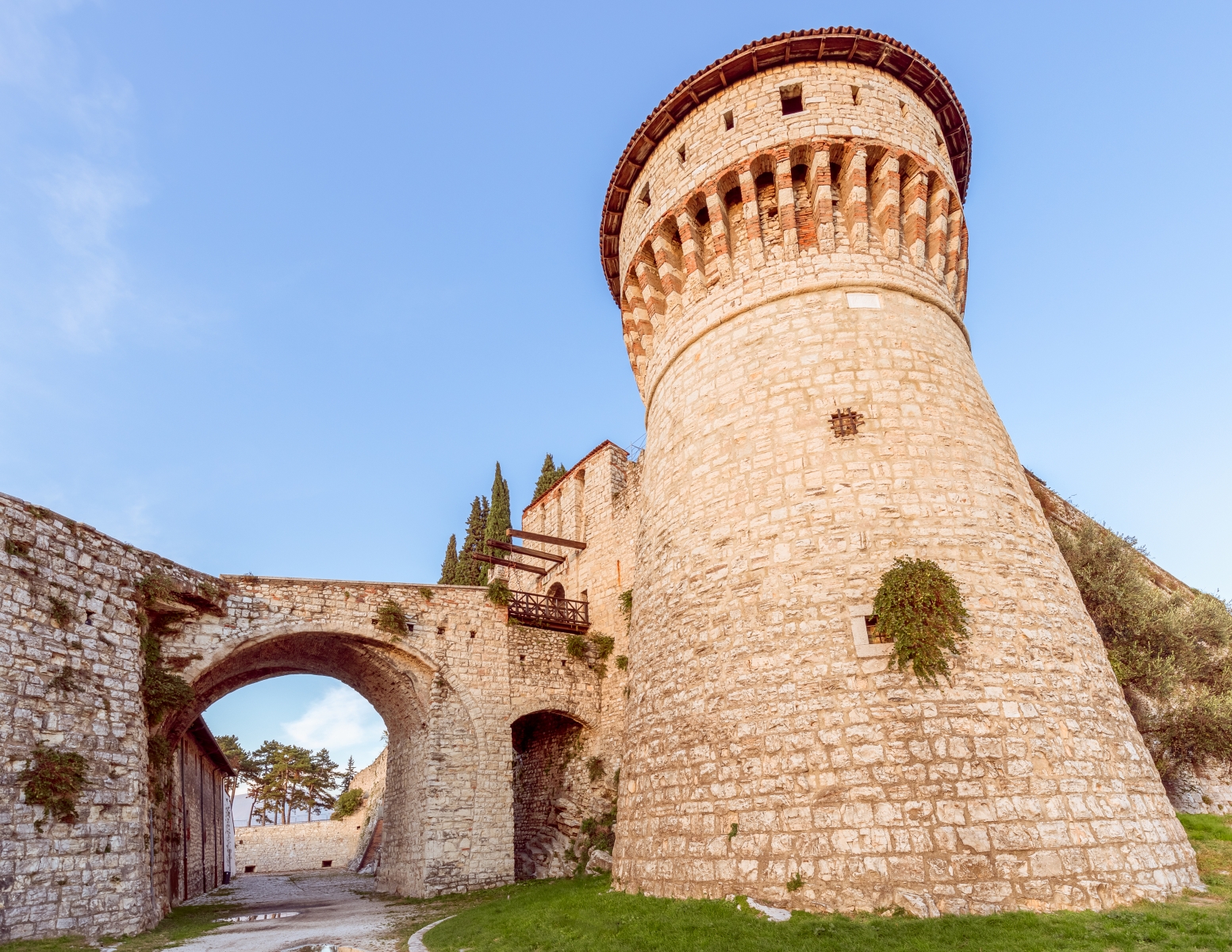
In addition to its use as a prison, Torre dei Prigionieri served other functions over the centuries. During the Renaissance, it was used as the workshop of the painter Moretto da Brescia, who created several important works of art here. In the 19th century, the tower was used as a signal station and flags and lights were used to communicate with other towers in the region.
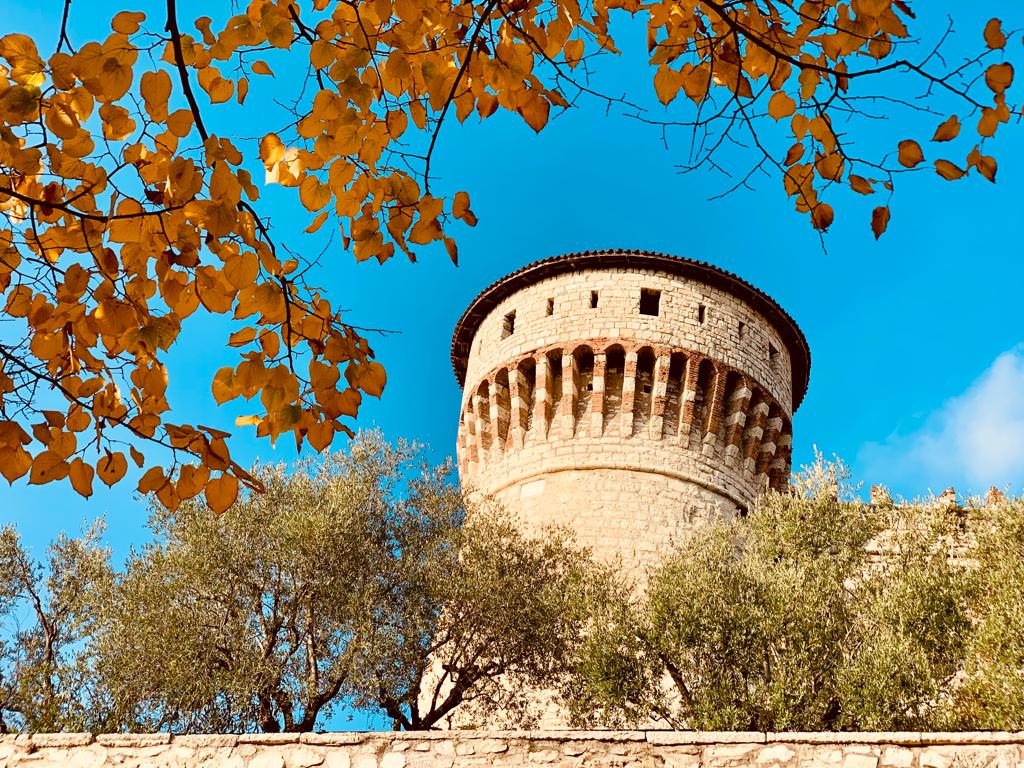
Today, the Tower of Prisoners is a popular tourist attraction in the city of Brescia. Visitors can explore its narrow winding passageways and learn about the history of the castle and the city. The tower is also often used as a venue for cultural events and exhibitions and offers stunning views of the city and surrounding area.
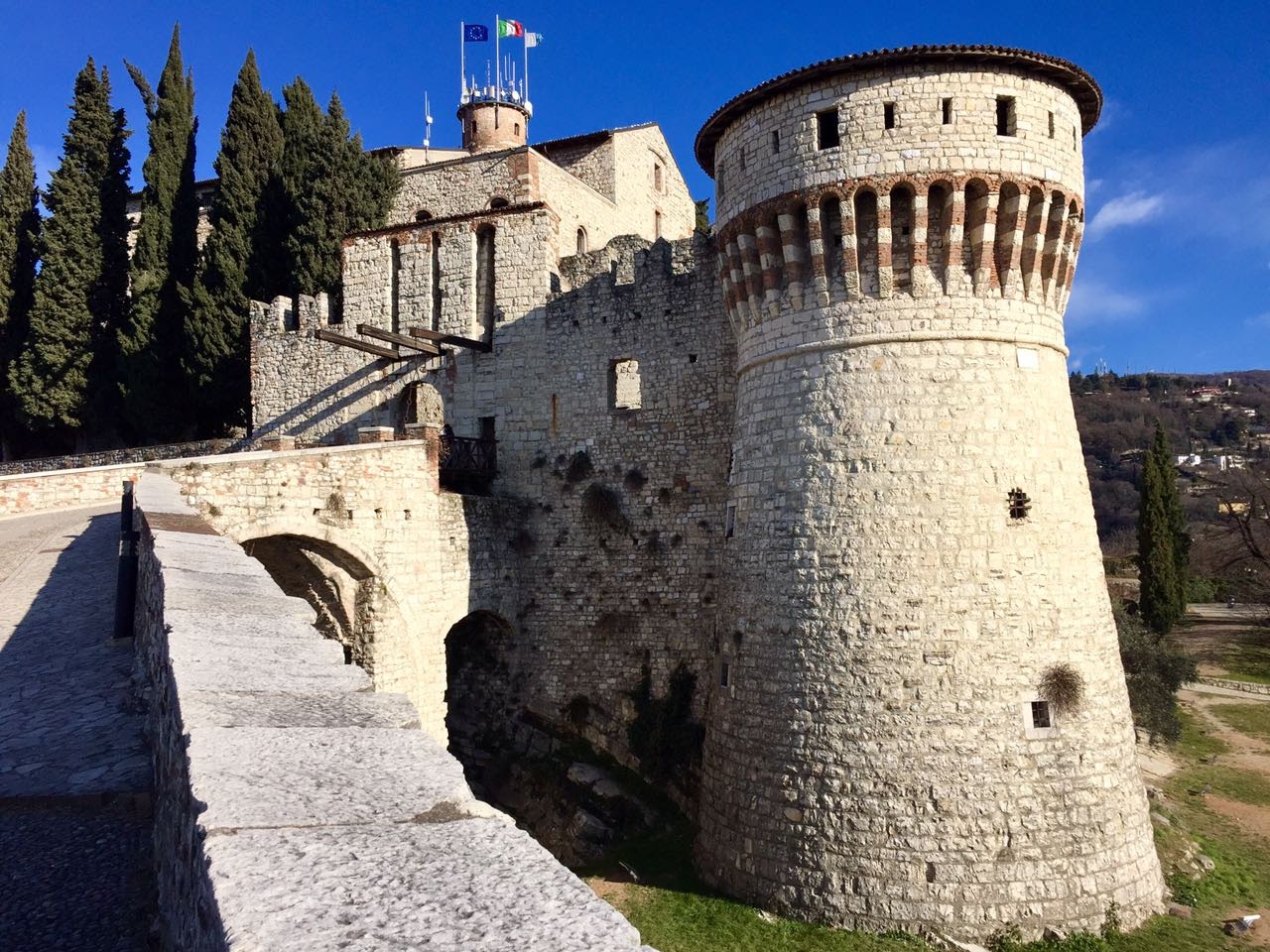
Fortress cannon
The Cannone da Fortezza, or Fortress Cannon, is a giant cannon located in Brescia Castle in northern Italy. The gun is one of the castle's most impressive artillery pieces and bears witness to the fort's long history as a military stronghold. The fortress cannon dates back to the early 16th century when it was built by the Republic of Venice as part of the defense of the castle. The gun is made of bronze and has a length of more than 4 meters, and a diameter of almost 60 centimeters. It weighs over 8,000 kg and was designed to fire giant cannonballs at enemy forces.
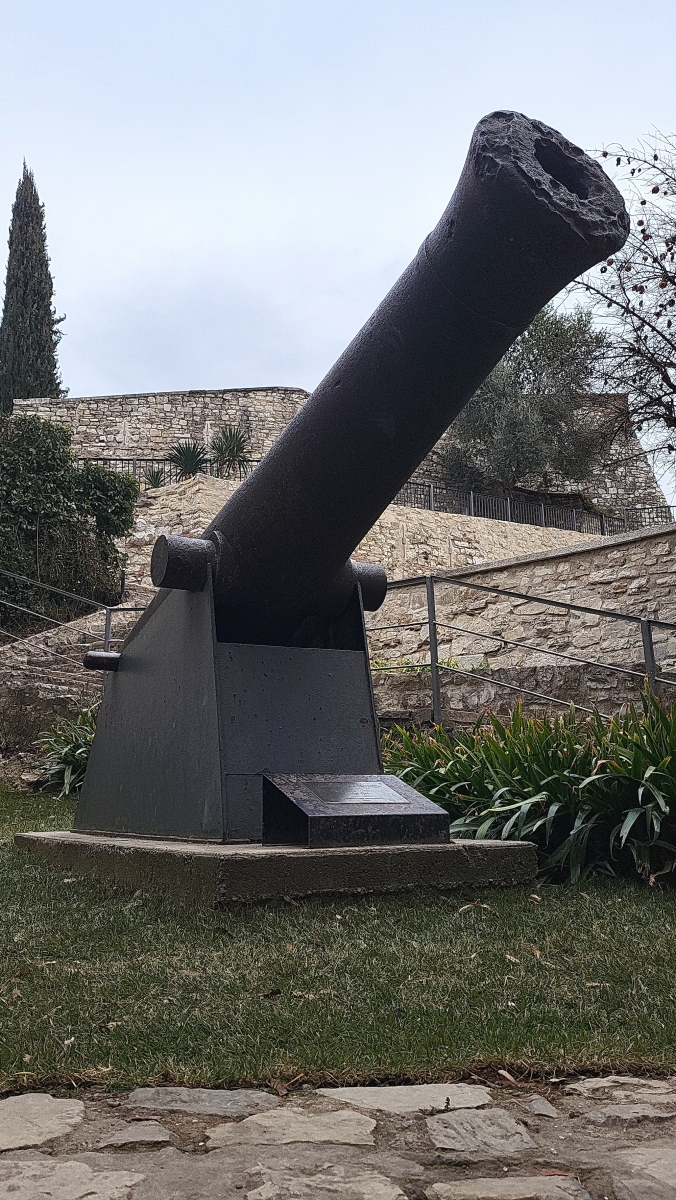
For centuries, the Fortress Cannon has been used to defend Brescia from numerous invasions and attacks. During the French Revolutionary Wars, the cannon was used by French troops under the command of General Jean-Mathieu-Philibert Serurier to bombard the castle and force it to surrender. Today Cannone da Fortezza is on display at the Brescia Castle Museum. Visitors can see the cannon up close and learn about its history and significance. The museum also houses a collection of other artillery pieces and weapons from throughout the castle's history, providing a glimpse into the fortress' long military legacy.
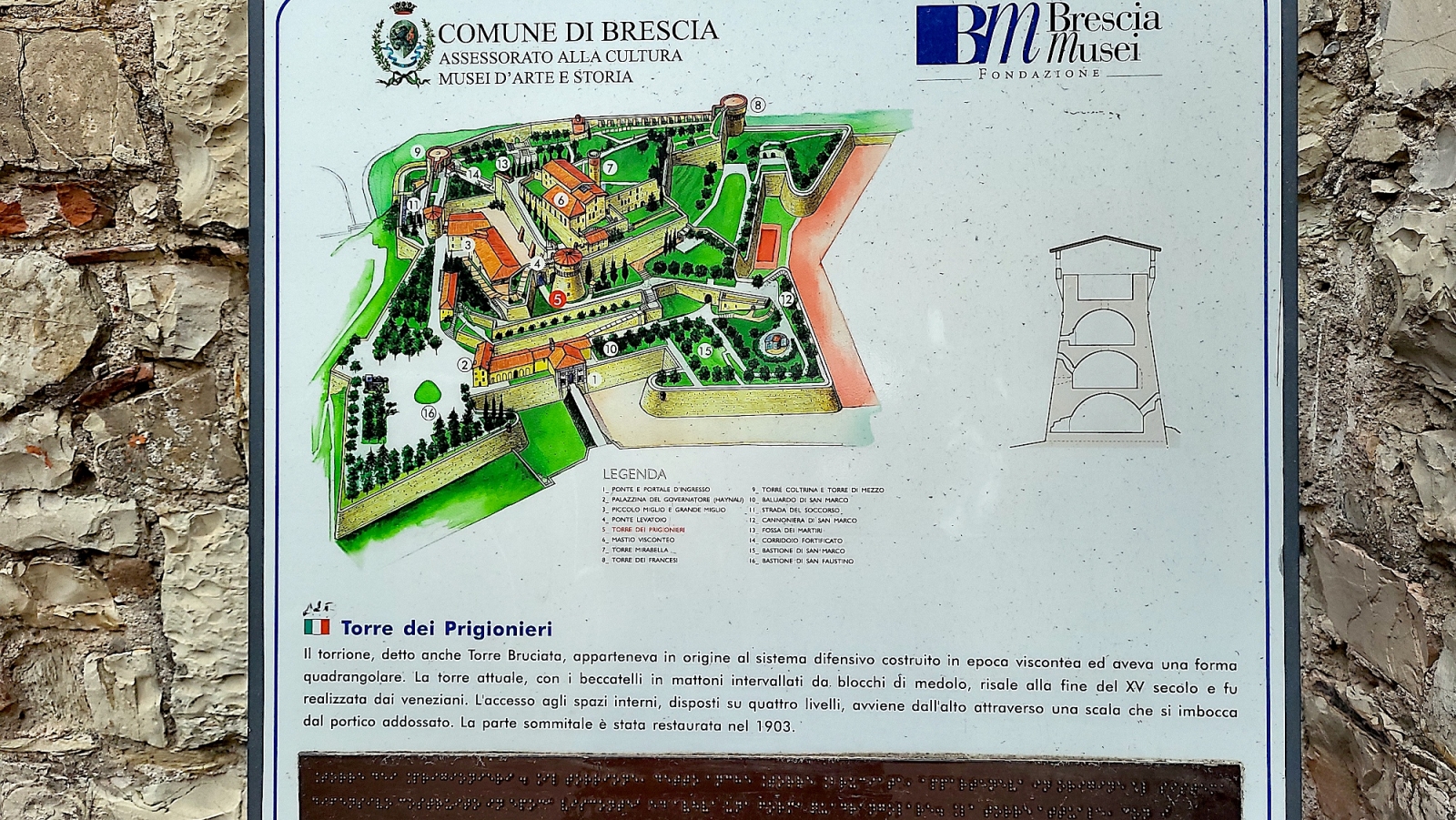
Mirabella Tower
Torre Mirabella is a tower located on the very top of Cidneo hill in Brescia Castle. It is located on the western side of the castle and is one of the most striking and recognizable towers in the fortress due to its characteristic octagonal shape and its vantage point overlooking the city of Brescia.
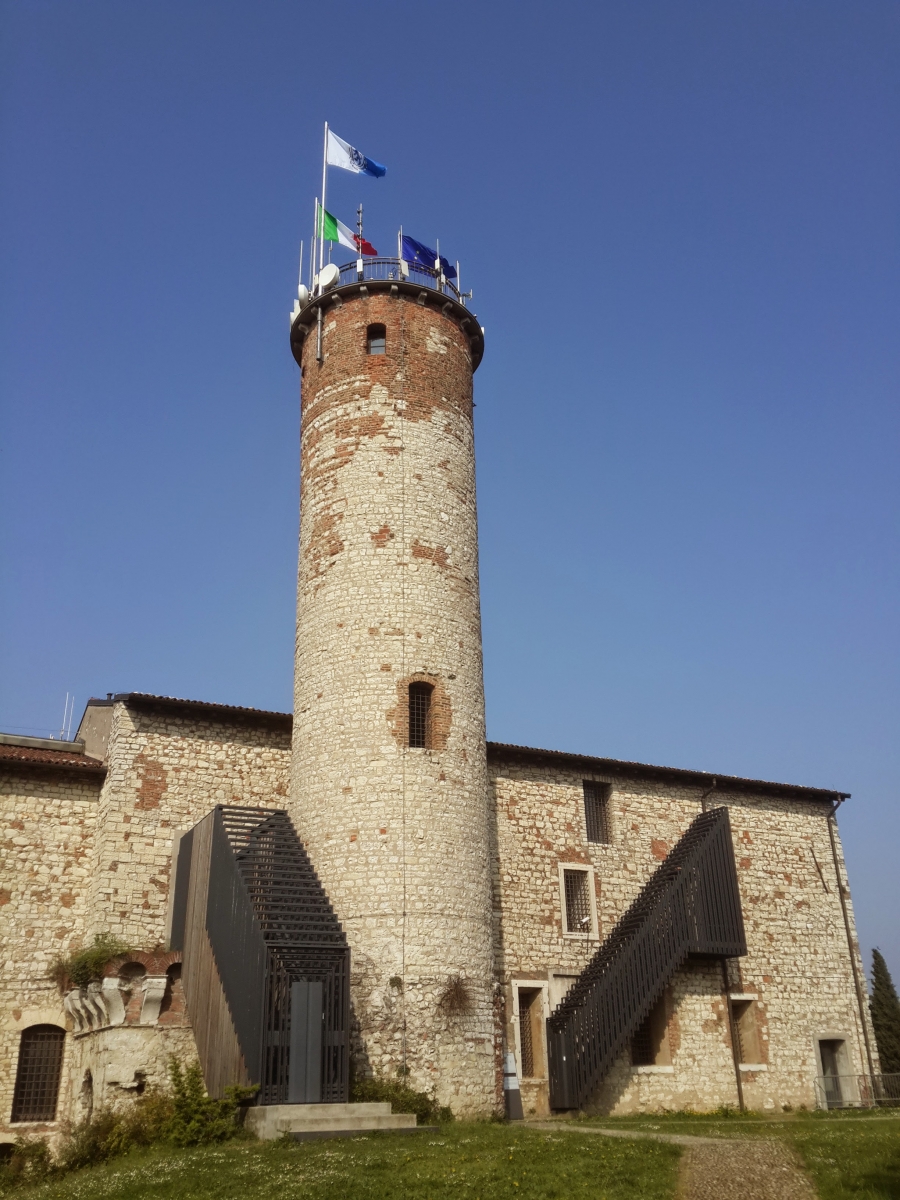
The tower was built in the 13th century by the Visconti family, who at the time were lords of Brescia. It was originally known as the Torre del Popolo, or Tower of the People, and was used as a defensive tower to protect the city from would-be intruders. The tower was later renamed Torre Mirabella after a local noblewoman who is said to have defended the castle during the siege.
Torre Mirabella is distinguished by its impressive architecture, which includes several levels of arcades and decorative arches typical of the Lombard Gothic style. The tower also offers stunning views of the city of Brescia and the surrounding countryside, making it a popular destination for tourists and locals alike.
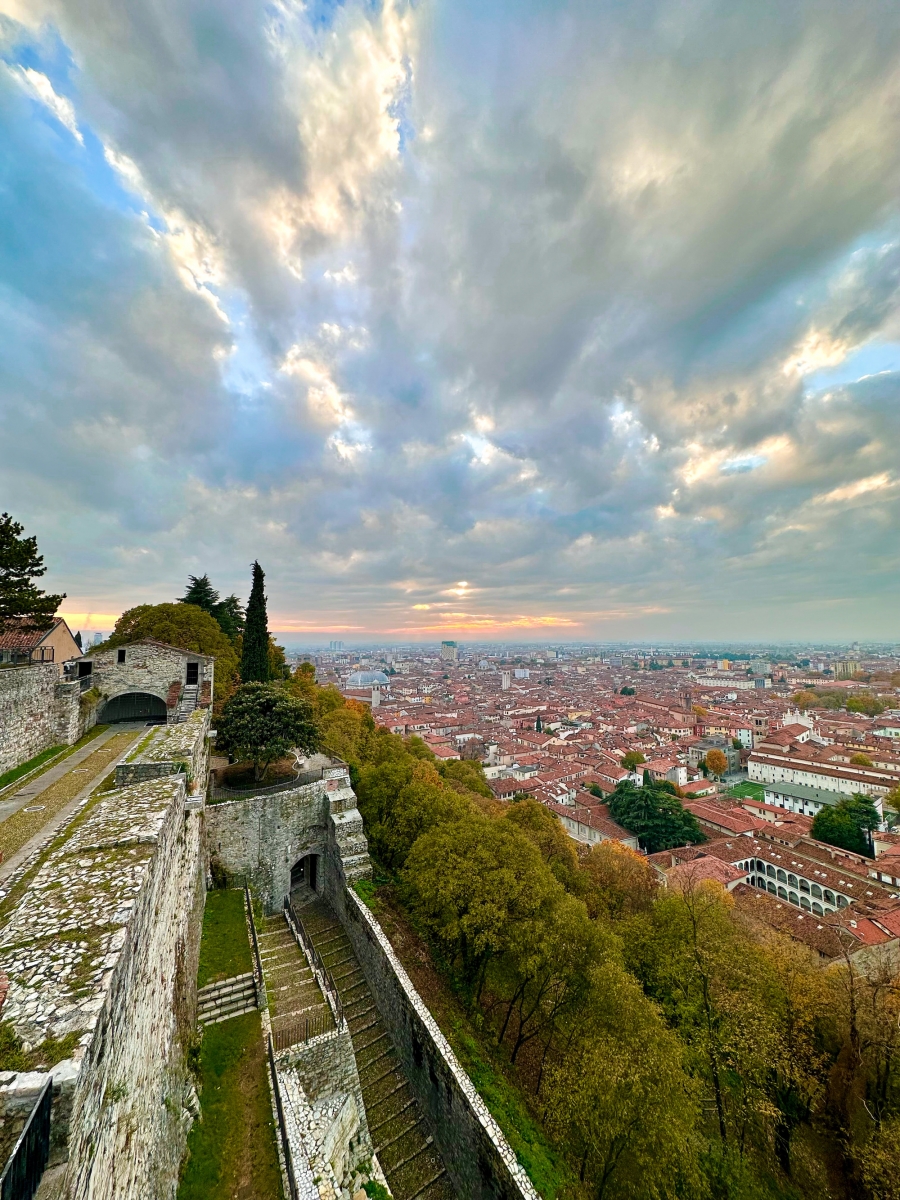
Today Torre Mirabella is open to the public as part of the Brescia Castle Museum. Visitors can climb the tower's spiral staircase to enjoy panoramic views of the city and explore the different levels of the tower, which house exhibits on the history of the castle and the city of Brescia. The tower is also often used as a venue for cultural events and exhibitions, which enhances its importance as a landmark and cultural symbol. Torre Mirabella is also known for its impressive height of over 27 meters. The octagonal shape and gabled roof give it a unique appearance that distinguishes it from other castle towers.
Throughout its history, Torre Mirabella has served many functions. In addition to being used as a defensive tower, it was used as a bell tower, a prison, and a storeroom. During the Renaissance, it was even used as the private residence of a local noble family. Today, Torre Mirabella is an important cultural landmark in Brescia and a popular tourist destination. Whether you're a history buff or just looking for a beautiful view, Torre Mirabella is definitely worth a visit.
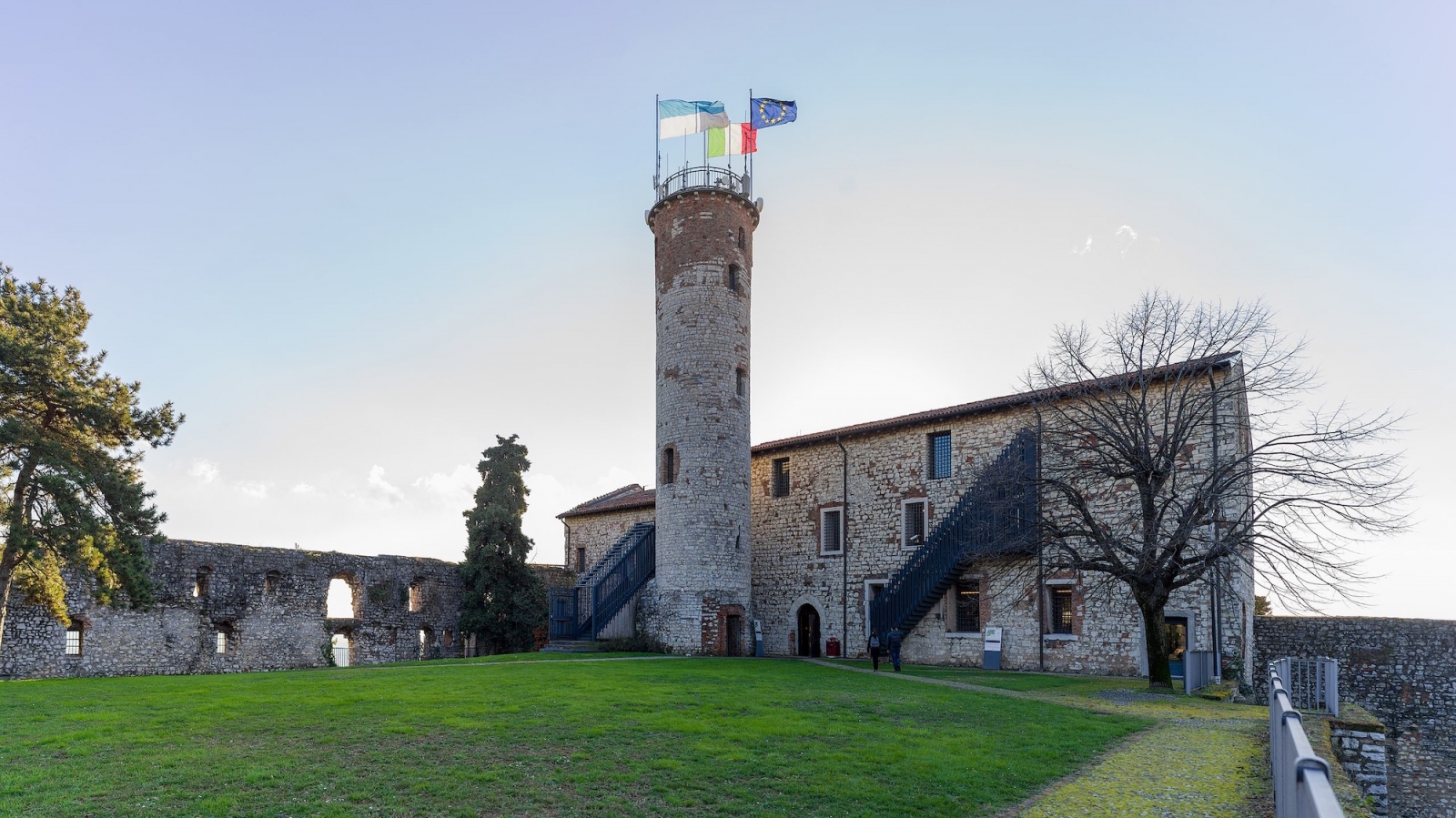
Middle Tower
Torre di Mezzo, or Middle Tower, is one of the main towers of Brescia Castle. It is located in the central part of the fortress and is connected to other towers by a series of walls and passages.
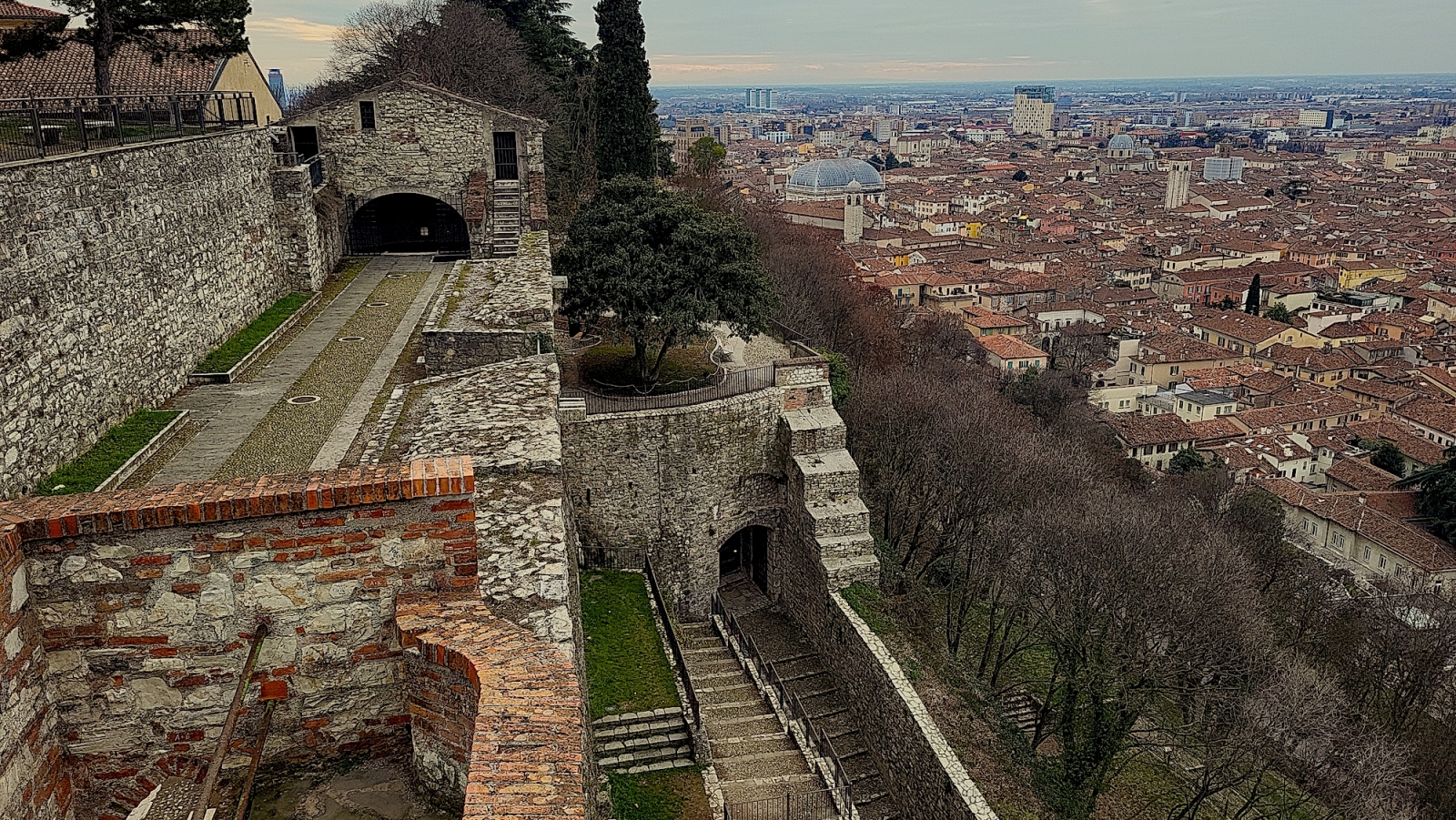
The tower dates back to the 13th century and was originally built by the Visconti family as part of the castle's defenses. This is one of the highest towers in the fortress, its height is more than 30 meters, and it offers an impressive view of the surroundings.
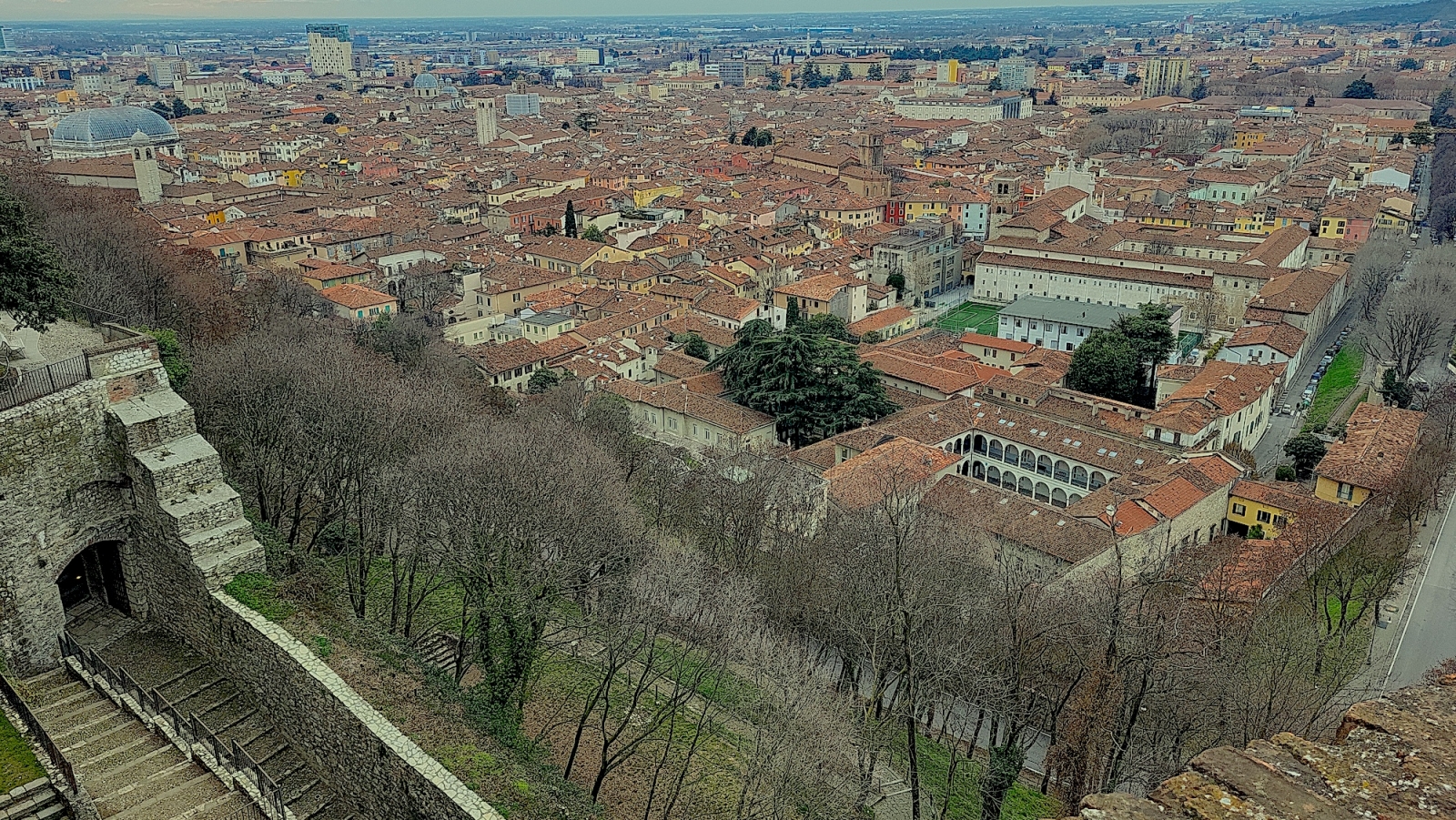
Over the centuries, Torre di Mezzo has served many functions, including an observation tower, a prison, and a warehouse for arms and supplies. During the Napoleonic Wars, the tower was used as a powder store and later used as a barracks for the Austrian troops.
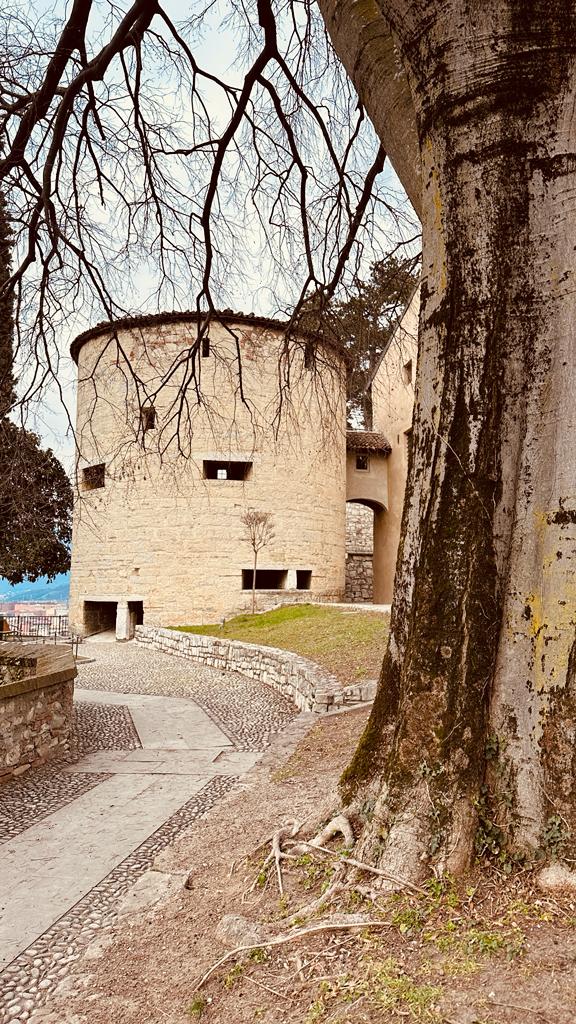
Today Torre di Mezzo is open to the public as part of the Brescia Castle Museum. Visitors can climb to the top of the tower to enjoy a panoramic view of the city and explore the different levels of the tower, which house exhibits on the history of the castle and the city of Brescia. The tower is also often used as a venue for cultural events and exhibitions, which enhances its importance as a landmark and cultural symbol.
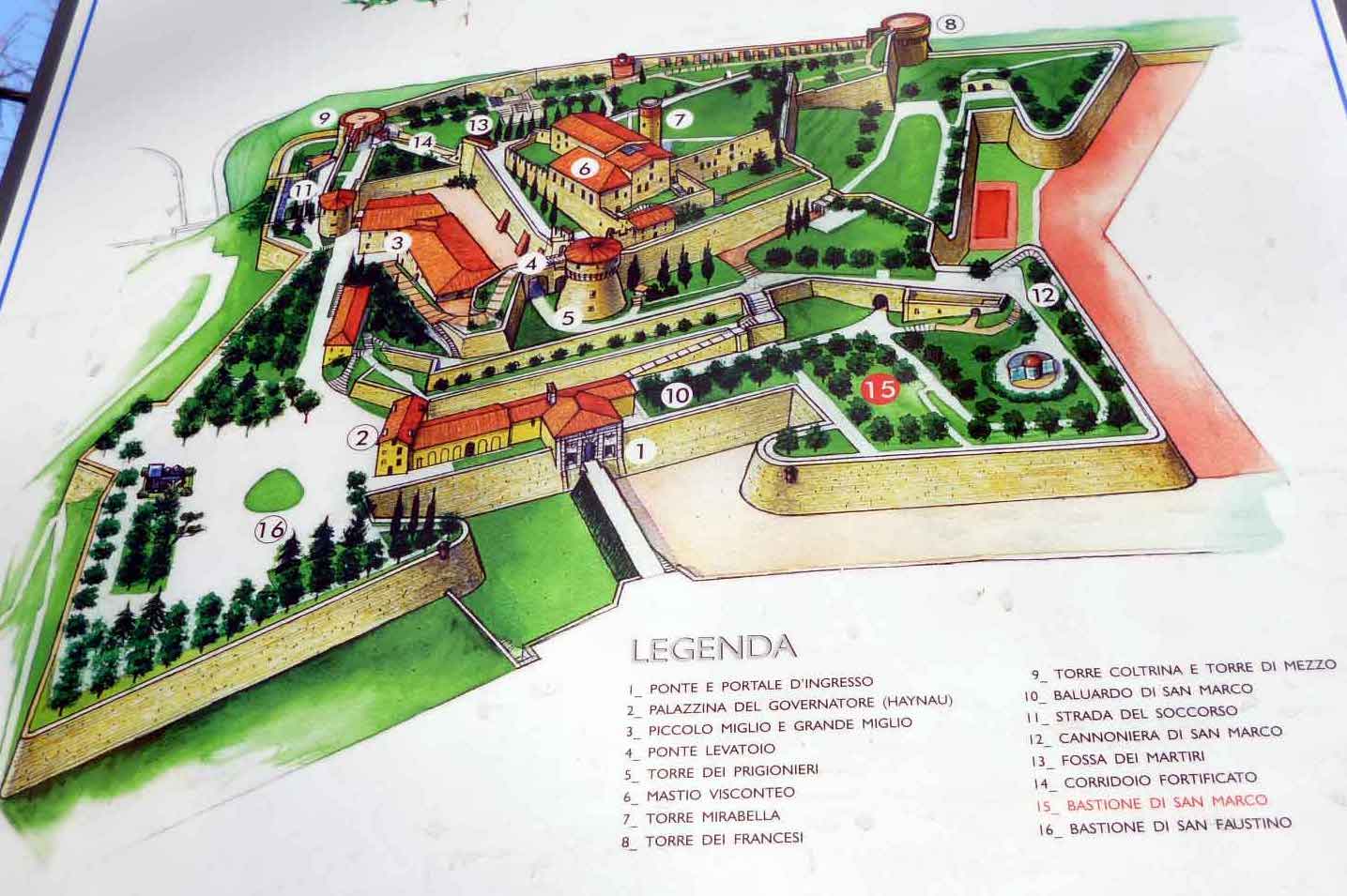
I Sotterranei del Castello di Brescia
"I Sotterranei del Castello di Brescia" refers to the underground chambers and tunnels located under the castle of Brescia. These underground spaces have a long and storied history and have been used for a wide variety of purposes over the centuries. Underground chambers and tunnels were first built in the 16th century to improve the defenses of the castle. The tunnels were used to connect the various towers and fortifications of the castle, allowing troops to quickly and easily move from one part of the fortress to another.
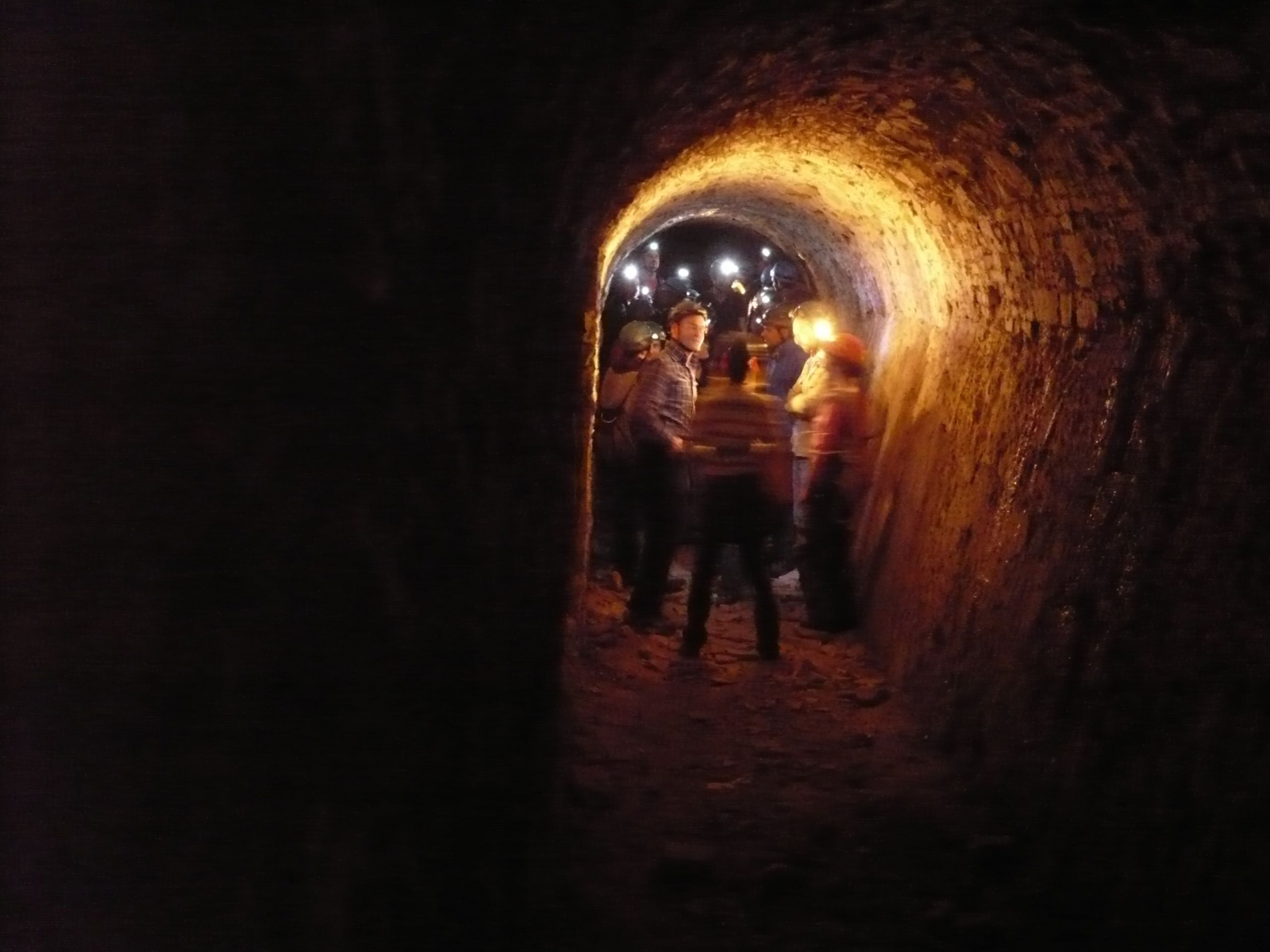
Over the years, the underground chambers and tunnels have also been used for other purposes, including as a prison, warehouse, and even as a shelter during times of war. Today, visitors to Brescia Castle can explore the underground chambers and tunnels as part of the Castle Museum on personally guided tours in the English language. The tunnels offer a fascinating glimpse into the history of the castle and city of Brescia, and visitors can see exhibits and displays that highlight the various uses of the tunnels throughout history. Exploring the underground chambers and tunnels is a unique and exciting way to get to know Brescia Castle, giving visitors the chance to see parts of the fortress not normally visible from the ground.

Сoltrina Tower
Torre Coltrina is one of the towers of Brescia Castle. It is located in the northeast corner of the fortress and is one of the smallest towers in the complex. The tower dates back to the 13th century and was originally built as part of the castle's defenses. It was used as an observation tower and a guard post and was also equipped with arrow holes and other protective devices. Over the years, Torre Coltrina has served in many different roles. In the 16th century, it was used as a gunpowder store and was also used as a prison for some time.
Today, Torre Coltrina is closed to the public but remains an important part of the history and architecture of Brescia Castle. Visitors to the castle can see the tower from the outside and appreciate its unique design and historical significance. Although visitors cannot enter Torre Coltrina itself, they can explore the area and see other parts of the castle's defenses. The castle's northeast corner has several other towers and fortifications worth seeing, including Torre San Faustino and Torre del Popolo.
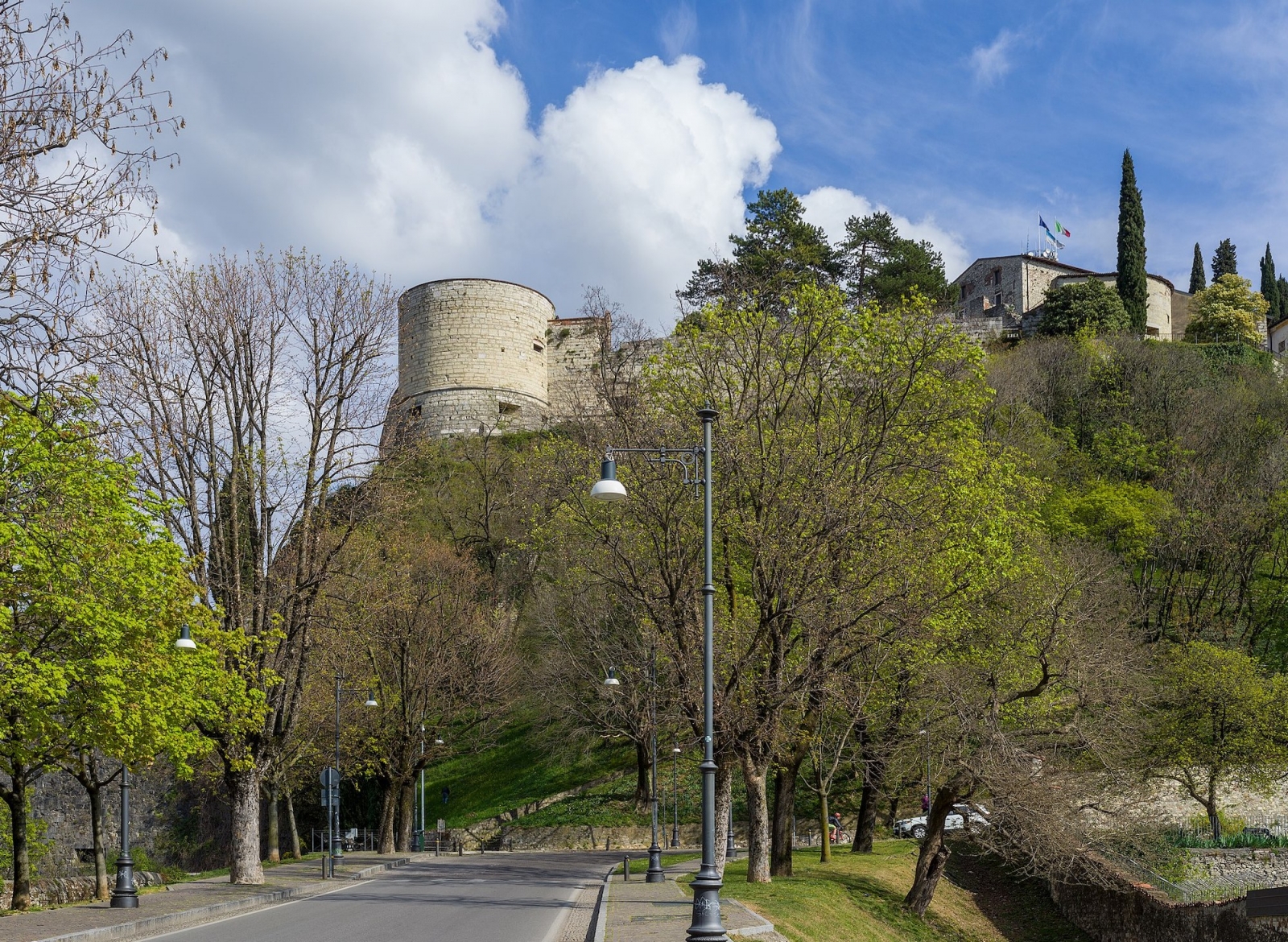
Torre San Faustino is a round tower located near Torre Coltrina. This is one of the largest towers of the castle complex and was originally built as part of the castle's medieval defenses. Later, the tower was used as a prison and was also equipped with cannons and other protective devices.
Torre del Popolo, or People's Tower, is another tower located in the northeastern part of the castle. It is a square tower built in the 12th century and was originally used as a watchtower. For many years it was used as a prison and as a warehouse for weapons and supplies.
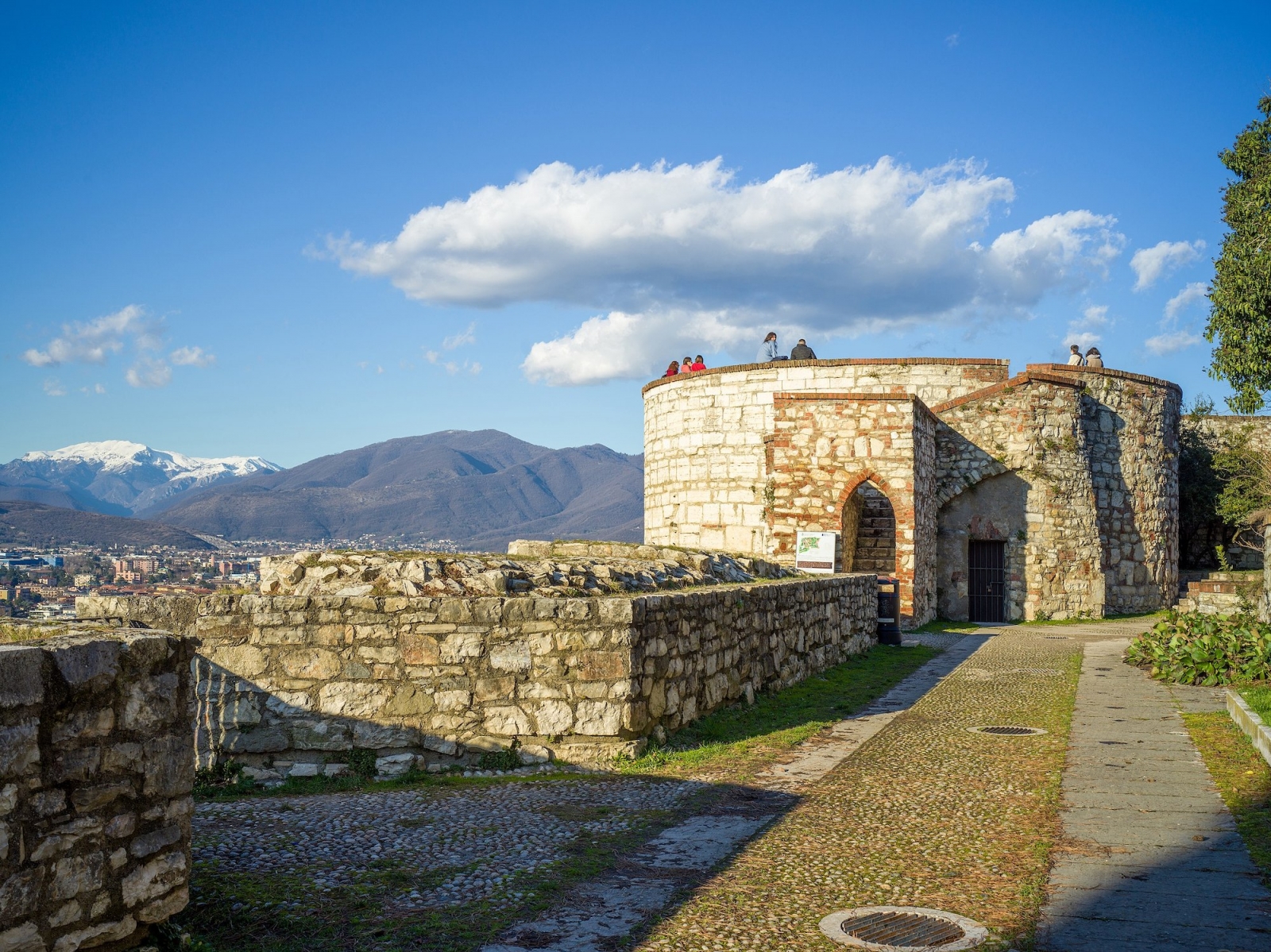
Together, Torre Coltrina, Torre San Faustino, and Torre del Popolo provide a breathtaking glimpse into the history of Brescia Castle and the city itself. Visitors can look around and see these towers up close, appreciating their unique design and historical significance.
Locomotive
Locomotiva a Vapore SNFT N 1 is a historic steam locomotive located in Brescia Castle. The locomotive is an important part of the castle museum and gives visitors a unique insight into the history of transportation and industry in the region. It was built in 1883 by the Swiss locomotive manufacturer SLM Winterthur for the Società Nazionale Ferrovie e Tramvie (SNFT), a private railway company operating in northern Italy. The locomotive was used for both passenger and freight traffic and played an important role in the development of the region's transport infrastructure.
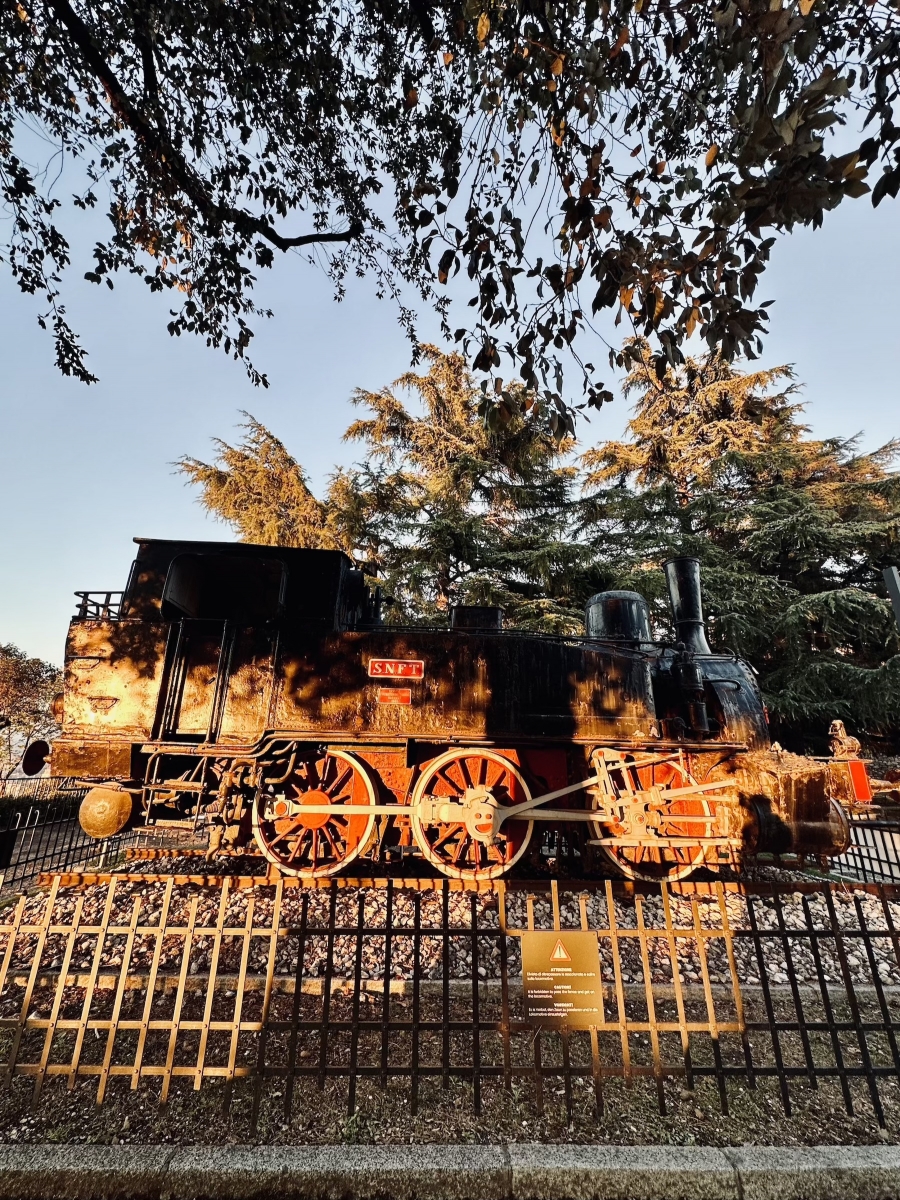
After the nationalization of the SNFT in 1905, the locomotive was used by the Italian national railway company, Ferrovie dello Stato (FS). It was decommissioned in the 1950s and eventually purchased by the city of Brescia. Today, the SNFT N. 1 locomotive is on display at the Brescia castle museum. Visitors can see the locomotive up close and appreciate its unique design and historical significance. The locomotive testifies to the importance of rail transport in Italian history and serves as an important reminder of the region's industrial past.
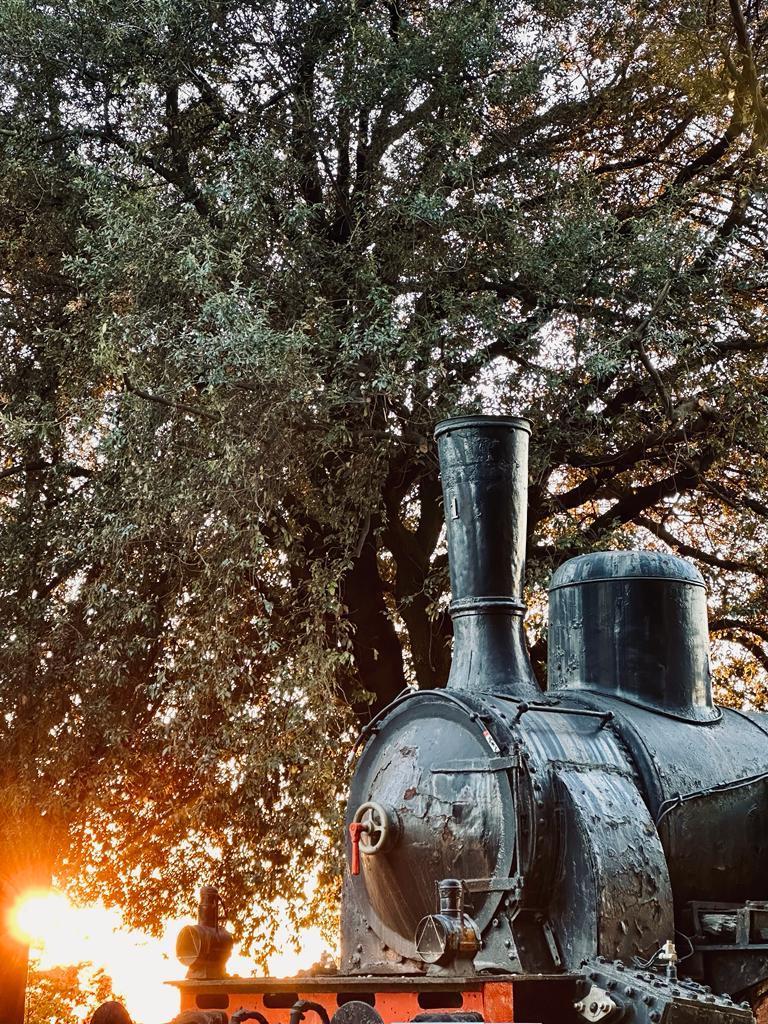
Mastio
In 1343, Luchino Visconti rebuilt the Castle from scratch and built Mastio on the ruins of a Roman temple. The Luigi Marzoli Arms Museum still has frescoes with the coats of arms of Luchino and his brother Giovanni. The function of the mastio, as can be seen, today, was not only military but also administrative, where the Milanese governor settled. Although Mastio was still in use during the first Venetian reign, as evidenced by some frescoes from 1442, with the construction of modern fortifications, the mastio gradually lost its importance. At the end of the 19th century, it served as a military prison, as evidenced by the preserved heavy window bars. After World War II, it became a museum.
Visitors can explore the inner and hidden rooms of the castle thanks to local tours in this Italian city in English, in particular those organized by the Speleological Association of Brescia, which has been exploring the passages and channels for years, discovering forgotten paths. The Mastio Visconteo, also known as the Visconti Tower, is one of the most significant structures in Brescia Castle. This is a large tower that stands on the highest point of the castle complex and played an important role in the history and defense of the fortress.
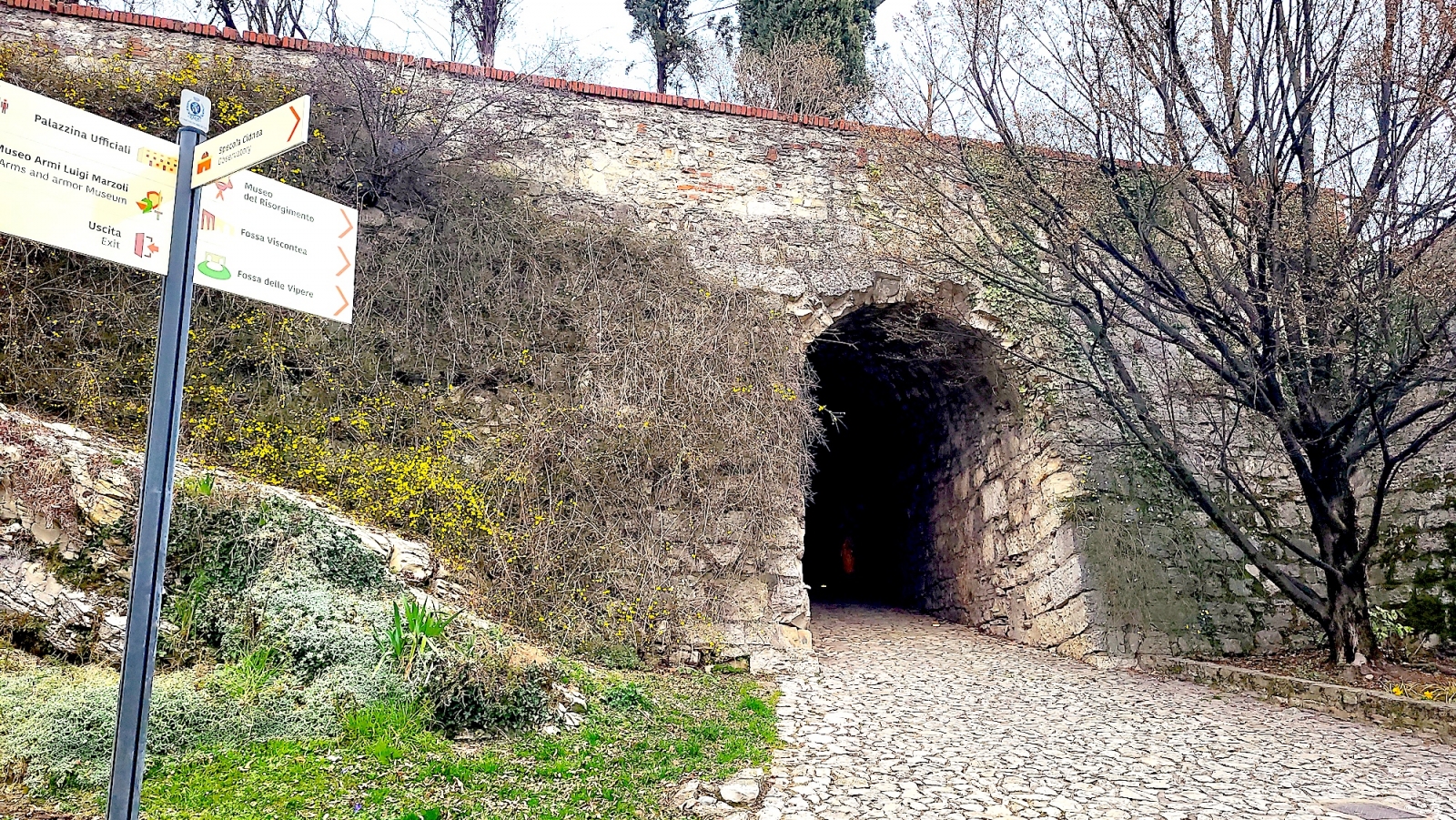
The tower dates back to the 14th century and was built by the Visconti family, who ruled Milan and most of northern Italy at the time. The tower was built as part of the castle defenses and was intended to be used as a stronghold during the war. Mastio Visconteo is a massive structure over 30 meters high. It is made of brick and stone and features a unique design that includes multiple levels and defensive elements such as slits and a drawbridge. The interior of the tower is also well-preserved and has several rooms and passageways for visitors to explore.
Mastio Visconteo has performed many different functions over the years. During the Renaissance, it was used as a prison and was also equipped with cannons and other defensive devices. Today, the tower is open to the public and visitors can climb to the top to enjoy stunning views of the city and surroundings. The Mastio Visconteo is one of the most important and impressive structures in Brescia Castle, which gives visitors a unique insight into the history and architecture of the fortress.
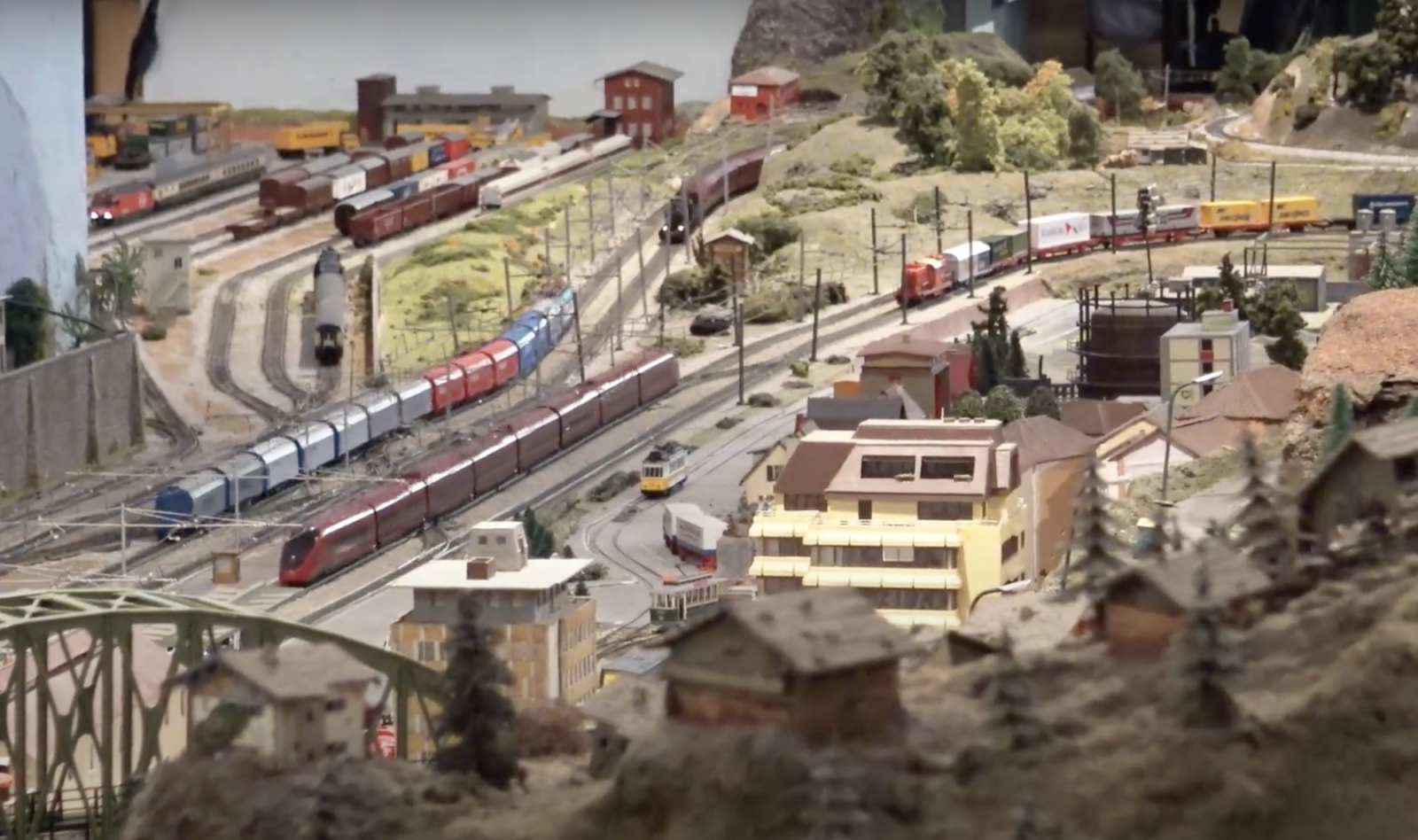
Plastic railroads
Plastico Ferroviario is a miniature model railway located in Brescia Castle. The Model Railroad is a popular attraction for visitors of all ages and provides a uniquely interactive way to learn about the history of rail transport in the region. The railroad model is a large-scale replica of the local rail system and includes several trains, stations, and other elements.
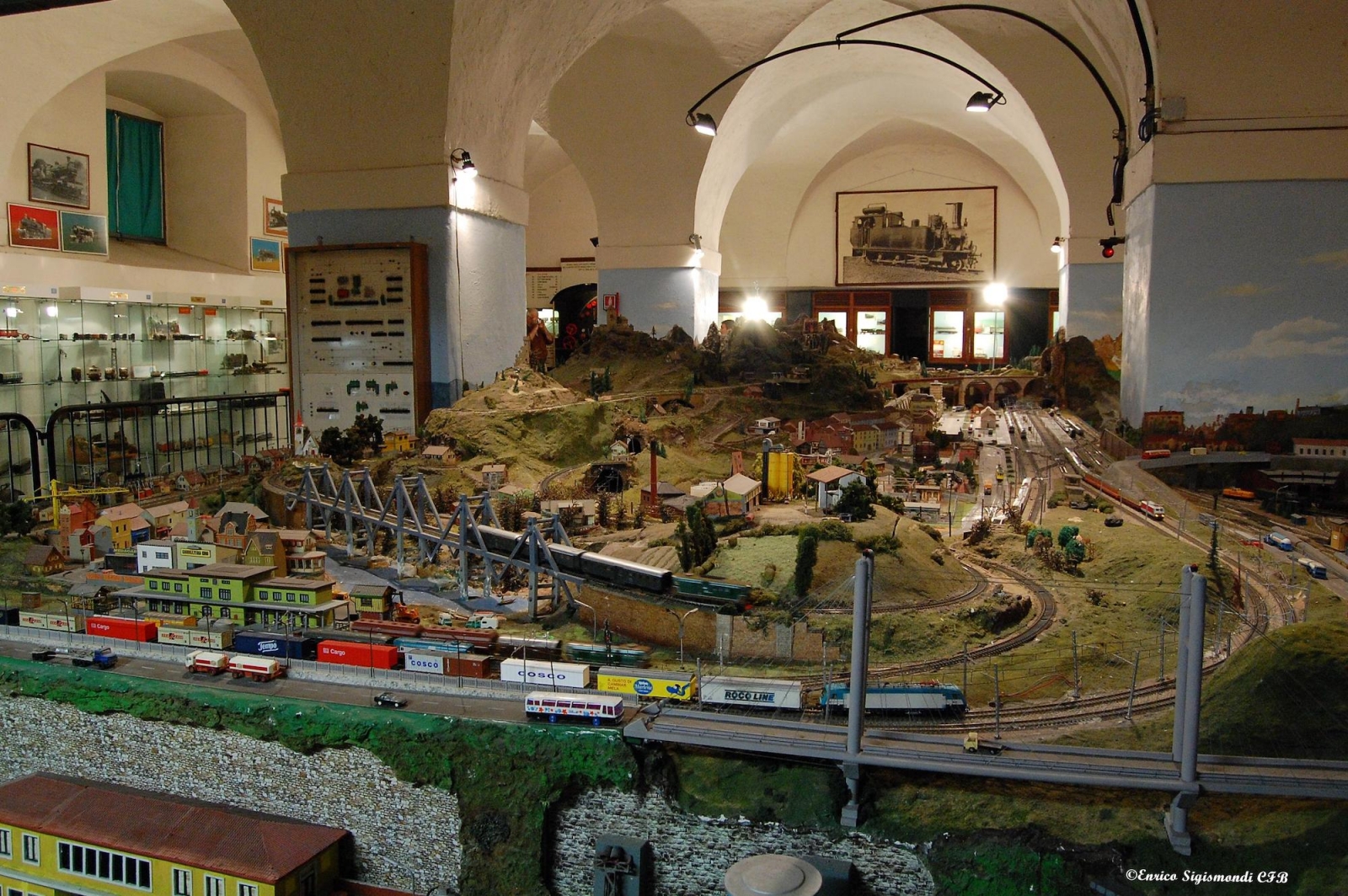
Visitors can view a model railroad and watch the trains move along the tracks as they pass through miniature versions of the region's towns and villages. The railroad model is also equipped with interactive features such as buttons and levers that visitors can use to control the trains and change the direction of the tracks.
Plastico Ferroviario is a unique attraction, especially for children that provide visitors with a fun and interactive way to learn about the history of rail transport in the region. It is a popular attraction for families and train enthusiasts and a must-see for anyone visiting Brescia Castle.
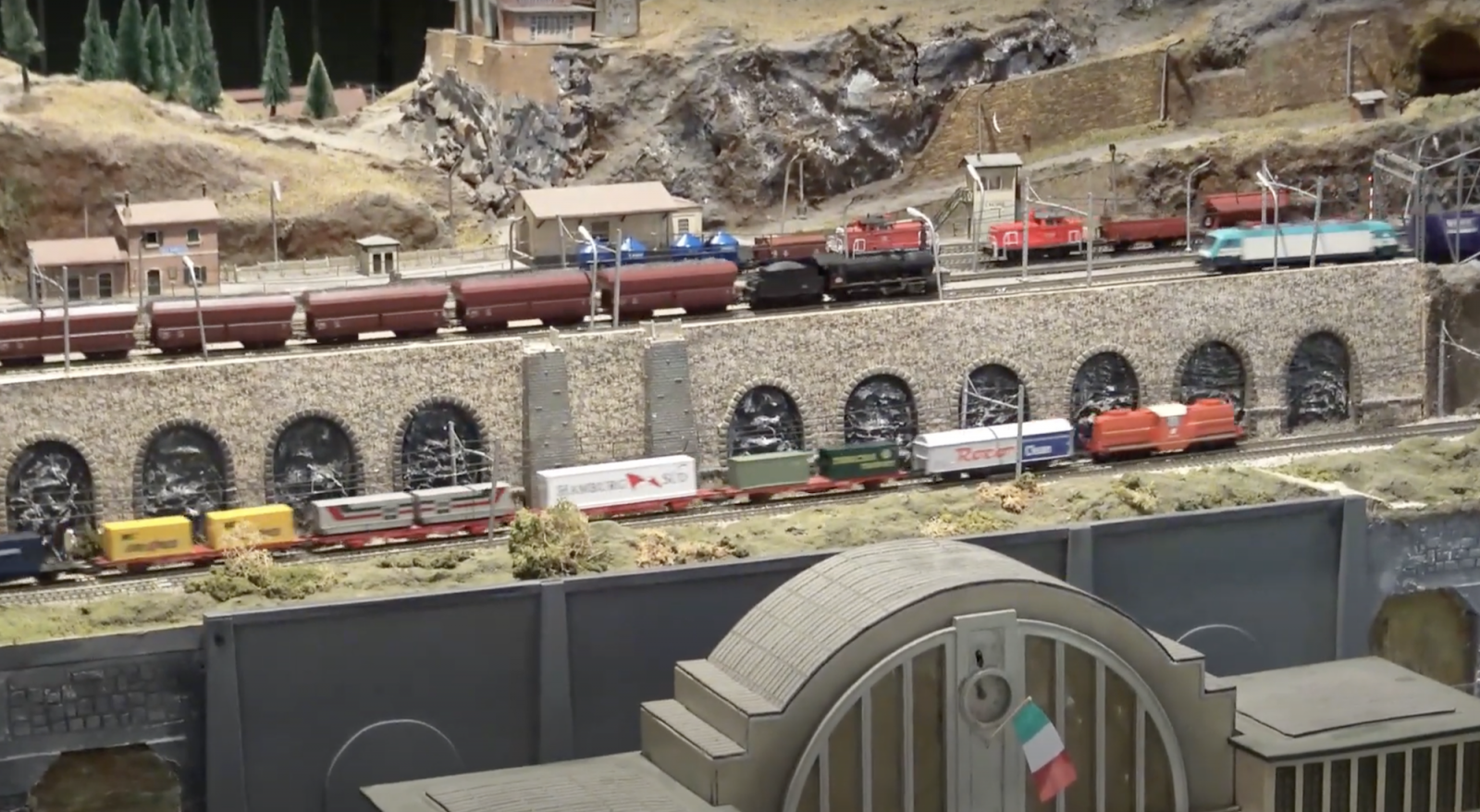
"La Montagnola" Botanical Garden
Giardino Botanico "La Montagnola" is a botanical garden located in the city of Brescia, Italy. The garden is located on the slopes of Cidneo Hill and covers an area of about 13,000 square meters. The garden was founded in the middle of the 19th century and was intended for the study and cultivation of plants. It was originally created as a private garden for the Morcelli family, prominent citizens of Brescia. The garden was later opened to the public and has been administered by the city of Brescia since the early 20th century.
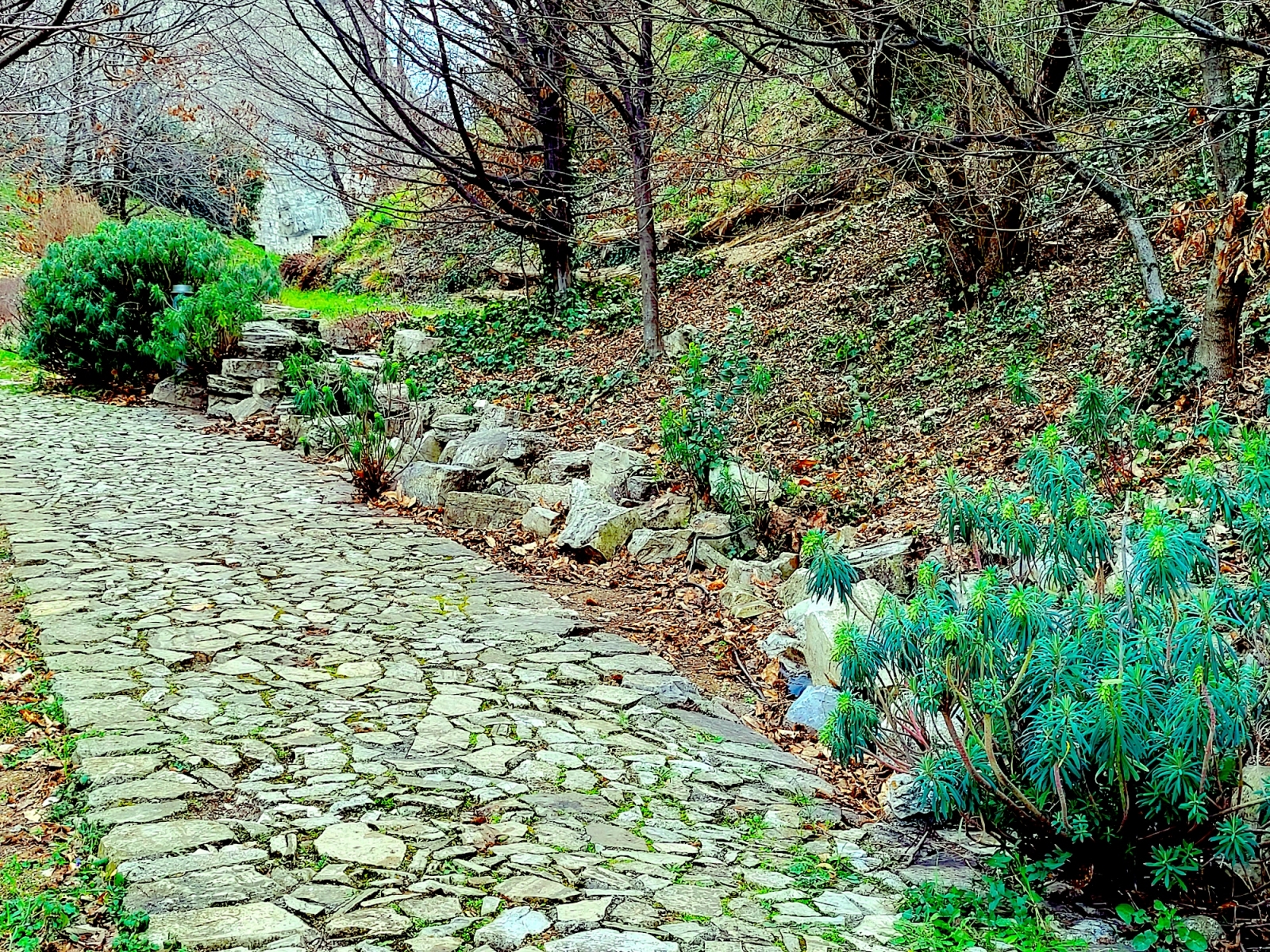
Today, La Montagnola Botanical Garden is home to a wide variety of plants from all over the world. The garden is divided into several sections, including a Mediterranean section, a tropical section, and a section dedicated to alpine plants. Visitors can explore the garden's many paths and admire the fine collection of trees, shrubs, flowers, and other plants.

The botanical garden "La Montagnola" also has several historic buildings and structures, including an orangery and a small pond. The garden is a peaceful and tranquil oasis in the city center and is a popular spot for tourists and locals alike. This place is a must-visit for anyone interested in the natural beauty of the region.
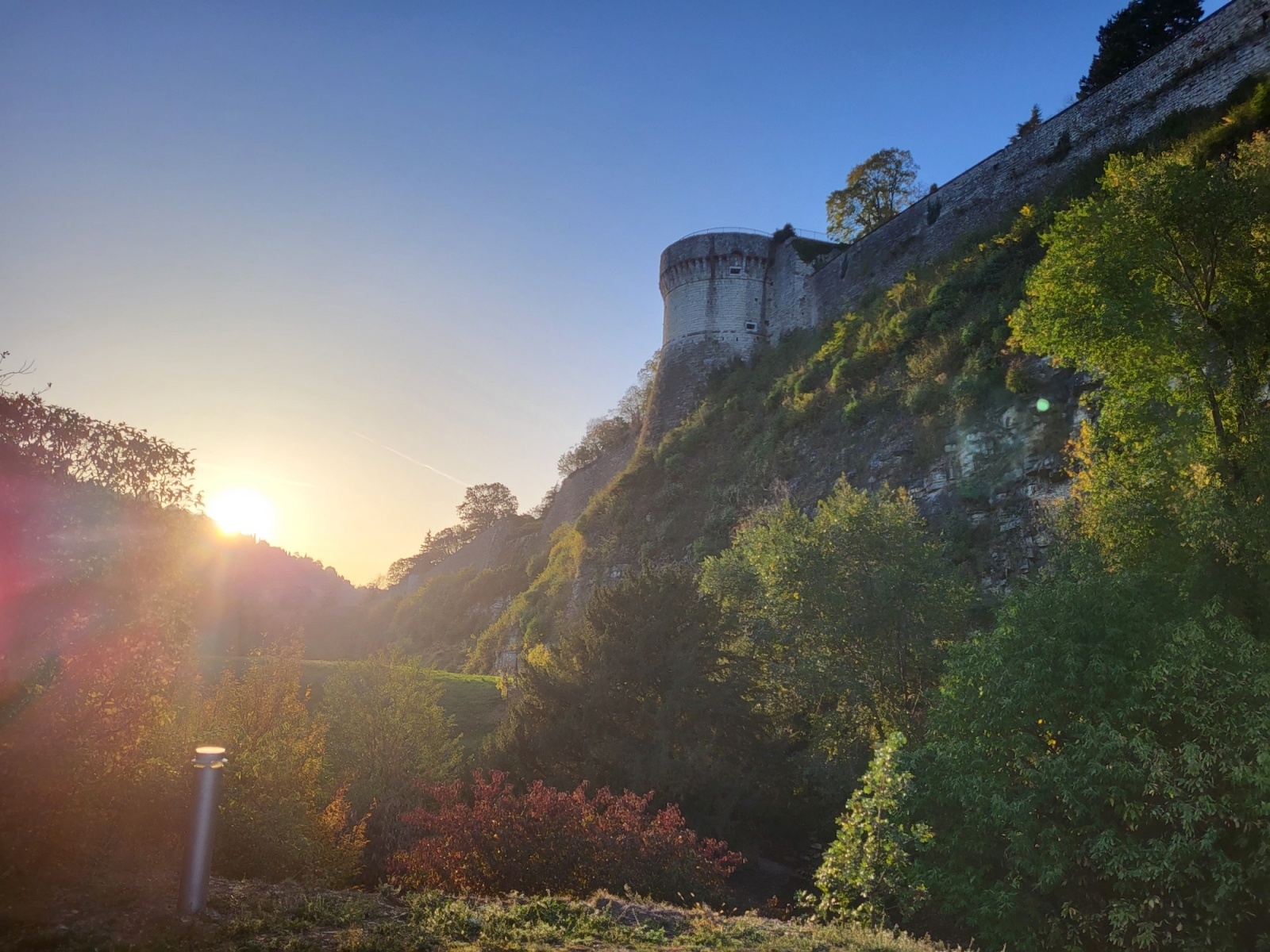
Serbatoio Montagnola is a historic water tank located in the botanical garden "La Montagnola". The reservoir was built in the early 20th century and was used to store water for the city's public fountains and irrigation systems. The reservoir is a large circular structure made of brick and concrete. It has a capacity of about 4500 cubic meters and is supported by a series of arches and columns. The tank is topped with a domed roof providing protection from the weather.
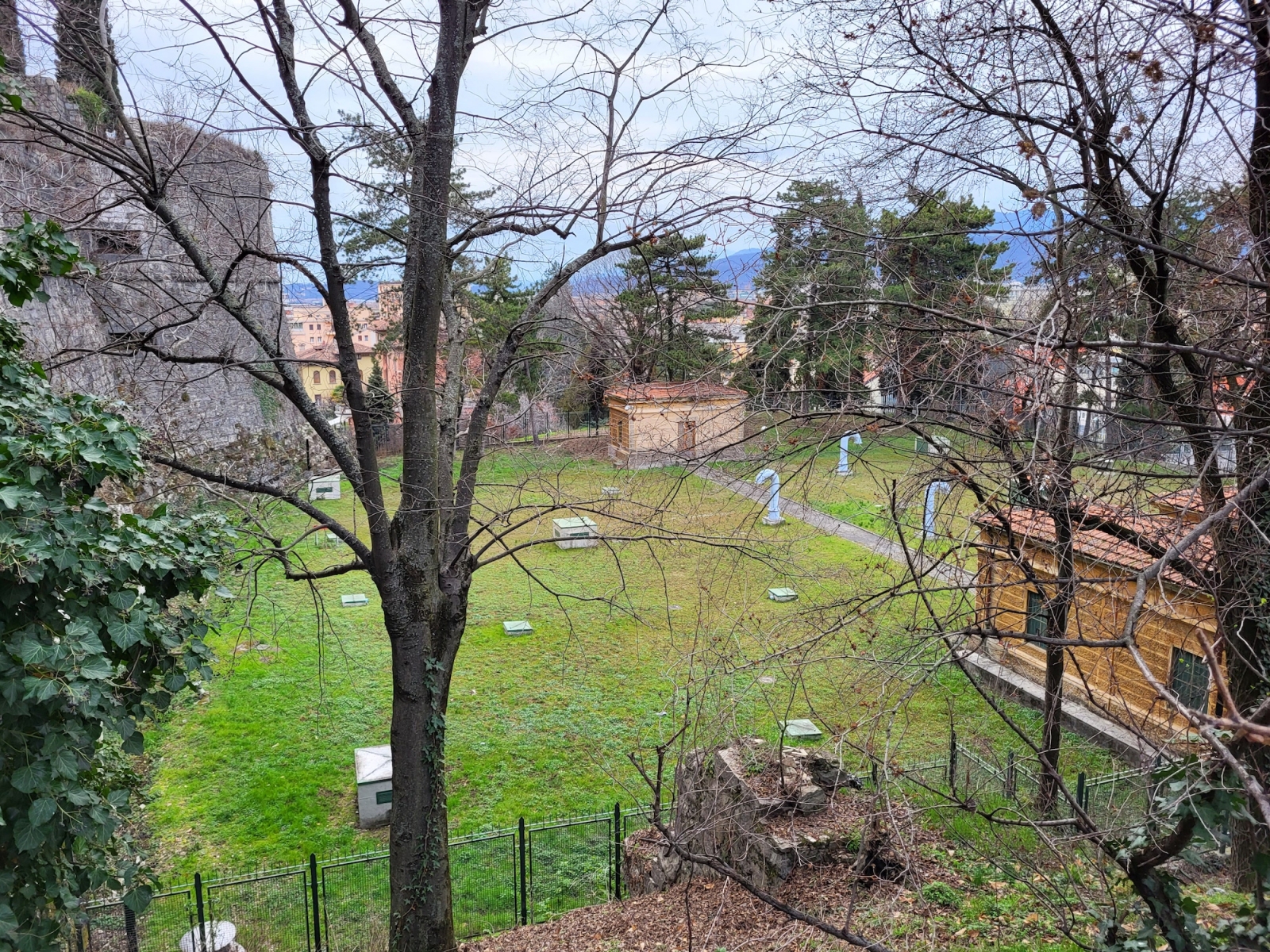
Today Serbatoio Montagnola is no longer used as a water reservoir, but remains an important historical and architectural landmark of the botanical garden "La Montagnola". The reservoir has been restored and is open to the public, allowing visitors to view its interior and learn about the history of water management in the city.
In addition to its historical and architectural significance, Serbatoyo Montagnola also provides a unique vantage point from which to view the Botanical Garden "La Montagnola" and its surroundings. Visitors can climb to the top of the reservoir and enjoy panoramic views of the city and the surrounding hills.

Vigneto Pusterla
Vigneto Pusterla is a historic vineyard located in Brescia Castle, Italy. The vineyard is named after the Pusterla family, prominent citizens of Brescia in the 16th and 17th centuries. The vineyard was originally planted in the 16th century and used to produce wine for the personal use of the Pusterla family. Over time, the vineyard became a popular destination for wine lovers and tourists, and eventually, it was recognized as an important cultural and historical landmark of Brescia.
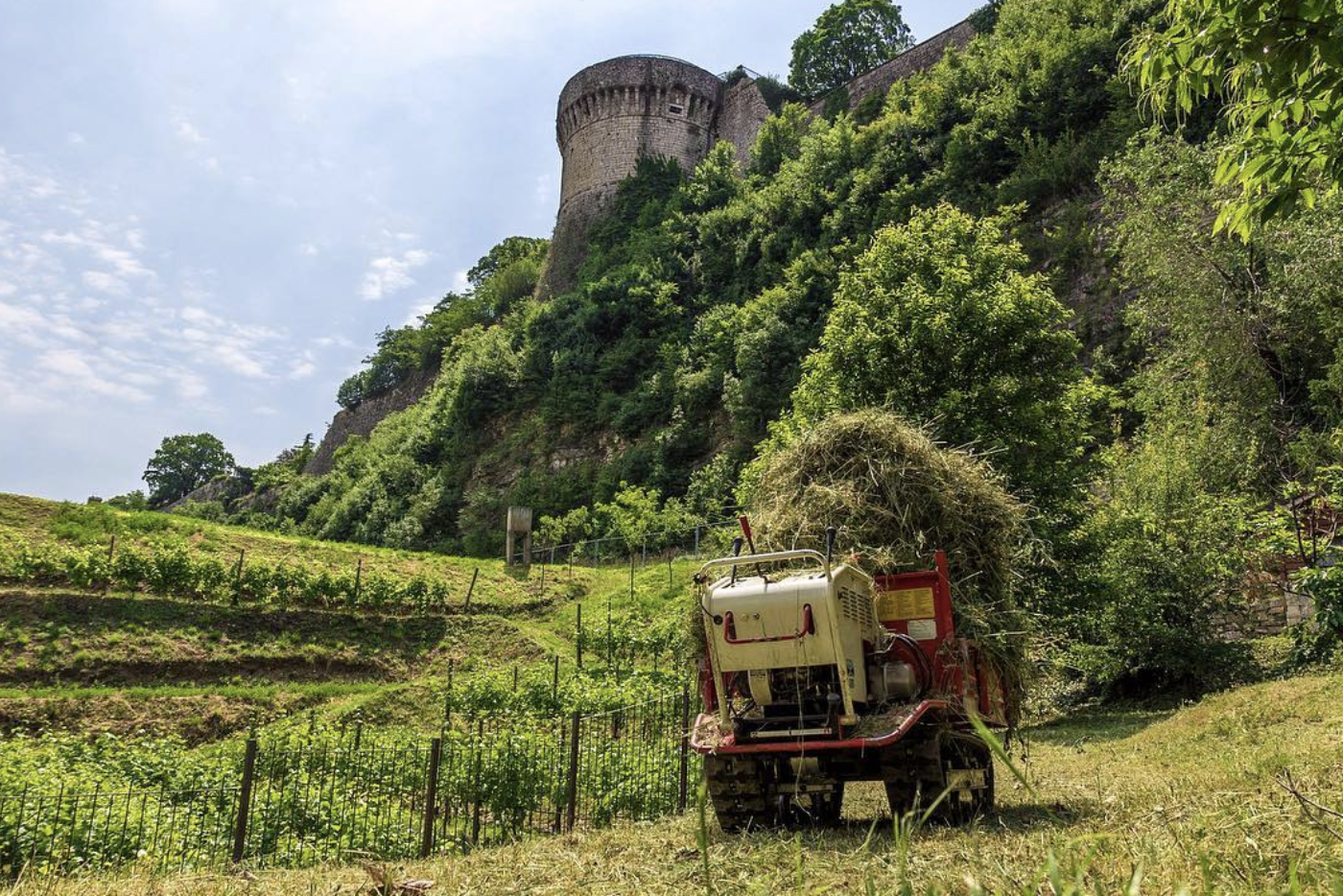
Today Vigneto Pusterla is administered by the city of Brescia and is open to the public. The vineyard covers an area of about 2,500 square meters and is planted with several different grape varieties, including Barbera, Chardonnay, Pinot Nero, and Riesling. Visitors to Vigneto Pusterla can take a private excursion in English with a local private tour guide in Brescia through the vineyard and learn about the history of winemaking in the region. They can also taste the wines from the vineyard and buy bottles of the wines they have picked to take home as souvenirs. Vigneto Pusterla is a unique and fascinating attraction that offers visitors a glimpse into the rich cultural heritage of Brescia.
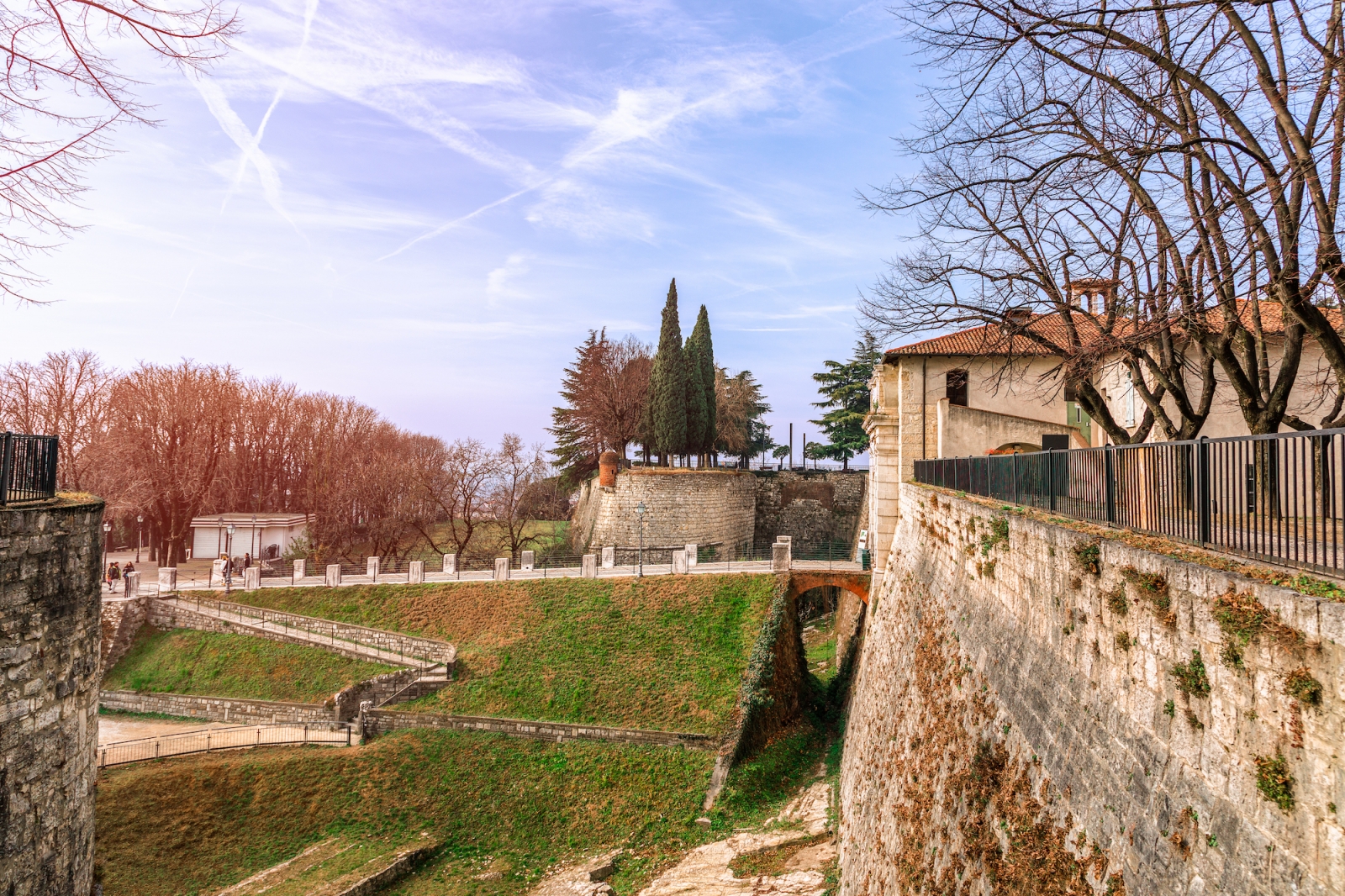
Monument to the Fallen
The Pro Patria monument is located in Brescia, Italy. The monument is also known as the Monument to the Fallen of Brescia and is dedicated to the memory of the soldiers from the city who died during World War I. The Pro Patria monument was designed by the Italian architect Marcello Piacentini and was inaugurated in 1932. It is a large and imposing structure, consisting of a tall tower with a bronze statue of a soldier on top. The soldier is depicted holding a sword and a shield and is looking out over the city.
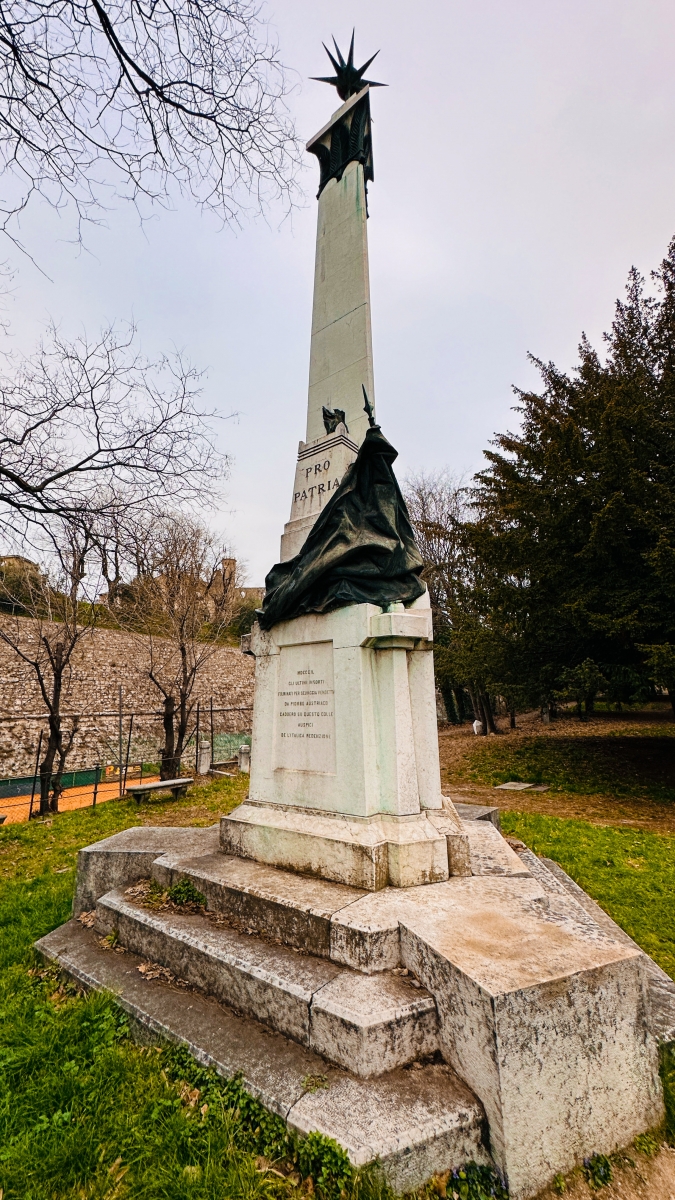
At the base of the tower, there are four large sculptures, which represent the virtues of loyalty, honor, courage, and sacrifice. The base of the monument also features a large bronze relief, which depicts scenes from the war, including soldiers marching off to battle and wounded soldiers being tended to. The Pro Patria monument is an important landmark in Brescia and serves as a reminder of the sacrifices made by the soldiers from the city during World War I.
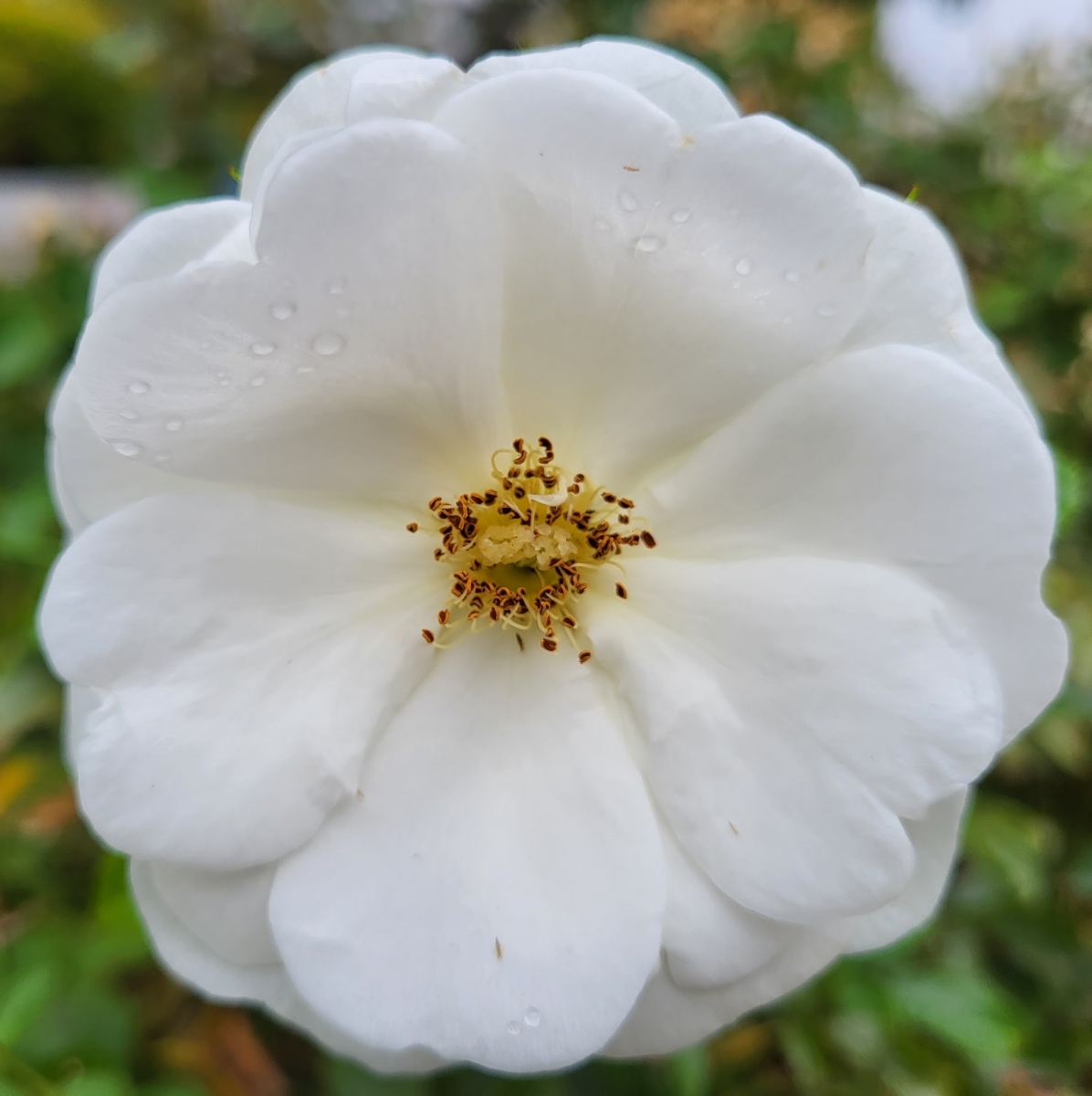
Monumento a Giuseppe Ragazzoni
Monument to Giuseppe Ragazzoni is a pyramid located in the castle of Brescia. The pyramid was created by the Italian sculptor Angelo Zanelli and erected in honor of Giuseppe Ragazzoni, a soldier and hero of the First World War. Giuseppe Ragazzoni was born in Brescia in 1892 and joined the Italian army in 1915 to fight in World War I. He was known for his bravery and was awarded several medals for his service, including the Gold Medal for Military Valor. He died in action in 1918 at the age of 26.
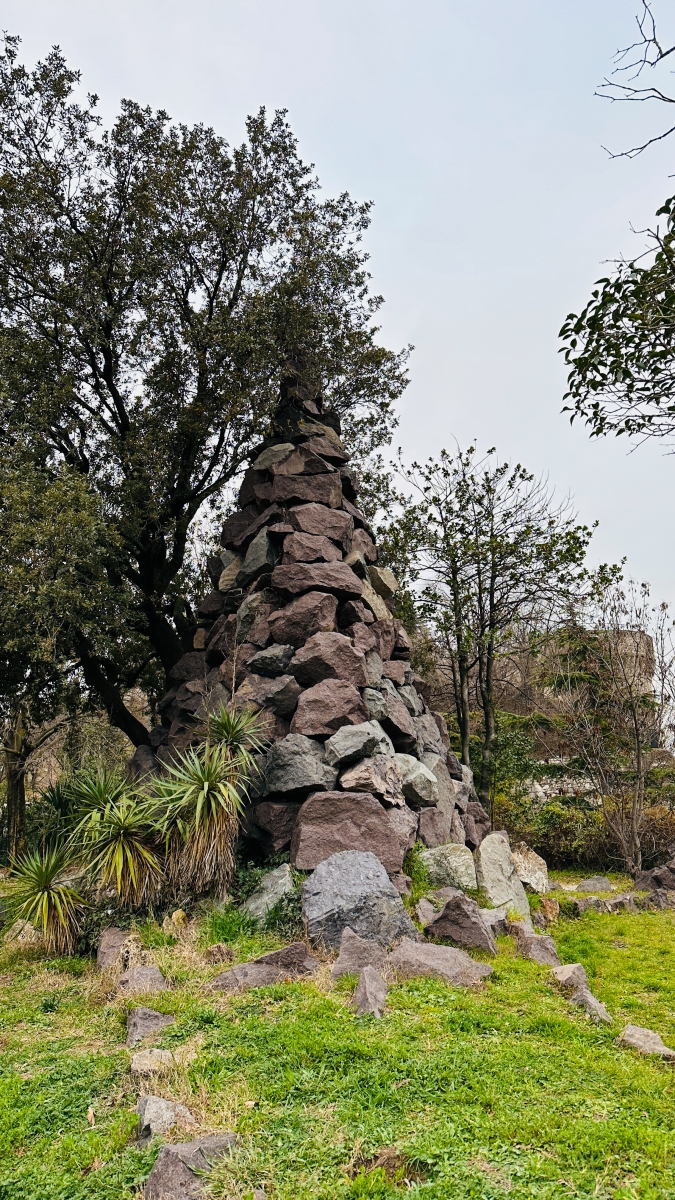
The pyramid monument to Giuseppe Ragazzoni geologist naturalist is located in the courtyard of the castle of Brescia and is constructed with flat typical stones collected particularly in the Brescia region. The is a bronze medallion with the portrait of a soldier Giuseppe Ragazzoni. It is an important cultural and historical landmark of Brescia and serves as a reminder of the sacrifices made by soldiers during the war. It is also a tribute to the heroism and bravery of Giuseppe Ragazzoni and serves as a symbol of the city's pride in its military heritage.
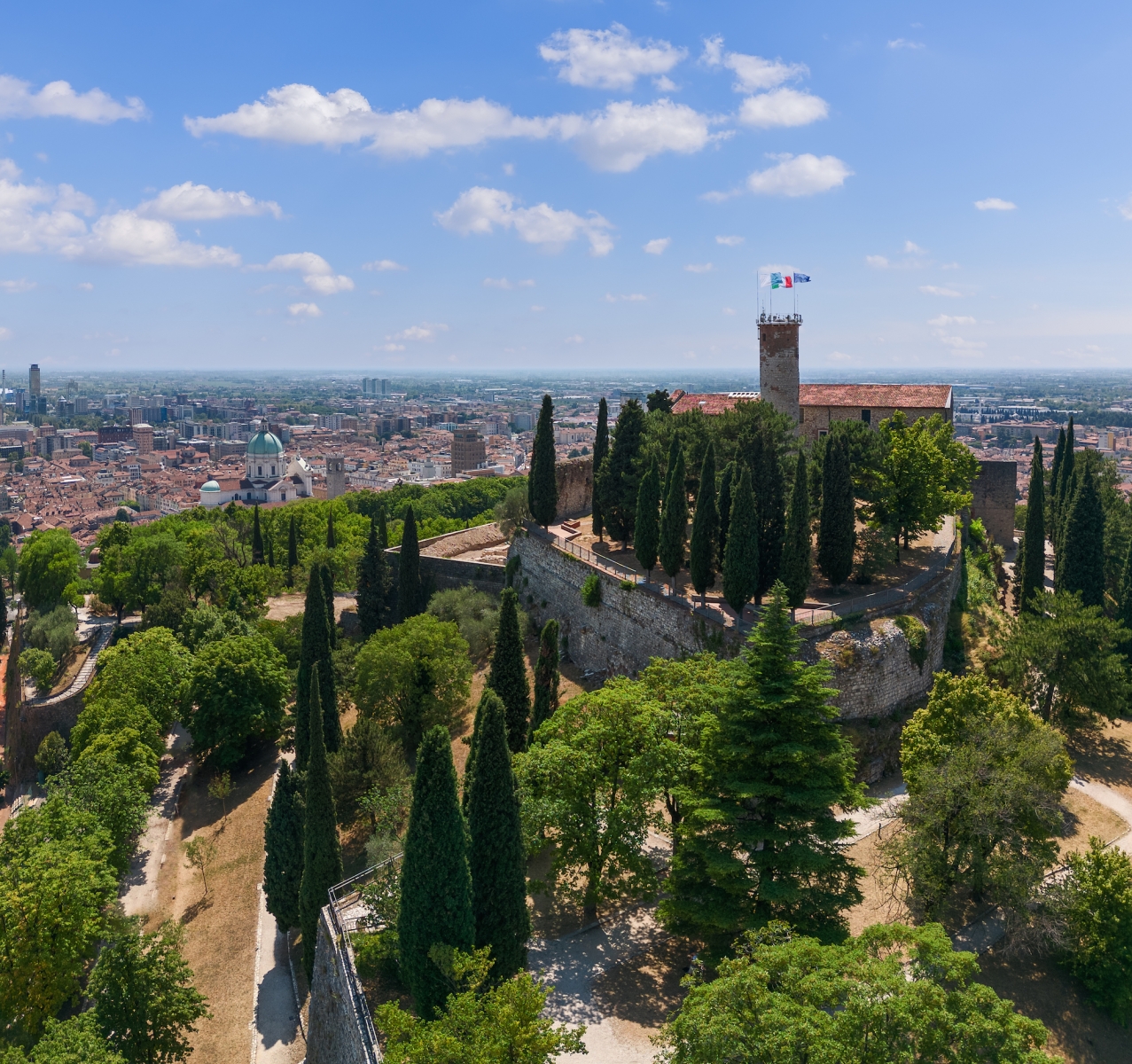
Galleria Tito Speri
The Tito Speri Gallery is an underground tunnel located in the mountain below the castle of Brescia. The tunnel was built during the Renaissance in the mid-16th century and named after Tito Speri, a Brescia captain executed by the Austrians during the Italian Risorgimento in 1853. The tunnel was originally built as a secret passage connecting Brescia Castle to the nearby monastery of Santa Giulia. It was used by soldiers and monks as an escape route during wars and conflicts. The Tito Speri Gallery is about 200 meters long and is built of stone.
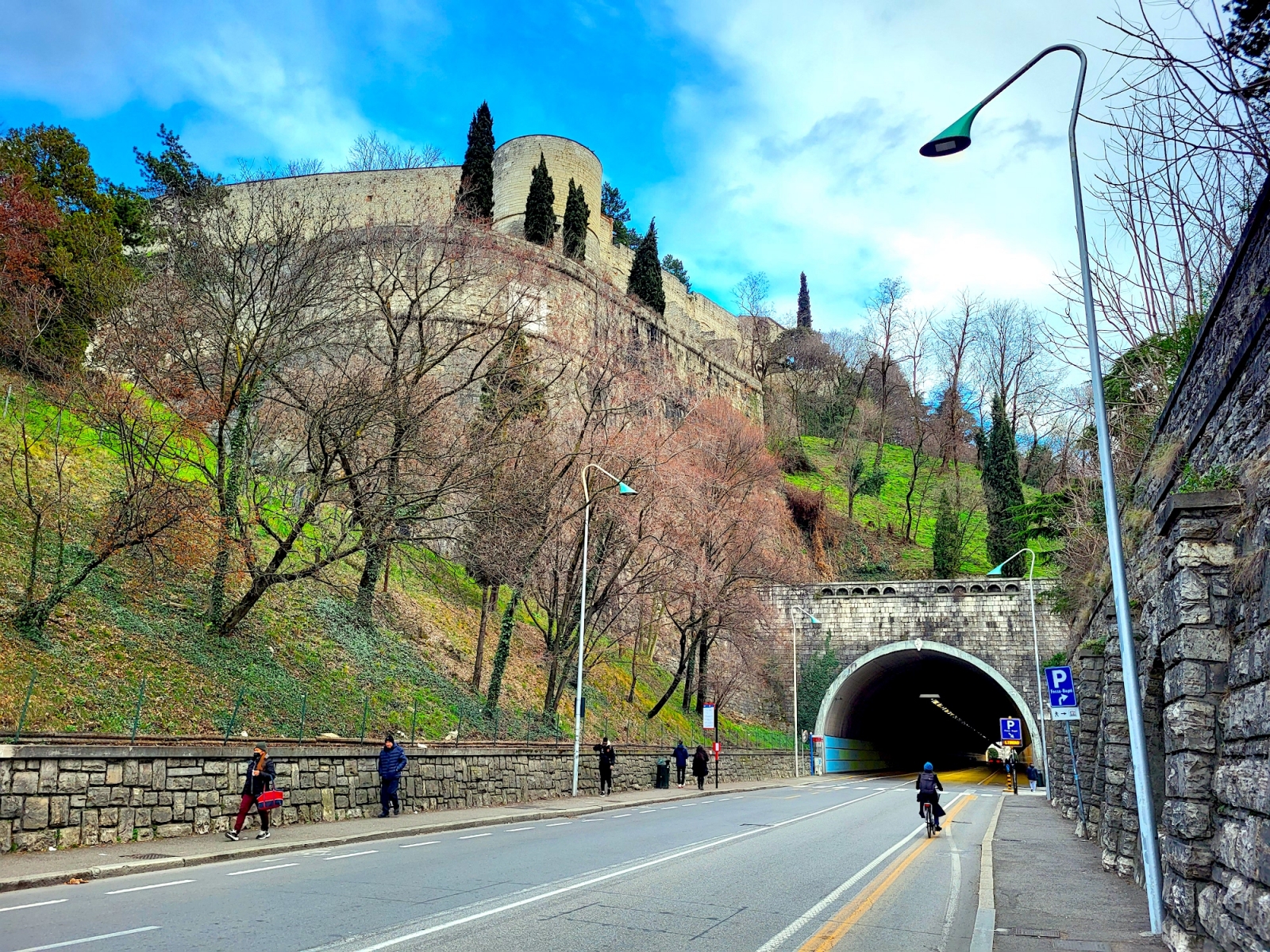
Today, the Tito Speri Gallery is a popular tourist attraction and is open to the public and motor vehicles. Visitors can explore the underpass and learn about its history and significance. Access to the territory of the Castle of Brescia is free and open, and visiting the museums of the fortress is allowed only with the purchase of a ticket to the Museo delle Armi Luigi Marzoli and the Museum of the Italian Lioness Risorgimento. Brescia Castle is open every day, 365 days a year. Opening hours may vary depending on events, but it is usually open from Monday to Sunday from 6:00 to 23:00.
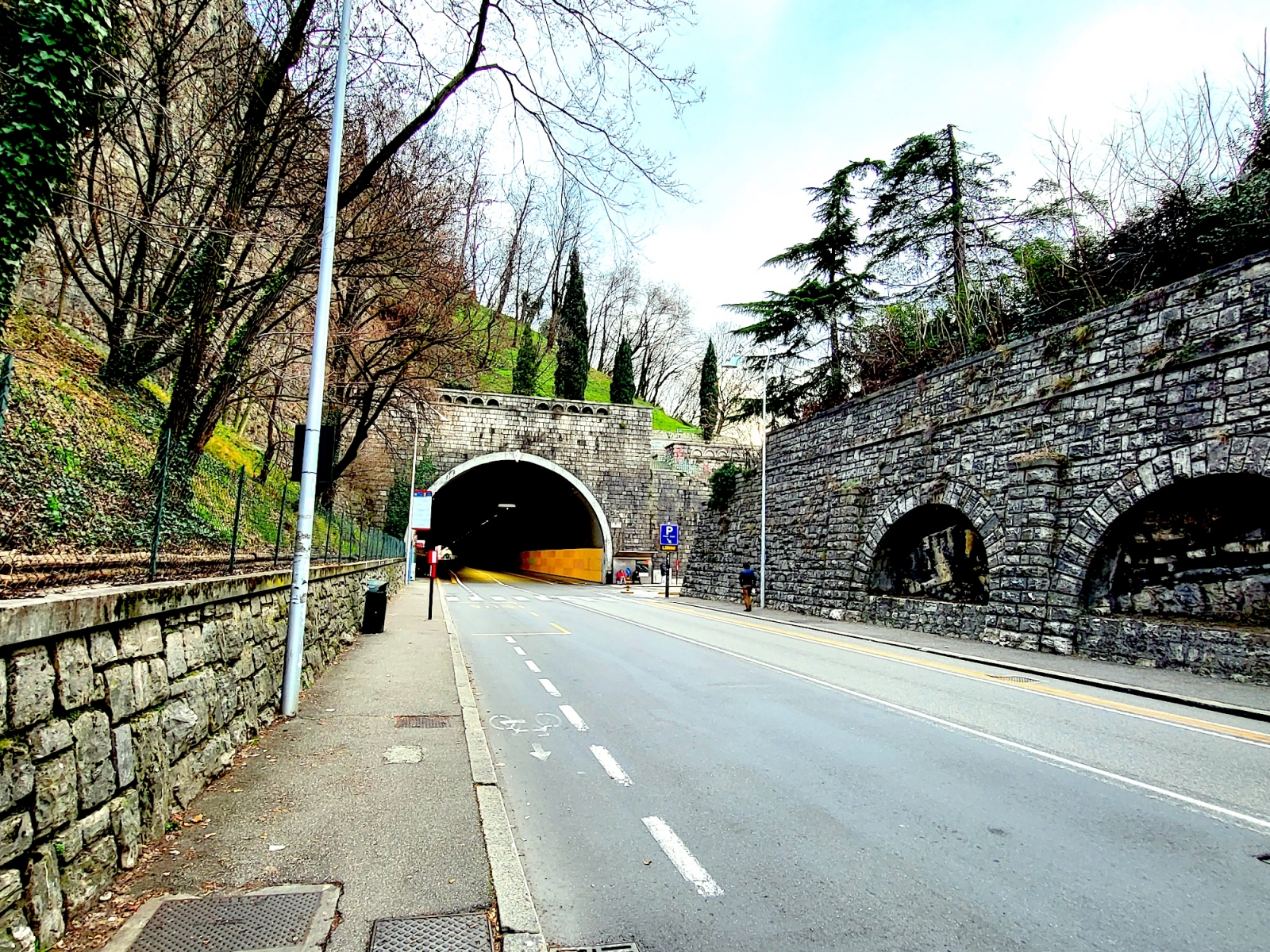
If you're planning a trip to Brescia, it's a great idea to hire a local, private English-speaking tour guide in Italy who will show you all the sights you shouldn't miss. Brescia is a city rich in history and culture, and a local tour guide will help you make sense of it all. In addition to showing you around the Castle, a private local tour guide in Brescia can also show you other places of interest in the city, such as the ancient Roman ruins at the Capitoline and the UNESCO World Heritage Site San Salvatore Monastery. They can also take you on a food and wine tour, introducing you to the delicious cuisine and wines of the region.
Structure, buildings, and monuments of the Castle in Brescia
As you approach Brescia, you are greeted by a magnificent sight: the Castle towering over the city. It covers a vast area of Cidneo Hill, dominating the landscape with its imposing presence. This is no ordinary Castle, but a fortress built to stand the test of time and defeat any enemy that dares to challenge its might. Upon entering, you are greeted by the lion of San Marco and the coats of arms of the Venetian rectors, symbols of power and prestige. On both sides are the bastions of San Faustino and San Marco, their size and power make you awe. But this is only the beginning of your journey through the rich history and architecture of the castle.
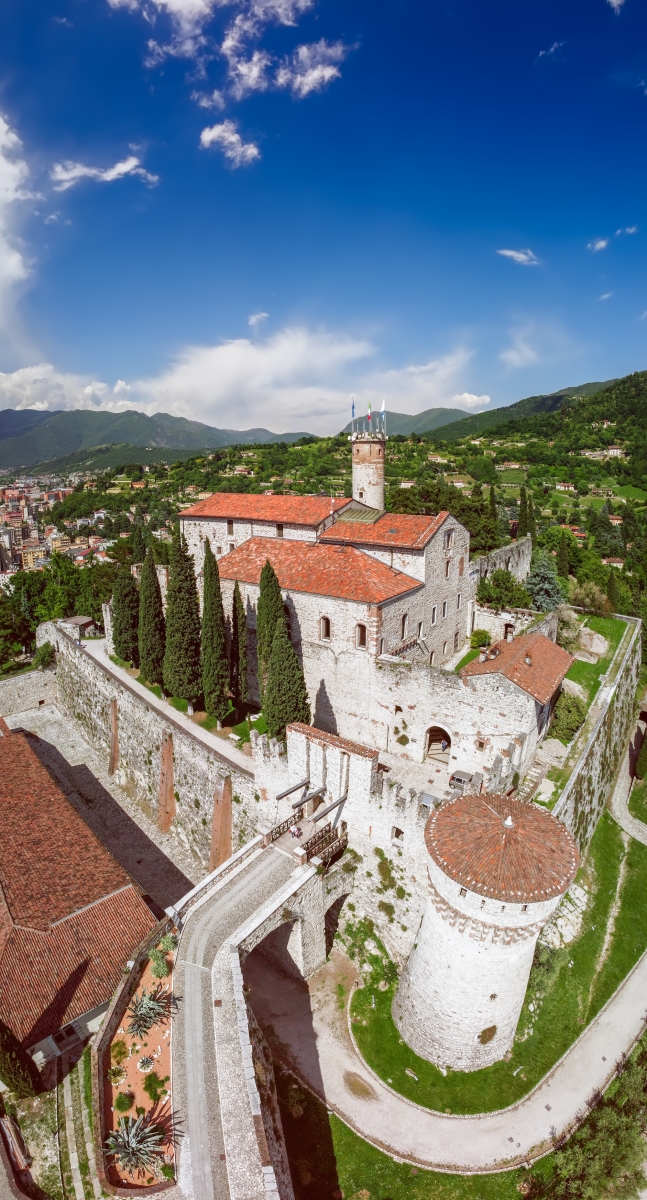
Turning to the right, you will see the San Pietro bastion, where a beautiful sixteenth-century well, adorned with two stone lions by Domenico Ghidoni, catches your eye. Turning left, you will pass the bell tower of the former sanctuary of Santo Stefano Nuovo and the Hainau building, named after the Habsburg marshal who led the military operations against the Bres rebels in 1849. The castle is a testament to the strength and resilience of the inhabitants of Brescia.
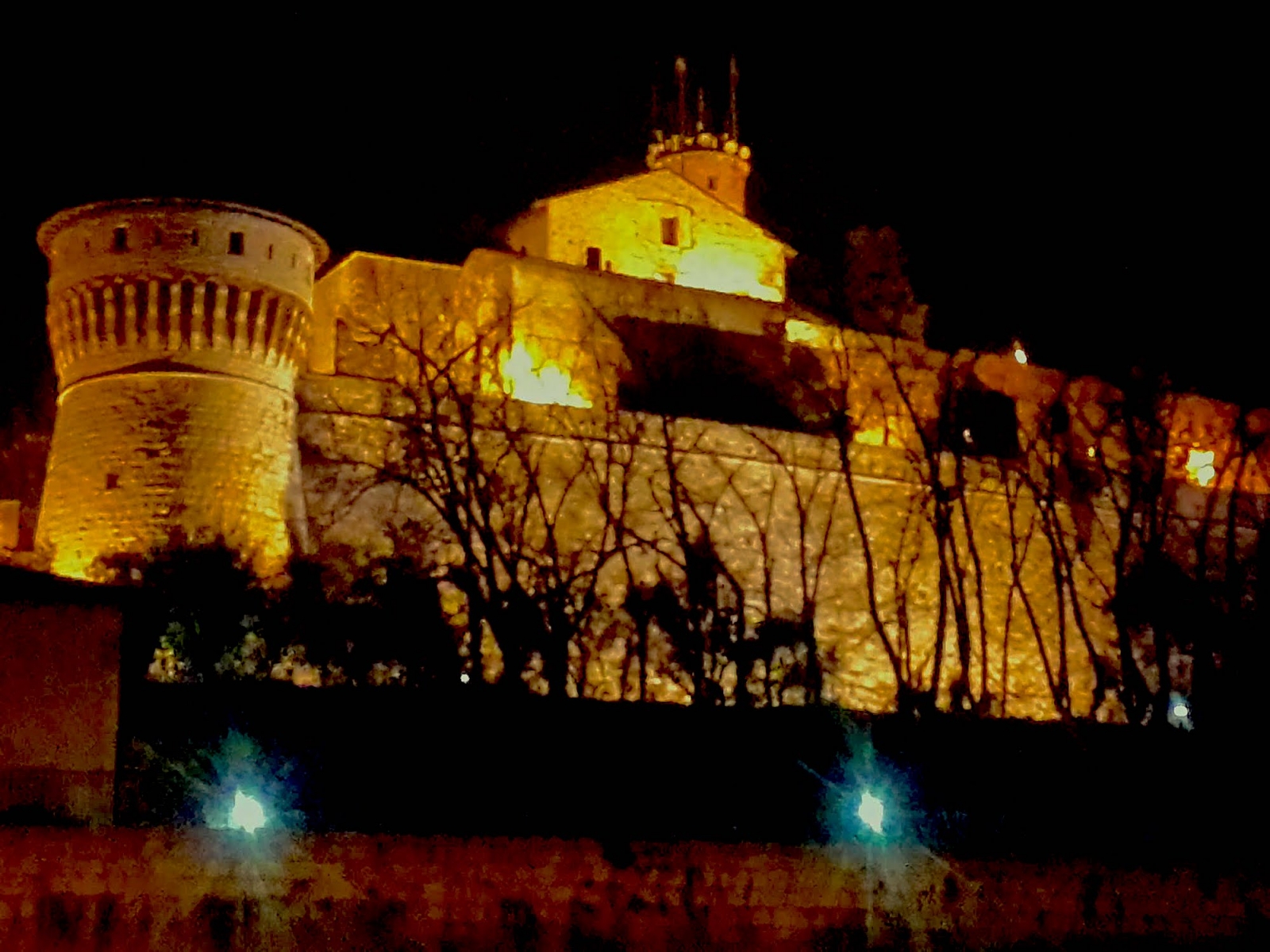
But the history of the castle is not only the history of military power and religious devotion. Climbing up to the Bastion of San Faustino, you come across a unique steam locomotive that was once the starting point of the Brescia-Edolo route in the early 1900s. The castle is not only a symbol of power but also a center of industry and progress. As you move further into the Castle, you come across Piccolo Miglio, now used as an exhibition space, and Grande Milio, which houses the Risorgimento Museum, reminding you of the struggles and triumphs of the Italian people.
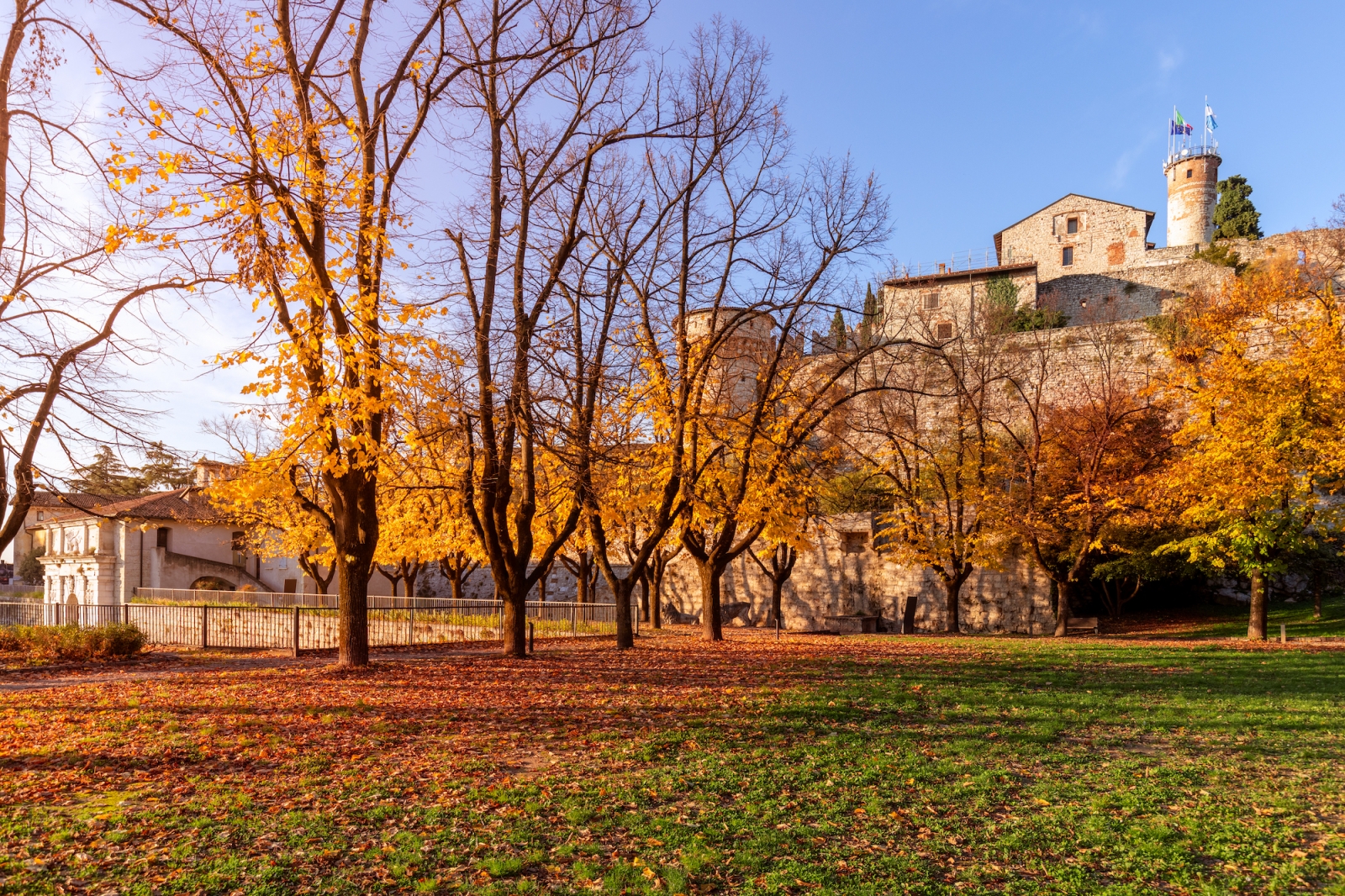
But the true beauty of the castle lies in its gardens. Here you will see the Coltrina Tower, the Pit of the Martyrs, where members of the Resistance were executed in 1945, and the French Tower. The rich history of the castle is not only battles and victories, but also self-sacrifice and perseverance. And as you climb the ramp, you reach the 14th-century fortress, its double drawbridge attesting to the castle's impregnability. To the right stands the Tower of Prisoners, and to the left, you can still see traces of the battlements of the Ghibellines, reminiscent of the ancient origins of the castle.
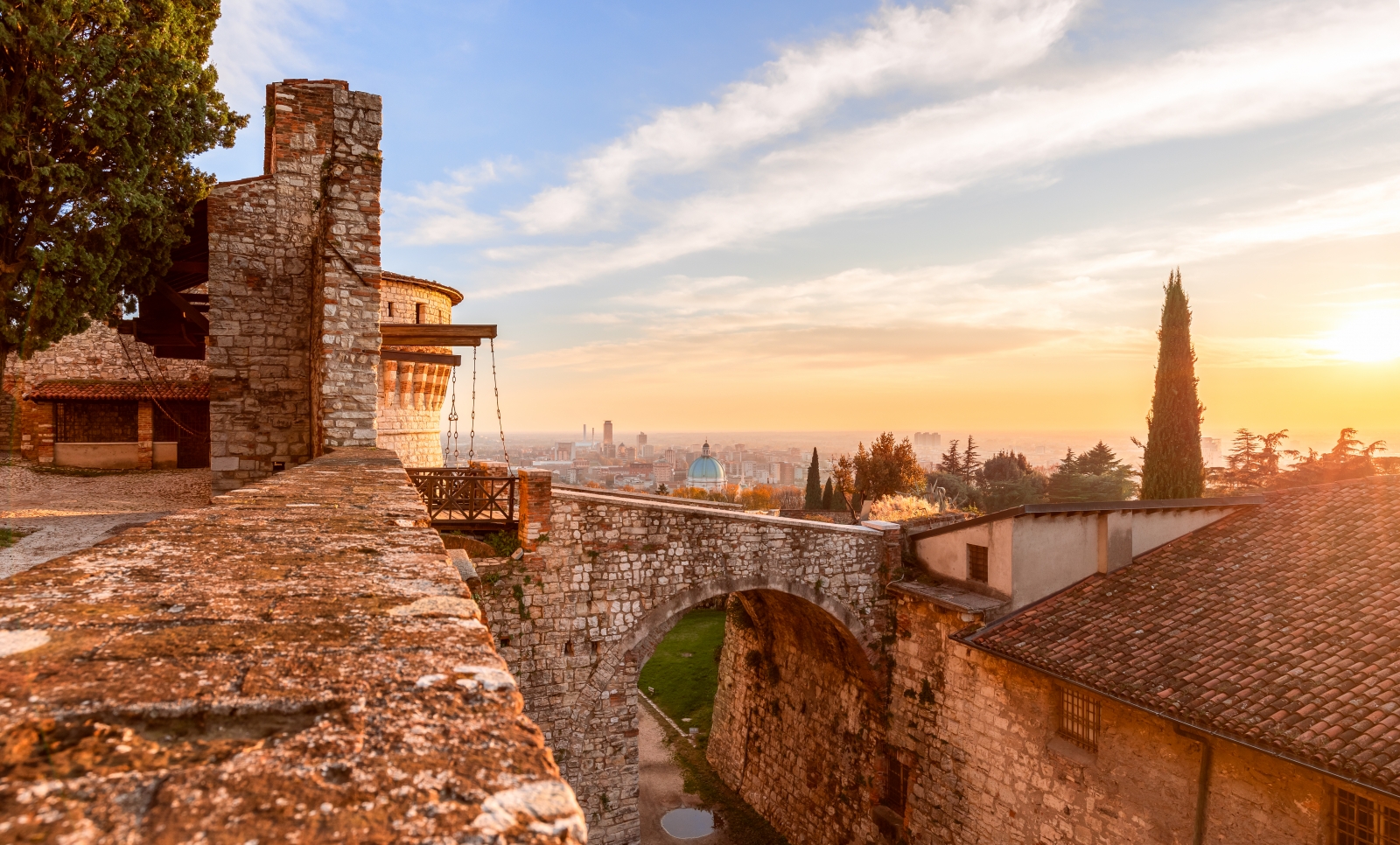
At the top of the fortress is a square with the Mirabella Tower, which can be reached via a 14th-century drawbridge. Here you can enter the keep, which houses the Luigi Marzoli Arms Museum and displays the remains of the foundations of a Roman temple. The past of the Castle is associated not only with knights and armor but also with innovation and ingenuity. Brescia Castle is not just a sight of the city, but a testament to the resilience, strength, and beauty of the Italian people. A journey through the castle is a journey through the history of Italy itself, a story of battles and victories, sacrifices and triumphs, progress and innovations. And when you leave the Castle, you take with you the memory of a place that has stood the test of time and people who fought and won against all odds.
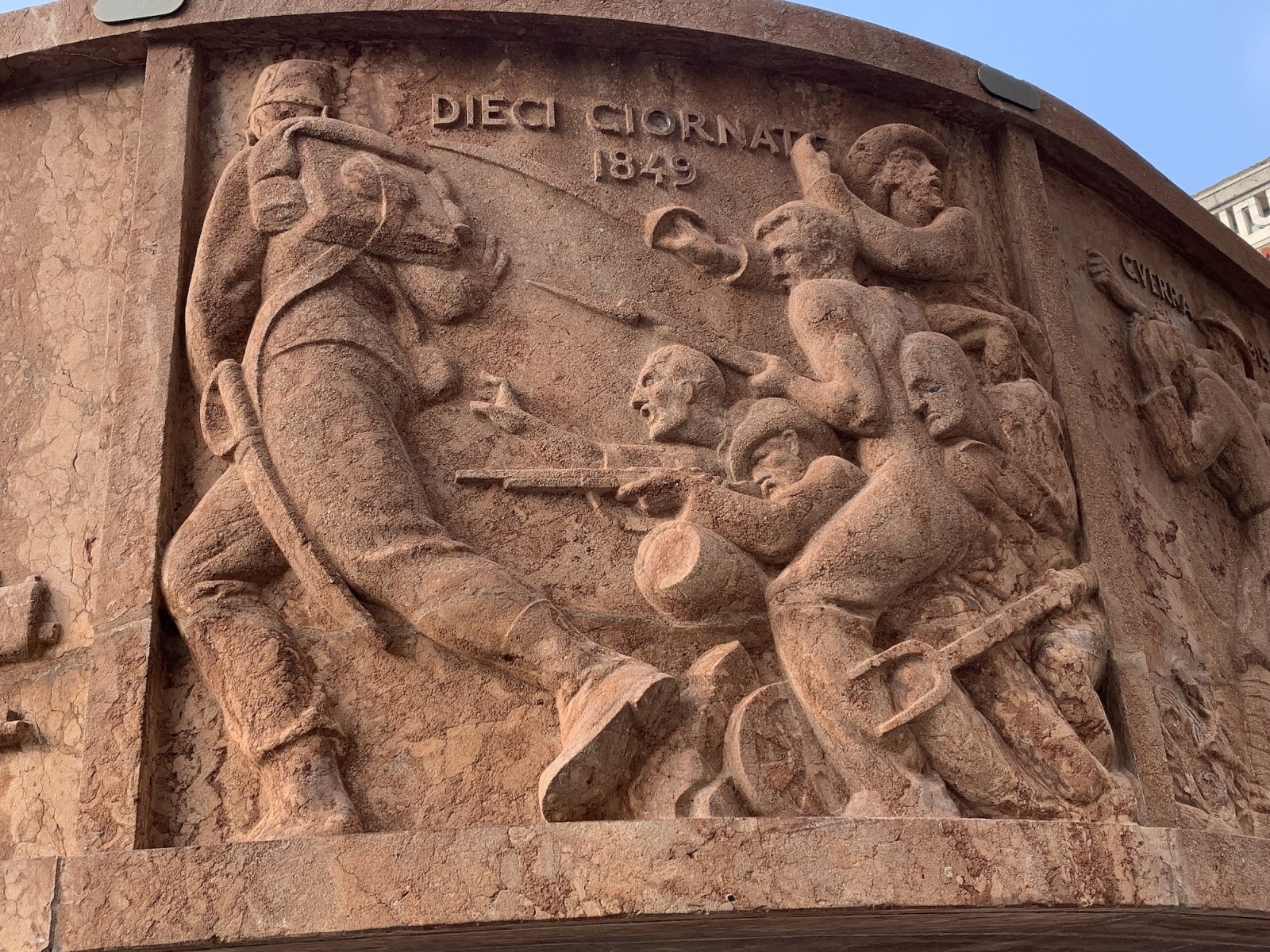
Ten days of Brescia
The year was 1849, and the Austrian Empire ruled the northern Italian city of Brescia with an iron fist. But the citizens of Brescia were tired of living under the rule of foreigners and were determined to fight for their freedom. Under the leadership of the courageous patriot Tito Speri, they raised an uprising that will go down in history as the Ten Days of Brescia.
The timing of the uprising was important as it coincided with the Battle of Novara, when Charles Albert, King of Sardinia, was trying to recapture Italy from the Austrians. The Brescians, unaware of the outcome of the battle, launched an attack on March 23, 1849, catching the Austrian troops by surprise. The Austrians retreated to the safety of the castle and began a fierce bombardment of the city. For the next eight days, the Brescians fought valiantly, erecting barricades throughout the city and engaging in violent clashes with the Austrians. But on the ninth day, Austrian reinforcements arrived and the city was completely surrounded. General Julius Jacob von Haynau, known as the "Hyena of Brescia", arrived and demanded the unconditional surrender of Brescia. But the inhabitants of Brescia refused to surrender without a fight. They continued to resist until the early hours of 1 April, when they finally realized that their forces had run out.
The leaders of the uprising made the difficult decision to surrender, hoping to save the lives of their fellow citizens. But their hopes were in vain. The next day, Austrian troops sacked the city and began a massacre that claimed the lives of more than 1,000 citizens. Brescia's historic monuments have been damaged, leaving scars in the city that will never fully heal. Despite brutal repression, the fierce resistance of the Brescians earned them the nickname "Leonessa d'Italia" or "The Lioness of Italy". The memory of their sacrifice will inspire future generations of Italians to fight for their freedom and their bravery will never be forgotten.
The lion-hearted courage displayed by Brescia during the Risorgimento earned the city the nickname Leonessa d'Italia, Lioness of Italy, coined by Aleardo Aleardi and adopted by Giosuè Carducci in his DELLE ODI BARBARE, book V, composition dated May 1877, concluding with these famous verses:
Lieta del fato Brescia raccolsemi,
Brescia la forte, Brescia la ferrea,
Brescia leonessa d'Italia
beverata nel sangue nemico
“Glad of fate Brescia picked me up,
Brescia the strong, Brescia the iron,
Brescia lioness of Italy
drunk in enemy blood”
OF THE BARBAR ODES
BOOK V.
TO VICTORY AMONG THE RUINS OF THE TEMPLE OF VESPASIANO IN BRESCIA
Giosuè Carducci
14 - 16 May 1877
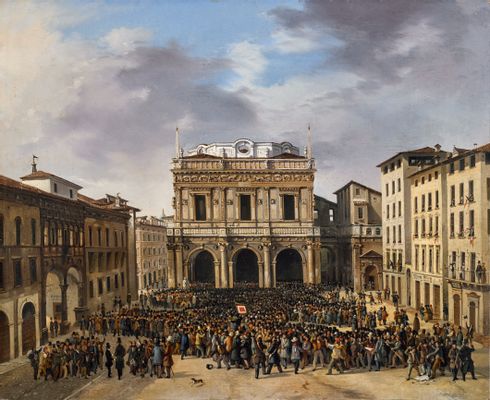
Exploring the castle of Brescia is an adventure that every history buff should experience, especially when accompanied by a local tour guide in English who knows all the ins and outs of the castle like the back of his hand. The castle, a symbol of the rich and varied history of Brescia, has been the site of many battles, rebellions, and sieges. Your tour guide will bring the history of the castle to life, taking you on a journey through the ages, from its Roman origins to its role as a fortress during the Middle Ages and the Renaissance.
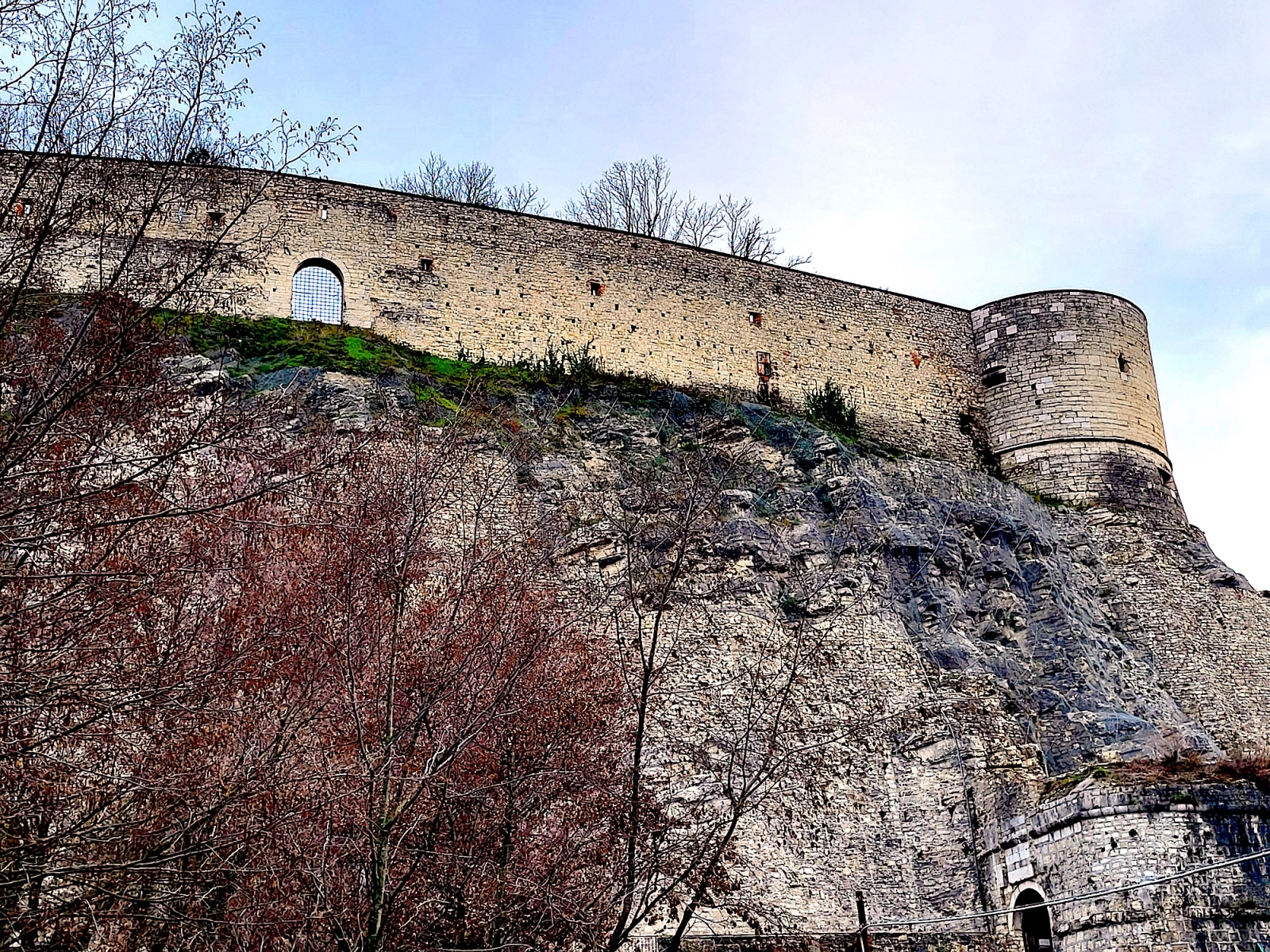
You will marvel at the impressive towers and ramparts, discover hidden tunnels and passageways that once served as secret escape routes, and take in breathtaking views from the ramparts. Your English-speaking tour guide in Brescia will tell you fascinating stories about the castle's past, from the infamous Ten Days of Brescia to the castle's role in the Risorgimento movement. As you explore the many rooms and chambers of the castle, you will feel like you are stepping back in time as you delve into the fascinating history of this remarkable structure. Your tour guide will point out the castle's most impressive architectural features and tell the stories of the castle's former inhabitants, including the powerful Visconti family. A private excursion with a knowledgeable local tour guide in Italy in Brescia Castle is an experience that will leave you with a deeper understanding of the rich history of the castle and the role it played in shaping the past of Brescia, and indeed all of Italy. So join us on a journey through time!

How to get to Brescia Castle
Brescia Castle is about 2 km from Brescia Train Station, while the nearest metro station is San Faustino, about 350 meters away. If you are coming by bus, the nearest stop is in Via Fossa Bagni, at the foot of Cidneo Hill, from where you can take lines 2, 6, 10, 11, 17, and 18.
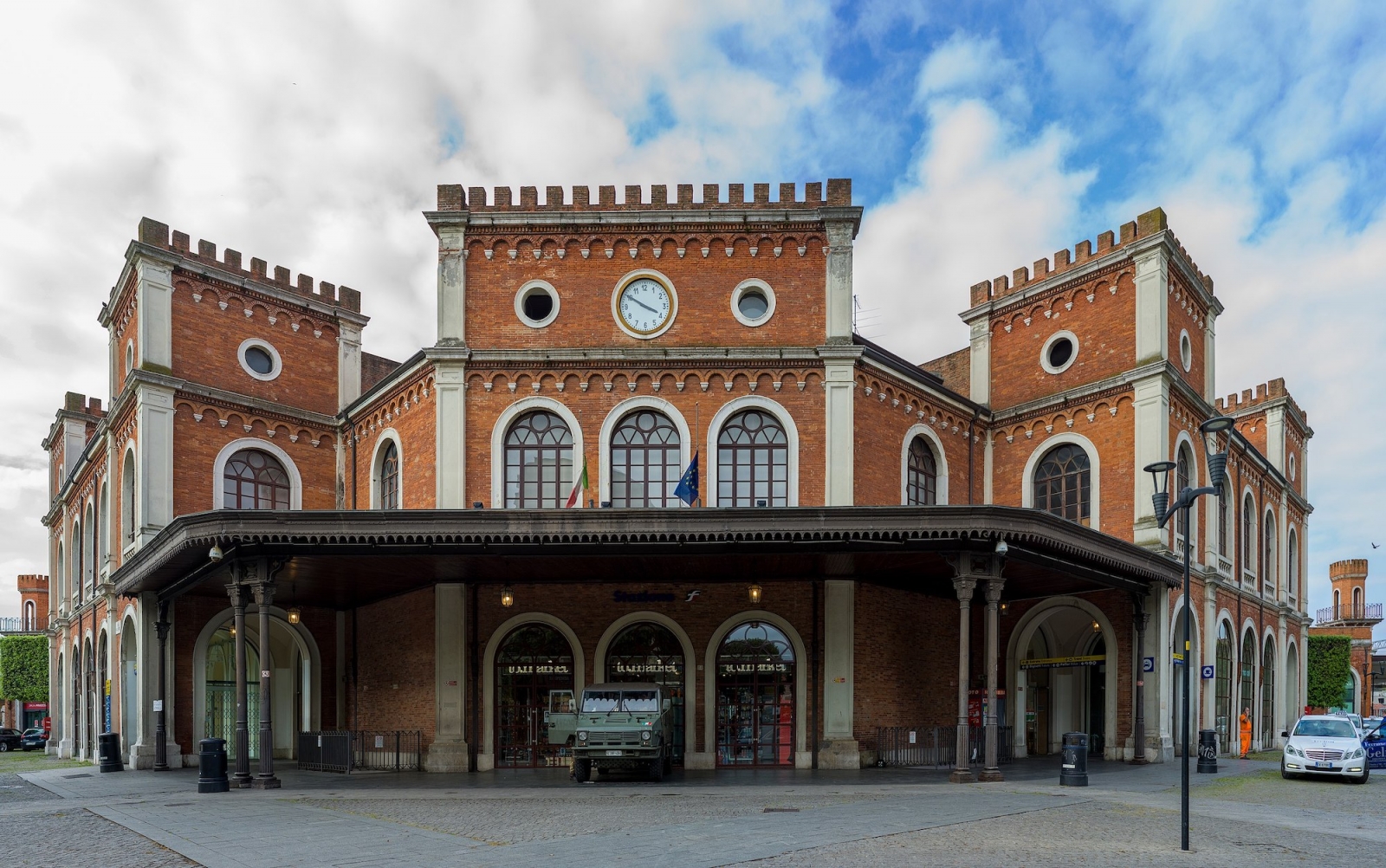
Stazione Ferroviaria centrale di Brescia, also known as Brescia Central Station, is the main railway station serving the city of Brescia, located in the Lombardy region of Italy. The station was first opened in 1854 and has since undergone several renovations and upgrades. Today, it is a modern and well-equipped station that serves both regional and national trains, including high-speed trains like the Frecciarossa and Frecciargento. Brescia Central Station is located in the city center, making it easily accessible to both locals and tourists. In addition to its train services, the station also offers other amenities such as cafes, restaurants, newsstands, and a tourist information office. If you're planning on visiting Brescia or using the station, it's worth noting that there are also several bus and tram lines that connect to the station, making it easy to reach other parts of the city.
A local English-speaking tour guide in Italy can customize your tour to suit your interests and preferences, ensuring you get the most out of your visit to a beautiful city like Brescia. They can also provide insider information and advice, such as when is the best time to visit certain attractions and where to find the best views of the city. All in all, hiring a local private English-speaking tour guide in Brescia is highly recommended for anyone who wants a truly exciting and unforgettable experience in this beautiful city.
Festival of light
The Brescia Castle Festival of Lights is an annual event that takes place every February. It is a celebration of art, culture, and history that attracts both locals and tourists to the Castle.
During the festival, the Castle is lit up with spectacular light shows that highlight the unique architecture and features of the building. The event also includes various exhibitions and performances showcasing the rich cultural heritage of Brescia and its surroundings.
Visitors can explore the Castle and its many rooms and galleries, guided by local experts who can tell you about the history and significance of the site. In addition, there is the opportunity to taste the local cuisine and wine, as well as purchase unique handicrafts and souvenirs made by local artisans.
The Festival of Lights is a must for anyone interested in the history and culture of Brescia. Whether you are a first-time visitor or a seasoned traveler, the festival will provide you with a unique and unforgettable experience that will give you a glimpse into the rich and vibrant heritage of this historic city.
Mille Miglia car race
Mille Miglia is a famous vintage car race that takes place every year in Italy and Brescia is an important part of this event. The race was first held in 1927 and covered a distance of 1,000 miles (hence the name "Mille Miglia") from Brescia to Rome and back. The race continued until 1957 when it was suspended for safety reasons, but was revived in 1977 as a regular race for classic and vintage cars.
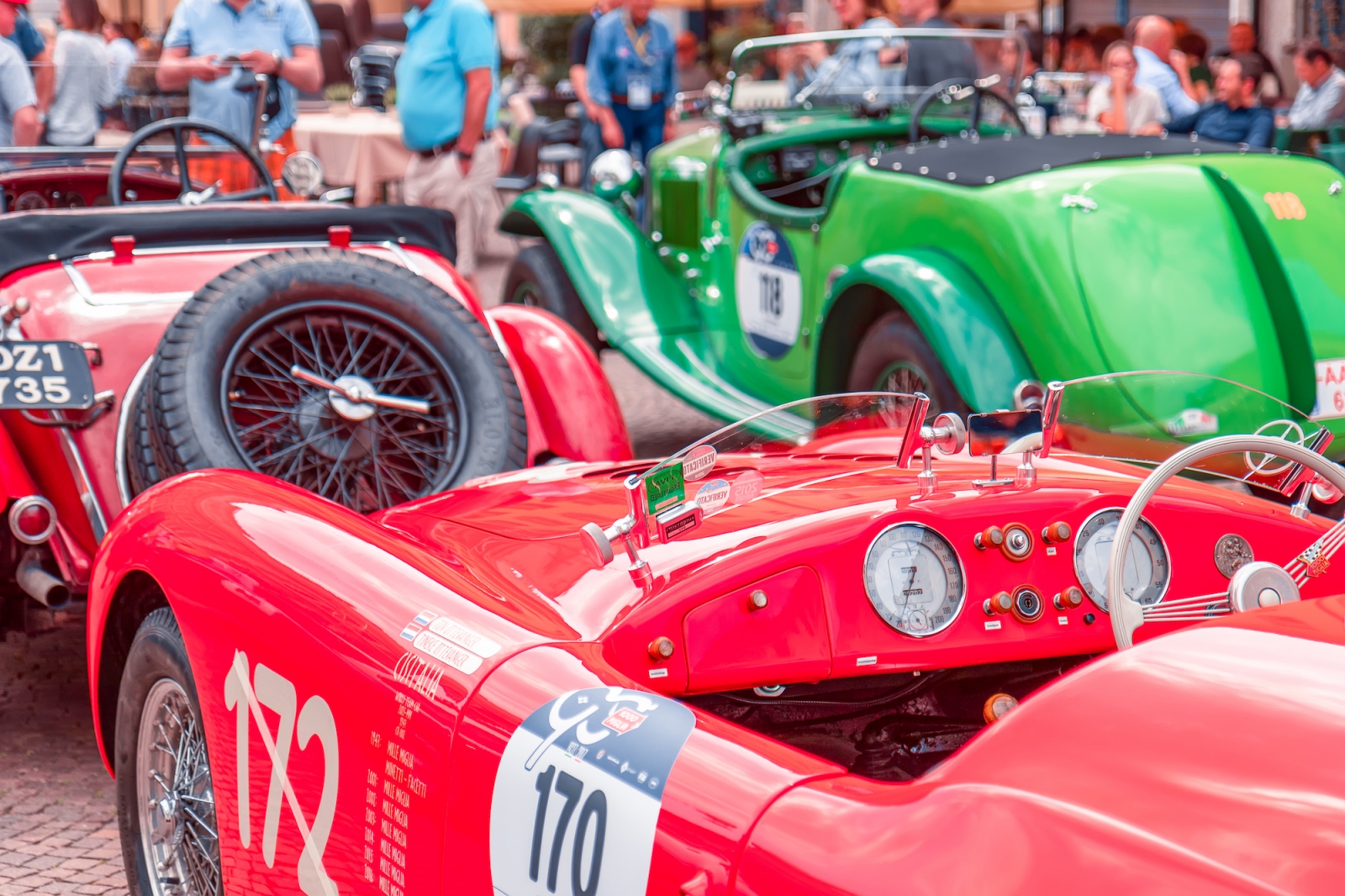
Today Mille Miglia is one of the most prestigious events in the world of classic cars and attracts exhibitors and spectators from all over the world. The event usually takes place in May and usually starts and ends in Brescia. The race route spans over 1,000 miles through the beautiful Italian countryside, passing through historic cities and towns along the way.
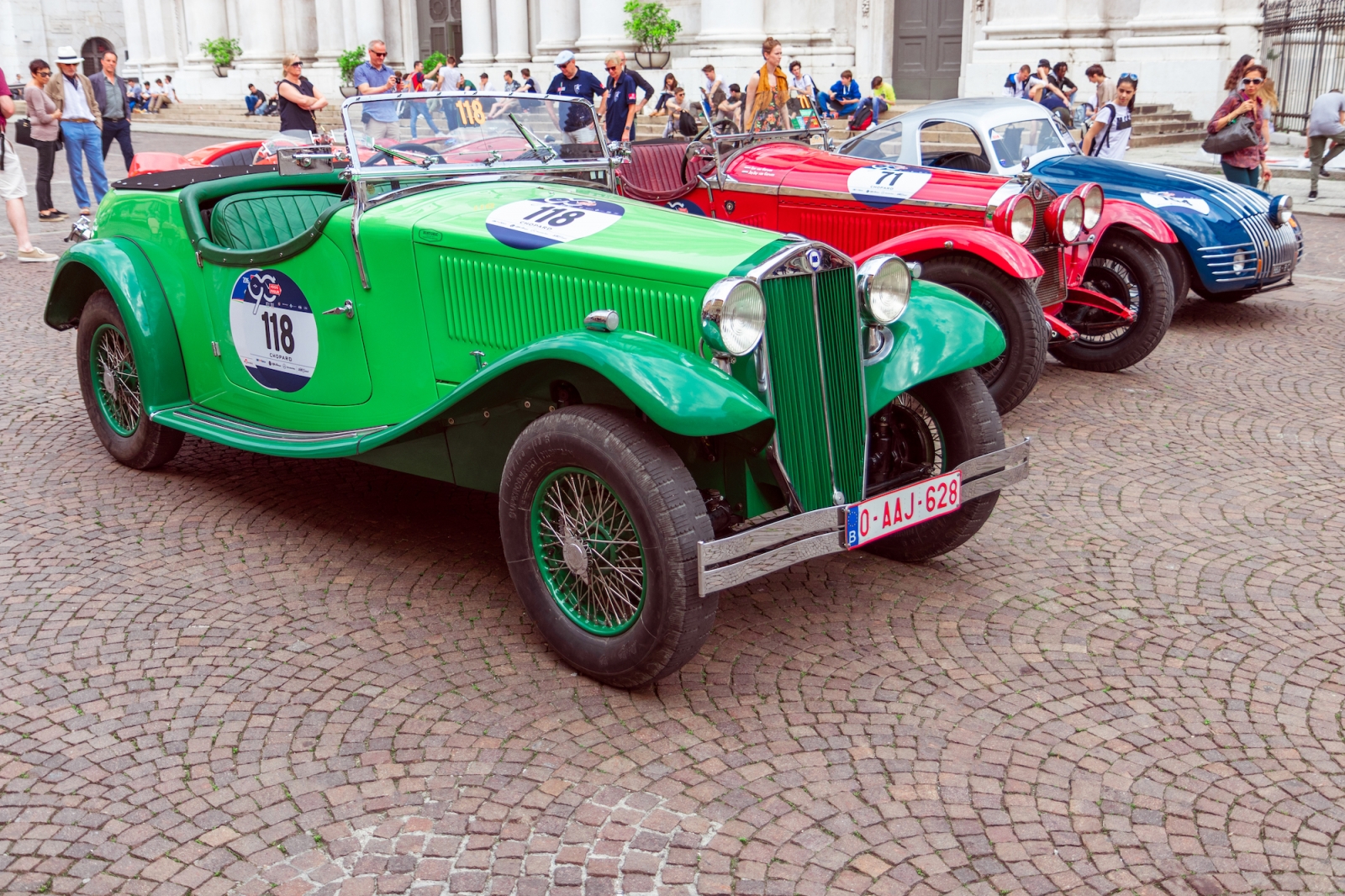
There is a festive atmosphere during the event in Brescia as thousands gather to watch the cars start and finish the race. The streets are filled with spectators cheering for the drivers and the atmosphere is electrifying. In addition to the race itself, there are many other events and activities during the Mille Miglia in Brescia, including car shows, concerts, and parties.
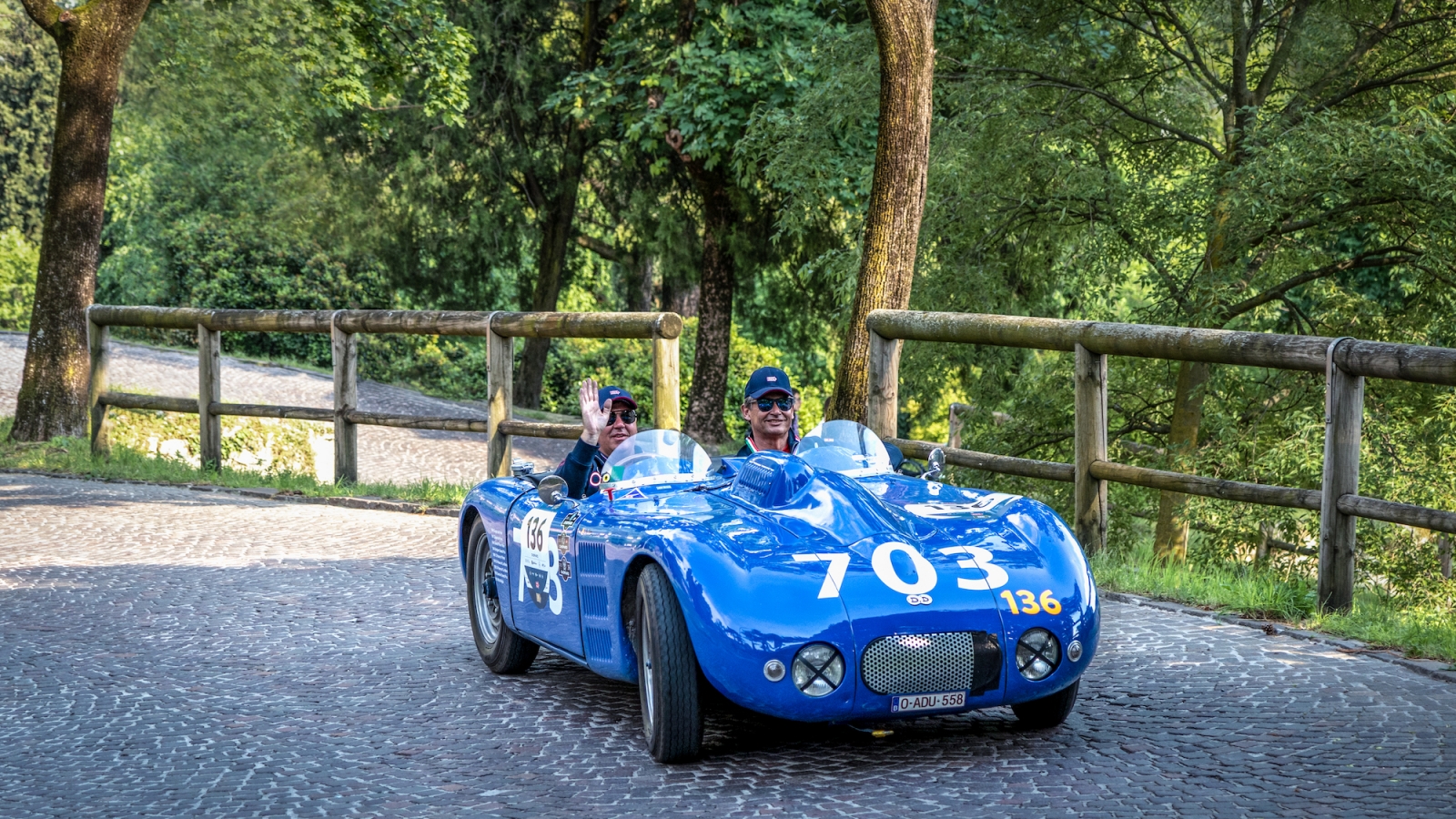
If you're a fan of classic cars or just want a unique and exciting experience in Italy, then the Mille Miglia in Brescia is an event you definitely don't want to miss!
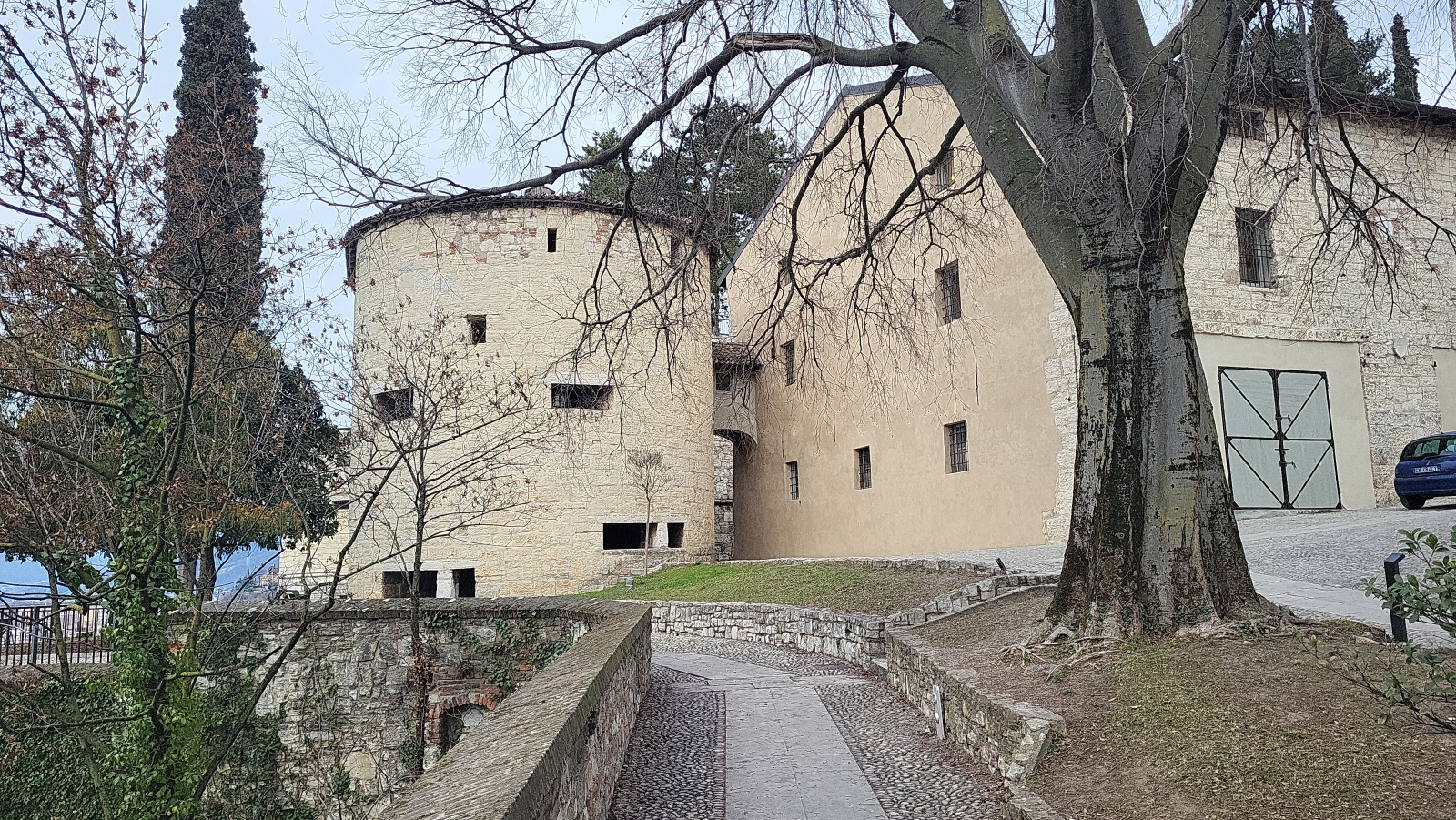
Brescia is a charming city located in the Lombardy region of northern Italy. It boasts a rich history, fascinating culture, and stunning architecture. The historic city center with its winding streets and beautiful squares is listed as a UNESCO World Heritage Site. One of the city's most iconic landmarks is Brescia Castle, which sits atop a hill overlooking the city. Visitors can use the services of local private English-speaking tour guides in Italy to explore the ancient walls and towers of the castle and enjoy panoramic views and visit the surroundings of the city.
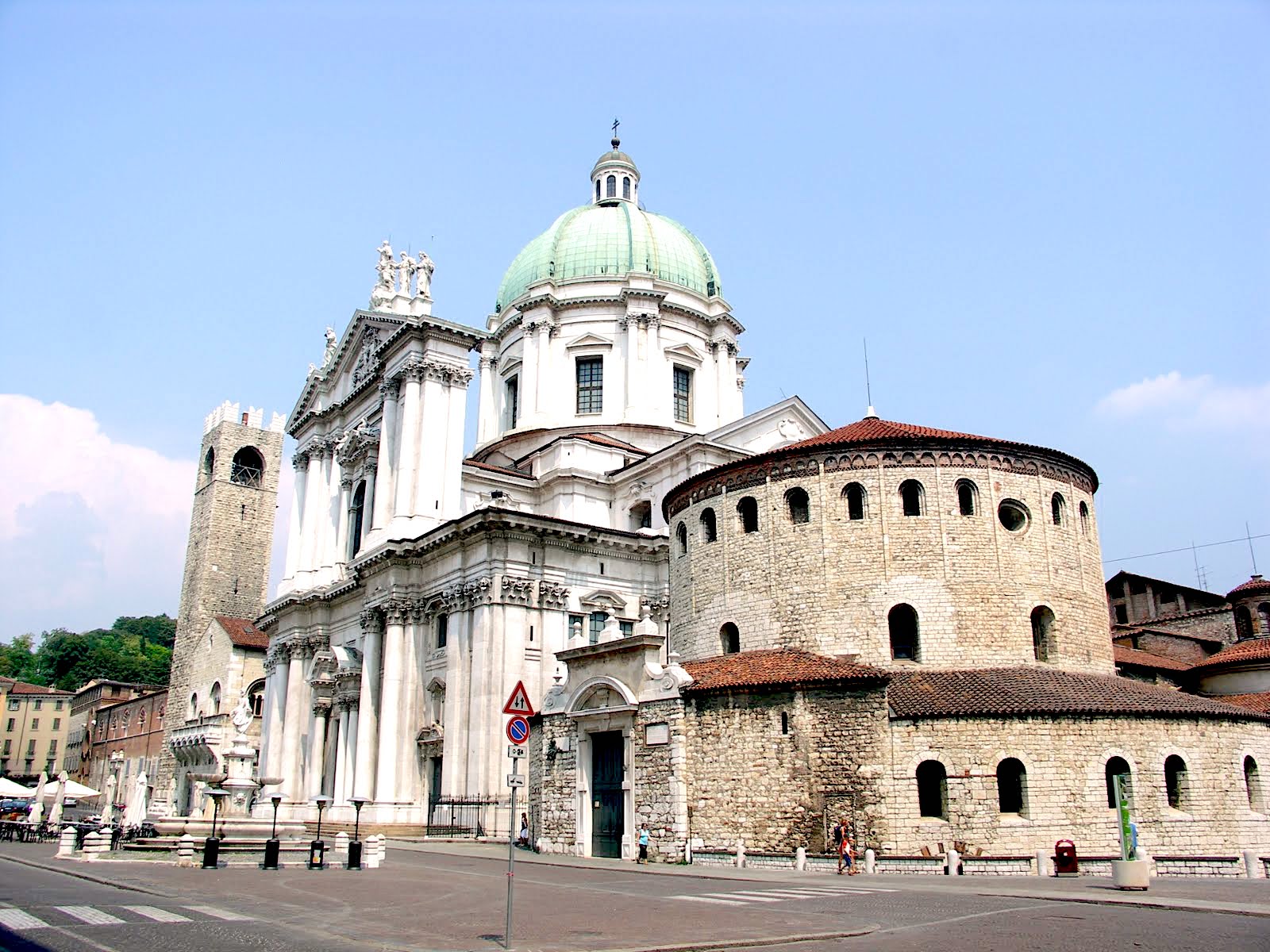
Paul VI Square, also known as Piazza Paolo VI, is a public square located in the historic center of Brescia, a city in northern Italy. The square was named after Pope Paul VI, who was born in Brescia and served as Pope from 1963 to 1978. The square is located in the heart of the city and is surrounded by some of Brescia's most important historic buildings, including the Old Cathedral, the New Cathedral, and the Palazzo della Loggia. The square is also home to a number of shops, cafes, and restaurants, making it a popular destination for locals and tourists alike. One of the most notable features of the square is the statue of Pope Paul VI, which was erected in 2008 to commemorate the 40th anniversary of his election as Pope. The statue, which was created by the Italian artist Franco Assetto, shows Pope Paul VI holding a pastoral staff and extending his hand in blessing. Paul VI Square is a beautiful and historic public space that serves as a testament to the important role that Brescia has played in Italian and Catholic history.
Brescia is also home to several beautiful churches and cathedrals, including the impressive Brescia Cathedral, with intricate frescoes and stunning architecture. Another must-see attraction is the Santa Giulia Museum, which houses a collection of art and artifacts from the Roman era to the present day.
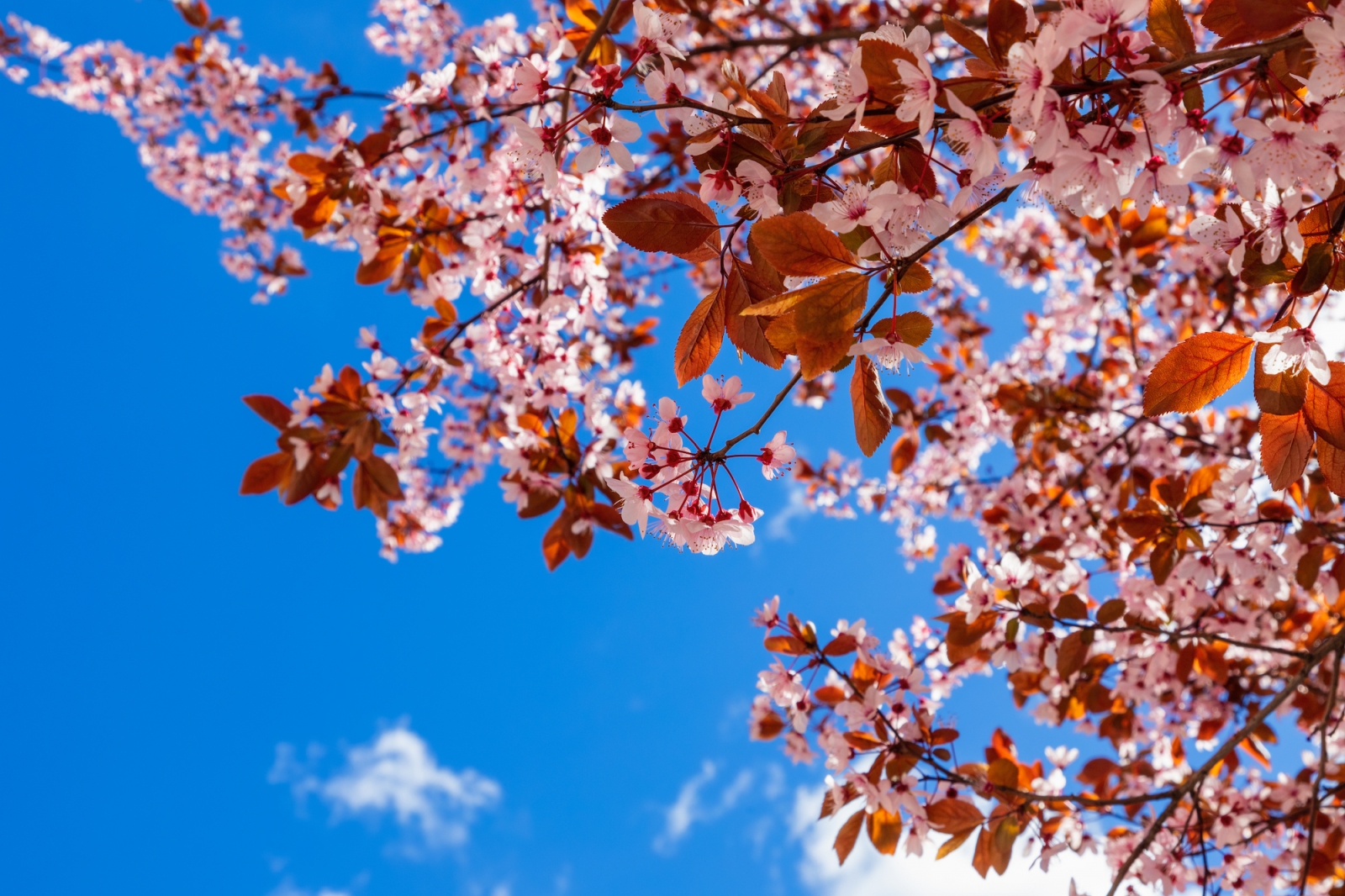
When Prunus × cistena or the purple leaf sand cherry begins to bloom on Giovanni-Lipella street in Brescia, all the local residents and tourists understand that spring has arrived!
Food and wine are also an important part of the Brescia experience. The city is known for its delicious local cuisine, which includes traditional dishes such as casoncelli pasta, polenta and bollito misto. Visitors can sample these delicacies in the city's many restaurants and trattorias, as well as in the lively markets.

Lugana I Frati di Cà dei Frati is born in vineyards located on the southern shore of Lake Garda next to Brescia in Lombardy and is the symbolic wine of the company, which has made it known throughout Italy. It is produced with 100% Turbiana (Trebbiano di Lugana) grapes, a great native grape variety.
All in all, Brescia is a great place for travelers interested in history, culture, and gastronomy. With its beautiful architecture, rich heritage, and delicious food and wine, this city is sure to captivate visitors of all ages.
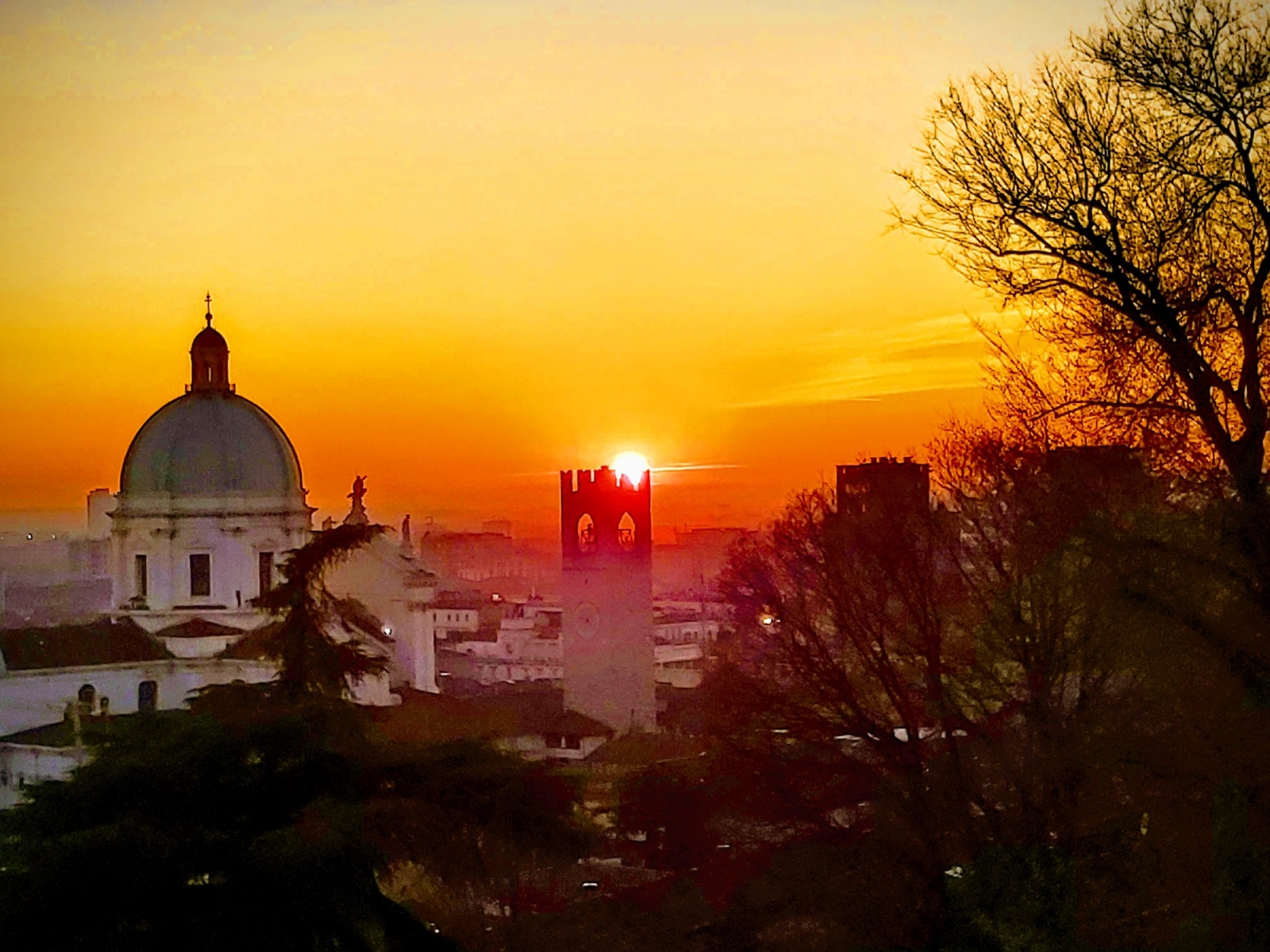
Read our previous article Enigmatic Baalbek: Exploring Lebanon's Ancient Ruins
Read our next article Experience a spectacular blooming spring in Spain









